

7 Popular Sailboats with Two Masts (With Pictures & Prices)
Sailboats can come with one, two, or even more masts. You can also have different-sized masts placed on the front, back, or middle of your vessel.
Below, I have listed popular sailboats that have two masts.
Let’s get started!
Table of Contents
Check also: Average sailboat price examples .
Things to Know About Sailboats With Two Masts
When looking for sailboats with two masts, you should know what you are looking for. A Ketch is one type of sailboat with two masts.
Knowing this term can help you to nail down your search when looking for a boat with two masts.
These boats come in many shapes and sizes as well as many different types of designs. Generally, these types of boats have the taller mast being forward and the smaller mast near the aft.
Yawls are also boats that feature two masts.
These also come in multiple types and designs. The difference between the Ketch and the Yawl is that the Yawl has the larger mast in the aft instead of forward. They also have smaller sails and can be easier to handle.
Another type of sailing ship that features two masts is a Brigantine.
This ship has mixed sailing rigs which commonly features squared sails on the front part of the ship and triangular sails on the back of the ship.
These boats are often larger and require more people to handle them.
7 Great Used Boats with Two Masts
There are many benefits to used boats including a lower cost. You can get a larger boat for a lower cost if you choose to buy used.
When looking at used boats, you need to make sure you look at the boat and its features thoroughly to make sure everything is in great working order.
If you do not feel confident that you can properly look over a used vessel, you can even hire a marine inspector to look it over and let you know of any potential issues or needed repairs. You can use this assessment to decide what is worth it, or if the needed repairs fall into the budget.
It is much more common for a used boat to have more than one mast. This is because the newer sailboat models are creating their new designs with just one mast.
One mast ships are easier to handle and manage so new designs are trying to optimize design and ease of sailing.
Below are great used sailboats with two masts which I have arranged by price .
1. 1976 Westerly Center Cockpit Ketch

This 1976 Westerly Center Cockpit Ketch is a small 36-foot long sailboat with two masts. This is a solidly built cruising vessel that features a center cockpit ketch layout.
This boat has a small 38 horsepower engine perfectly fit to navigate its smaller size.
The interior features 1 single berth and 3 double berths all in 3 cabins. This boat also has 2 full heads onboard.
You also have a full galley with a 4 burner stove, refrigerator and freezer, stainless steel sink, and microwave oven.
This boat makes great use of limited space and offers many amenities in a much smaller frame.
Price: $37,000.00
2. 1978 Jeanneau Gin Fizz

The 1978 Jeanneau Gin Fizz is a trusted and popular two-masted design capable of crossing the Atlantic Ocean .
This boat is also very spacious for a boat that is only 38 feet in length. This model also won an award for “security, comfort, ease of handling, and ability to handle varying conditions.”
This particular used model has been well maintained and upgraded over the years.
This boat is great for family cruising, offshore passages, and even racing.
This boat features a 50 horsepower engine to help navigation.
Inside you can find 2 cabins and 1 head. You will be highly comfortable with air conditioning and other interior luxuries.
Price: $46,000.00
3. 1979 Freedom 40
The Freedom 40 is a classically designed centerboard ketch with two masts. This boat is a great sailor loaded for cruising on the wide-open blue water.
This sailboat is 40 feet in length and features accommodations for six people that include a double-v berth, another double berth, and two single berths.
There is also a full head that can be accessed both from the main salon and aft cabin.
This boat was recently painted and features newer interior fabrics, forced air heating, and much more.
You can find a dinette with separate freezer and refrigeration compartments, a stove with an oven and broiler, a double stainless steel sink, plenty of storage, and other interior features.
This boat also comes with an outboard motor with 50 horsepower and a hard bottom inflatable dinghy.
Price: $54,900.00
4. 1977 Puma 38 Ketch

The Puma 38 Ketch is a two-masted sailboat built for racing like the rest of the Puma sailing line. This brand prides itself on speed and maneuverability.
The 1977 Puma 38 is 34 feet in length with a backup diesel engine that can help you get where you need to go as well as docking into a slip. This motor features more horsepower than the average sailboat with 45 horsepower.
Features on this vessel include autopilot, electrical and manual bilge pumps, a full marine head, running hot water, and refrigerator.
This boat is made of fiberglass with teak finishes and looks well kept. You can find this boat in Spain if you are interested in purchasing it.
Price: $66,099.00
5. 1973 Morgan Out Island 41
Originally designed by Charley Morgan, the Morgan Out Island 41 is a center cockpit shoal-draft cruiser that features two masts.
This larger boat is 41 feet 3 inches in length and features many amenities.
This boat is the tri-cabin version and features interior heating, pressurized hot and cold water, a 2 burner gas oven, and a fridge.
This boat also seats up to 7 in the 3 cabins and the saloon. There are also 2 full heads on this vessel.
This boat is even equipped with an inboard motor . Inboard motors are easier when it comes to navigation including backing up, which is generally hard for sailboats to do.
Price: $68,596.00
6. 1970 Hinckley Bermuda 40

This 1970 Hinckley Bermuda 40 is a gorgeous two-masted boat painted with a mixture of desert sand and oyster white on the exterior and features a beautiful and well-kept deck.
This boat has previously had all her systems replaced and upgraded and features a 40 horsepower engine that was new in 2014.
This boat features a mahogany interior and sleeps up to 6 people in 2 cabins. You can also find a 3 burner propane stove with oven, fridge and compressor, new countertops and plenty of storage.
This boat is a stunning and highly upgraded “must-see” at a very reasonable price.
Price: $129,500.00
7. 1995 Amel Super Maramu

A newer model of sailboat is the 1995 Amel Super Maramu sailboat. This sailboat has two masts and is very long at 53 feet.
This boat features an aft deck, steps molded right into the hull, well-protected cockpit an many other features. This boat has a large 76 horsepower engine which is more than the average sailboat is equipped with.
Inside, this boat features 2 cabins and 2 heads with showers. There is also plenty of storage, air conditioning , and electric heaters. There is also a nice salon and galley with a refrigerator, dishwasher, chest freezer, microwave oven, 3 burner stove, and other appliances.
This boat is great for multiple days out on the water and is new and updated. Because of the year, this was manufactured and the features, this boat has a larger price tag than the previous models.
Price: $299,990.00
Final Thoughts:
Sailboats are a great way to enjoy a day out at sea. Most sailboat models come with sleeping arrangements and even a kitchen. This makes them ideal for trips that will take more than a day.
Having multiple masts allows you to harness the power of the wind better and can increase your speed and directional capabilities.
There are many great choices when it comes to boats with two masts, but newer models are starting to steer away from double mast designs. This does not mean that you cannot get a good boat with two masts.
Used boats can be great choices when it comes to purchasing a boat. This is even more true with large, yacht boats such as the ones listed above.
Just make sure when you buy a used sailboat you check that everything is intact and in good working order and if it is not, you have allotted space in the budget to fix what is needed.
Your new double-masted sailboat should provide you with plenty of long-lasting memories and adventures out on the water while you connect with the wind and the sea.
Click to share...
Yachting Monthly
- Digital edition

Best multihulls: We pick the best two and three hulled yachts
- Rupert Holmes
- June 29, 2022
Rupert Holmes picks the best multihulls for cruising focussing on the most popular and interesting mid-size multihulls from 37-43ft

Few of us can have failed to see the rapid growth of interest in multihulls and this formerly niche sector is now a mainstream part of the new boat market.
Much of the appeal is obvious and is unchanged from the reasons for the popularity of Prout and other catamarans in the 1970s and 1980s, including spacious single-level living spaces offering great views. Today’s boats are also characterised by expansive outdoor seating and entertaining areas. These areas benefit from the near-universal adoption of the same fabric technology that enables motor yachts to leave cockpit cushions outside in all weathers.
Superior space
The full forward cockpit featured on a number of heavier and larger designs may appear to be a gimmick at first sight, yet they are practical in a number of ways. Firstly, a separate area can be ideal when sailing with larger complements of people on board – teenagers for instance may value a separate area. Other popular attributes include the amount of stowage on deck – ideal for those who want to carry a lot of watersports equipment.
In addition to decent cockpit lockers, you can expect to find a pair of deep lockers at the front of the bridge deck, plus further stowage in the bows. On boats above 42ft these areas are often large enough for conversion to single cabins, although it’s worth remembering that putting too much weight forward will compromise performance and the motion of the boat at sea.
Easy handling both under sail and power is an equally important theme. Twin engines make a cat easy to spin in its own length and handling in reverse is as easy as going ahead. This set-up also offers a degree of redundancy – if one engine fails you will often be able to reach port using the other one.
In some cases the nav station in the bridge deck saloon is an ideal place from which to con the boat while on watch in inclement conditions, making these boats as good as a conventional motor sailor in this respect, but with the potential for much better sailing performance. However, some designs lack the all-round visibility to make this feasible.
The International Multihull Show, which takes place in April at La Grande Motte, France, is a must for anyone serious about buying a new or recent boat. Although the show has a compact feel, it’s the only place in the world where dozens of multihulls of the same size can be compared side by side.
The impact of COVID
The British brokers I met at the show were universal about their experience of the UK market, which has changed considerably post Covid.
Their biggest client base for multihulls are now owners with plans for long-distance cruising. The increase in people working from home is also attracting a younger clientele than typical boat buyers, which is helping boost demand to unprecedented levels.
‘We’re seeing a big change in the way people are buying boats and what they’re looking for,’ Graham Laver of Ancasta, Lagoon’s UK agent, told me. ‘Most are not weekend sailors and don’t need a permanent berth – they have a lot more time on their hands.’
A scarcity of suitable berths in parts of the UK is therefore not a hindrance on this part of the market.
The major catamaran builders largely disregarded boats under 40ft for many years; however, there are welcome signs this attitude is changing. The Excess 11, unveiled at the 2020 Düsseldorf boat show, is a 37-footer by a new Groupe Beneteau brand that’s aimed at a younger audience than typical buyers of this value. It’s Excess’ first all-new design – the earlier 12 and 15 were based on the bottom third of Lagoon hulls, although almost everything above the waterline was new.
As with the two older models, there are helm stations aft in each hull, with wheels positioned right above the rudder stocks to produce the most direct feel possible.
The boat also has excellent visibility from the helm and is noticeably better in this respect than most cruising catamarans. Interior accommodation includes a well-proportioned bridge deck, with very generous headroom. There’s space for a decent galley, a full-size internal saloon area and a forward-facing navigation station.
On the downside, it lacks space for the ease of circulation of people seen on some larger boats and will therefore have more of an ‘excuse me’ factor when sailing with a full complement of crew.
Sensibly no attempt has been made to create peninsula beds in the aft cabins, so despite the boat’s relatively modest size both double beds measure a massive 2m by 2m. The huge stowage volumes under the bunks are easily accessed thanks to hinged top panels supported by gas struts, which enables far more of this space to be reached easily than the typical single drawer in the bunk front.
On the three-cabin design the starboard hull is given over to the owner’s suite, which includes a good desk/dressing table area and lots of extra stowage. Perhaps surprisingly, this doesn’t have the feel of living in a narrow tunnel – it’s a wide rectangular area that offers more comfort and practicality than many larger yachts.
Excess is also engaging directly with its client base via the Excess Lab. The online element of this discusses key issues that impact design choices, allowing the boating public to present its views in a way that helps inform development of new models. Recent topics include the balance between draught and windward performance, self-tacking jibs vs genoas, and refrigeration.
Excess 11 specifications
Price: €310,660 ex VAT LOA: 11.42m / 37ft 5in Hull length: 11.33m / 37ft 2in Beam: 6.59m / 21ft 7in Draught: 1.15m / 3ft 9in Displacement: 9,000kg / 19,800lb Builder: excess-catamarans.com
The chances are that if you’ve sailed multihulls of around 40-44ft at least one of them may have been a Lagoon. More than 800 Lagoon 42s have now been delivered, with the model proving equally popular with private and charter owners. It offers lots of space, even by multihull standards, in three- or four-cabin layouts.
Large platforms aft make boarding from a pontoon, quay or tender easy, while the big cockpit has multiple seating areas and plenty of space for easy circulation of people. There’s also a neat lifting system for the dinghy. The boat is sailed from a raised helm position on the port side, which has direct access to the winches. The two-person helm seat is configured to work well both when seated and when standing.
While this ease of sail handling is a key attraction for owners of most cruising- oriented multihulls, a downside of some raised helm stations is they can feel very removed from other people on board.
This can make others on board feel like passengers who are not fully involved in the sailing. Unlike a number of boats of this size, there’s no forward cockpit, but there is foredeck space for sunbeds that forms a separate area for socialising.
Interior bridge deck accommodation includes a decent galley to starboard, plus a generous forward saloon. This has a great view forward and to the sides, although vision is obstructed on both quarters, which limits the usefulness of the forward chart table as a place from which to con the boat when on watch in bad weather.
Even by the today’s standard of catamaran, accommodation in the hulls is very generous. The boat at La Grande Motte had the classic four-cabin, four-bathroom charter layout. Both aft cabins rival those of the owner’s cabin of many 50ft monohulls thanks to big peninsula beds and plentiful stowage. These are also airy and very well lit spaces, with an overhead hatch, big hull window and wide stern window.
Lagoon 42 specifications
Price: €426,600 ex VAT LOA: 12.80m / 42ft 0in Beam: 7.7m / 25ft 3in Draught: 1.25m / 4ft 1in Displacement: 12,100kg / 26,700lb Builder: cata-lagoon.com
The Neel range of trimarans is one of the most eye-catching of modern multihulls. The basic philosophy is hugely appealing – use performance trimaran hull shapes to create a platform for a spacious cruiser, while keeping the boat as simple as possible. Weight is also minimised, but in a practical way that doesn’t resort to eye- wateringly expensive high tech solutions.
I sailed one of the first 43s from La Rochelle last summer and found it a surprisingly rewarding boat to sail, with a feel on the helm akin to that of a monohull, yet it was significantly faster. On a reach in 14 knots of true wind we made a very relaxed 10 knots of boat speed reaching under only mainsail and jib. When the breeze picked up to 16-17 knots we were hitting a consistent, but relaxed, 11.5 knots at a true wind angle of 115º with an asymmetric spinnaker set.
Heel angles are greater than for a catamaran, as lifting the windward ama out of the water is an enormous help in reducing wetted surface area. However, monohull sailors will find the heel very modest and once it reaches 12-14º the boat is rock steady, even in gusts.
The amas of the 43 are too small for accommodation, so this boat has a largely open-plan layout, although the owner’s cabin is in a separate area to starboard on the bridge deck. There’s also a double berth to port that would make an ideal den area for kids, plus a further small double cabin forward at a lower level in the main hull.
A key feature of all Neels is a separate engine room and technical area below the saloon in the main hull, which is ideal for maintenance and fault-finding.
These are often thought to be expensive boats, yet the 43 is priced at a similar level to many other multihulls of this size. It’s perhaps no surprise they are leaving the factory at the rate of one a fortnight.
Neel 43 specifications
Price: €359,000 ex VAT LOA: 12.9m / 42ft 4in Beam: 7.4m / 24ft 3in Draught: 1.5m / 4ft 11in Displacement: 9,000kg / 19,800lb Builder: neel-trimarans.com
Nautitech open 40
This innovative boat set new standards when it was first launched and was a key influence in establishing the DNA of the open concept, with a big indoor/outdoor area aft under a hard top, combined with a smaller saloon forward. The effect is to create a huge outdoor living space that provides shelter from the elements – whether intense sun or rain.
Today’s version still has the original hull shape, marrying this with an updated and restyled deck, plus improved interior design. Twin aft helm stations that provide excellent visibility by multihull standards are also an important element. They also enable easy contact with the rest of the crew while you’re steering and there’s little barrier to stop them pitching in to help with deck work. This is therefore a sailors’ boat, with relatively narrow, easily driven hulls, high bridge deck clearance and deep rudders, even though it has fixed keels and not daggerboards.
Of course the nature of this boat means there’s less space for fully enclosed bridge deck accommodation. Nevertheless, it has a decent galley and in cold weather you can retreat into a cosy forward saloon, which has space for four to six people, plus an optional full-size drop-down dining table that makes a huge day bed. With an almost unobstructed 360° view, this also makes a good spot from which to con the boat in poor weather.
There’s a spacious and bright owner’s cabin in the port hull with a large double bed plus a dressing table/desk area. The starboard hull has a large double cabin aft and smaller one forward, which share a well appointed mid-ships toilet and shower. On some boats fitted out for long-term cruising the forward starboard cabin has been configured as office and/or workshop space.
Other boats in the range include a new 44 Open, which is based on similar principles, but has space for an impressively large galley and more volume in the hulls.
It also has numerous small improvements, including moving the mainsheet traveller from the hard top to the aft beam, which gives more precise sail control.
Nautitech open 40 specifications
Price: £404,795 ex VAT (sail away price) LOA: 11.98m / 39ft 4in Beam: 6.91m / 22ft 8in Draught: 1.35m / 4ft 5 in Displacement: 8,500kg / 18,700lb Builder: nautitechcatamarans.com
Marsaudon composites orc 42
A criticism often levelled at catamarans is that they lack feel on the helm and therefore aren’t fun to sail, but that’s not universally true. Lightweight boats with easily drivenhull shapes can be both quick and rewarding, with little of the noisy turbulence at the transoms and lack of pointing ability that can be associated with overweight models with grand accommodation and inefficient shallow keels.
This is the smallest in a range of three performance catamarans and was originally named the TS42. All three boats have direct tiller steering, combined with comfortable helm seats. They provide a great view of the sail trim, though the coachroof partially obstructs the view to leeward.
Despite offering 20-knot performance and the ability to cross the Atlantic in only 10 days, these boats also have lots of interior space. The 42, for instance, has a big bridge deck saloon, with a surprising large galley, plus an excellent forward-facing navigation station. When the weather dictates, this area is enclosed from the outer cockpit by canvas screens, thereby avoiding the need for heavy sliding doors. Equally, there are no moulded headlinings, though the deckhead can be faired to create a high-gloss finish that doesn’t add weight.
Both aft cabins have big double berths, while further forward the layout is flexible – owners can choose from additional double or Pullman style bunks, extra stowage, or extra-large heads and shower areas.
On the downside, these boats are built in small numbers on a semi-custom basis and lightweight construction, decent sails and quality deck gear are all expensive.
Marsaudon composites orc 42 specifications
Price: €520,000 ex VAT LOA: 13.05m / 42ft 9in Beam: 7.42m / 24ft 4in Draught: (fixed keel version) 1.5m / 4ft 11in Displacement: 6,400kg / 14,100lb Builder: marsaudon-composites.com
Fountaine-Pajot ISLA 40
Although launched last year, this model started life as the Lucia in 2016. However, it benefits from updates including a revised helm station that increases stowage – a move welcomed by many potential buyers looking at a boat for long-term cruising.
It’s raised up on the starboard side, with the wheel next to the halyard and sheet winches, making sail handling a simple matter when on watch alone. Steps up from the helm station give access to the hardtop for handling the mainsail, but there’s no option on this model for sunbeds up there.
There’s a large cockpit aft under the hardtop, with a substantial table on the port side. The foredeck has provision for sunbeds, but not a full forward cockpit. Stowage on deck is more restricted than on Fountaine-Pajot’s larger Astrea 42, but still far exceeds what’s available on most monohulls and includes two big bridge deck lockers, plus further space in the bows of each hull.
Bridgedeck accommodation includes a surprisingly large internal saloon, although this is achieved at the expense of a separate navigation station. The example at the show was a four-cabin, four head boat, but without separate shower stalls. Even so, to achieve this on a 40-footer is an impressive feat.
Both aft cabins have large peninsula beds, although floor space and stowage are reduced in size to give space for the two heads in each hull. Forward cabins have a double bed that tapers significantly at its forward end, but these are still far larger than the triangular forecabin vee berth of many monohulls.
Fountaine-Pajot ISLA 40 specifications
Price: POA LOA: 11.93m / 39ft 2in Beam: 6.63m / 21ft 7in Draught: 1.21m / 4ft 0in Displacement: 9,500kg / 20,900lb Builder: catamarans-fountaine-pajot.com
This 2020 design is another model that’s extremely popular in charter fleets. However, they are also sought after by private buyers and the numbers in the hands of individual owners will of course swell dramatically when they are sold on from charter operators.
As soon as you step on board this cat, it feels like a big boat for its size, with plenty of options for easy circulation of people. There’s arguably more separation between interior and exterior spaces than on many catamarans.
However, the Leopard 42 has a feature that few others offer in this size range. A full height door in the front of the saloon gives direct access to the large forward cockpit, which opens up the accommodation in a different way to most. This is also a semi-flybridge model, with an additional seating area on the hardtop that’s intended for use in port and at anchor.
A huge and very well appointed galley takes up almost half the saloon area and there’s further space under the floor to stow a considerable amount of dry supplies. There’s also a very good forward-facing navigation station/desk, although the internal seating area is relatively small.
The models that feature a three-cabin layout have a very impressive owner’s suite, which includes a large desk/dressing table, plenty of generous stowage and expansive floor space.
The other hull houses two double cabins, each with its own en suite and separate shower stalls. However, the downside of this arrangement is that there’s less scope to provide generous easily accessed stowage in these cabins.
Leopard 42 specifications
Price: POA LOA: 12.67m / 41ft 7in Beam: 7.04m / 23ft 1in Draught: 1.4m / 4ft 7in Displacement: 12,467kg / 27,485lb Builder: leopard catamarans.co.uk
This French yard set a standard by which all multihulls have subsequently been judged when it launched the Bali 4.3 Loft. It blends indoor and outdoor areas into a single vast space that can be closed off with the garage door-style aft bulkhead.
Since then the format has been greatly refined and the 4.2 offers impressively spacious layouts in both charter and owners’ formats. There’s also a full-size door to a spacious forward cockpit, with sunbeds extending the entire length of the solid foredeck.
Bali 4.2 specifications
Price: €424,780 ex VAT LOA: 12.84m / 42ft 1in Beam: 7.07m / 23ft 2in Draught: 1.22m / 4ft 0in Light displacement: 11,400kg / 23,100lb Builder: bali-catamarans.com
Aventura 37
This 20-year-old French-run but Tunisian-based company is one of the few that has actively addressed the market for smaller catamarans. The 37 is a semi-flybridge design with a big aft cockpit. It was launched a few years ago and is aimed at cruisers who want a spacious boat in a relatively compact package.
Nevertheless a key design criteria was an ability to sail at 7 knots in only 10 knots of true wind. The spacious accommodation includes lots of stowage, which includes a small walk-in wardrobe in the owner’s suite on three-cabin boats.
Aventura 37 specifications
Price: €237,500 ex VAT LOA: 10.9m / 35ft 9in Beam: 5.94m / 19ft 6in Draught: 1.2m / 4ft 0in Displacement: 7,900kg / 17,400lb Builder: aventura-catamarans.com
Enjoyed reading this?
A subscription to Yachting Monthly magazine costs around 40% less than the cover price .
Print and digital editions are available through Magazines Direct – where you can also find the latest deals .
YM is packed with information to help you get the most from your time on the water.
- Take your seamanship to the next level with tips, advice and skills from our experts
- Impartial in-depth reviews of the latest yachts and equipment
- Cruising guides to help you reach those dream destinations
Follow us on Facebook , Twitter and Instagram.

What’s a Boat with Two Masts Called: Two masted sailing boat types
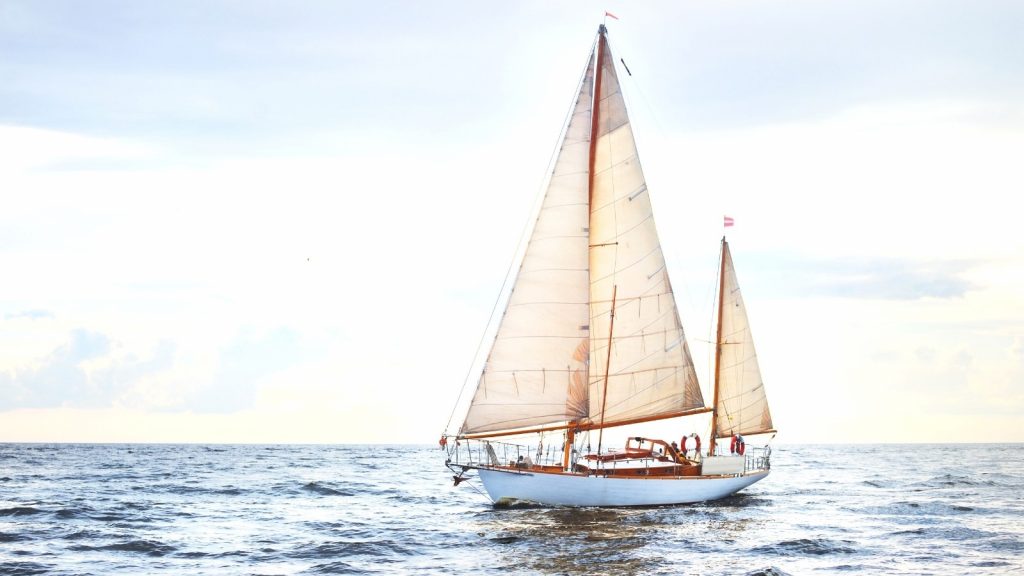
Two-masted sailing boats will always have a special place in the hearts of many sailors. Many sailors consider two-masted sailing boats to be the most attractive and graceful of all sailing vessels. They have an obvious elegance, but what do you know about these two masted sailboats? Let’s find out!
Among the most important aspects are the fact that two-masted sailing boats offer greater sail balance, engineless sailing and more heavy weather options.
Even if the two masted sailboats are not so common, the sailing world has a few of them and what is more, they represent a proof of the evolution and improvement of sailing boats over time. There are an almost endless number of ways sailors have arranged their sails on boats over the years.

Two-masted sailing boats are classified according to the size and position of their masts.
There are different two-masted sailing boat types and two of the most popular are schooners and yawls.
The origins of schooner-rigged vessels are unknown, however there is evidence of them in paintings by Dutch maritime painters dating back to the early 17th century.
Schooners were developed by Northern European countries, while yawls are believed to be descended from the fishing boats of England.
Sailboats with two masts include yawls, ketches, schooners and brigs (known as brigantines). Yawls and ketches are both types of sloops, which means they have one mast, but the difference between them is that the yawl has a second mast stepped at the bow.
Ketches and Yawls have a lower mast, unlike schooners that have a taller aft mast, which is also known as mizzen. Ketch sailing boats have something specific: the aft mast is located in front of the rudder post.
The yawl’s mizzenmast serves as a counterbalance for the jib sails, so that it doesn’t have to be hung from the forestay (the rope running from the top of the mast down to the deck). They’re usually smaller than ketches and have less rigging because they don’t carry as many sails as a sloop with two masts.
Yawls are faster sailboats than schooners because they’re lighter, more balanced and easier to sail upwind. They can also go faster because their shorter sails catch more wind. But schooners have larger payloads, which means more people or cargo — an important consideration for long trips without resupply.

Schooners are two-masted sailing boats, but instead of having a jib sail like yawls, ketches and most sloops, schooners have a fore-and-aft spanker sail like a gaff sailboat. These two-masted sailboats have at least two masts, the foremast being slightly shorter than the main mast.
Schooners are larger than yawls, ketches and other sloops and weren’t used very much in modern times because they were more difficult to handle. They’re still used in racing competitions today.
Schooners have a longer bow portion than yawls. The mainsail is aft of the mast, and either one or two foresails are in front of it. In a schooner, these are triangular sails; in a yawl, they’re trapezoidal. Yawls have bowsprits — poles that extend beyond the bow for the jib and stay sail to be attached. Schooners have small bowsprits that can support jibs but not large sails.

The term ketch derives from the word catch, which hints to how it got its name in the 17th century. Ketches were initially intended to meet the specific requirements of offshore net fishing.
Ketch is a type of sailboat that features two masts and two sails, commonly used as a racing and cruising boat. The mainmast of this two-masted sailboat is typically taller than the mizzen mast (aft-mast). Its name derives from catch.
Taller masts allow you to use larger sails, so ketch boats are able to achieve better speeds than similar boats with only one mast. Some ketch designs feature a gaff rig, which is similar to a yawl, while others feature a yawl rig, which looks like a traditional sloop.
Ketch boats may look easy to sail but the slightest mistake can lead to disaster. You must be careful when operating this type of boat because it does not have as much stability as other boats, especially when you’re manoeuvring in tight quarters or windy conditions.
A ketch may also be a small recreational boat with only one head-sail in use. Many modern designs have moved away from sail altogether and are powered by engine, while others use both sails as well as engines depending on circumstance.

The brigantine was once a tiny ship that carried both oars and sails. It was a favorite of Mediterranean pirates.
A brigantine is a square-rigged sailing boat with two masts, with a fully square-rigged foremast and two sails on the mainmast.
The mainmast is stepped forward of the deck, making it possible to sail into the wind using a triangular headsail known as a jib. The brig’s foremast is shorter than the mainmast.
The name of this type of boat with 2 masts is derived from the Italian word “brigantino”, which means brigand.
Also, this two-masted sailing boat type was most commonly used for coastal trade and pirate hunting. The brigantine had an advantage over other ships of the time because it could sail against the wind using both sails, making it easier to travel against strong winds.
Faster and easier to manoeuvre than a sloop or schooner, it was used for piracy and espionage.

FAQ: Two-Masted Sailboats
What do you call a two-masted sailboat.
Two-masted sailboats are of several types: yawls, schooners, ketches or brigantines.
Why do some sailboats have two masts?
The vast majority of sailboats feature a mainsail and a jib. These two-masted sailboats provide several advantages in terms of speed and maneuverability. These two masts may be configured in a variety of ways.
The foresail directs air beyond the back of the mainsail, generating greater power from the wind. In order to help menouvering, the foresail can be backed. So, adding sails makes things simpler for bigger boats, making them easier to handle in heavy winds.
What is the difference between a ketch and a yawl sailboat?
Because they are lighter, more balanced, and easier to sail upwind, yawls are faster sailboats than schooners. They can also go at a faster speed since their shorter sails collect more wind. Schooners, on the other hand, have higher cargoes, which means more people or freight – a crucial consideration for extended journeys without replenishing.
What is a one masted sailboat?
It's a sailing boat having a single mast roughly one-third the length's aft of the bow. A sailboat with a single mast usually has one headsail in front of the mast and one mainsail behind the mast.
What is a two-masted square rigger?
It's a brig with two square-rigged masts. A gaff-rigged fore-and-aft sail also called a "mizzen" is used in addition to jibs and staysails (stays'ls) before the foremast and staysails between the masts.
Leave a Comment Cancel Reply
Your email address will not be published. Required fields are marked *

26’ FRANCES. A small double-ended cruiser.
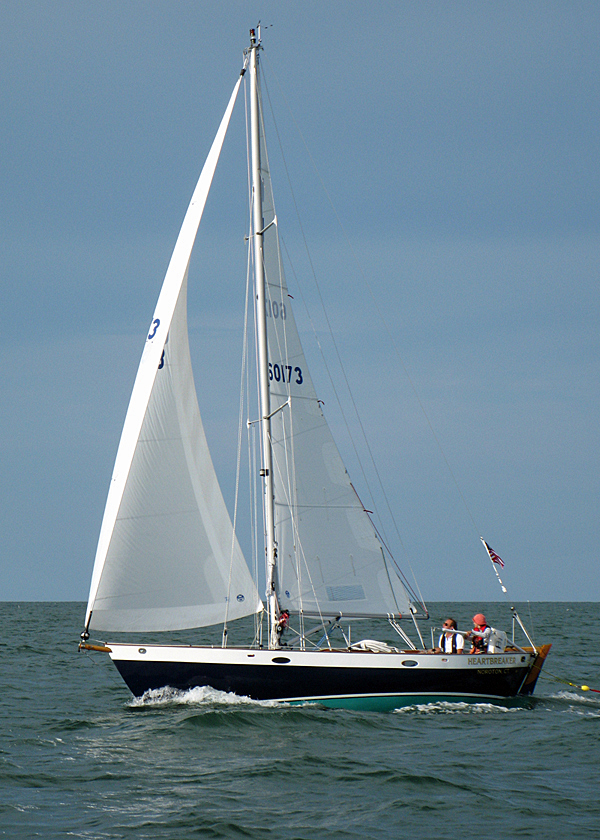
HULL NUMBER 1 of the Frances design, built by Tom Morris in 1975. It had a custom tall, double spreader sailplan, no pulpits, and beautiful sails, for racing.
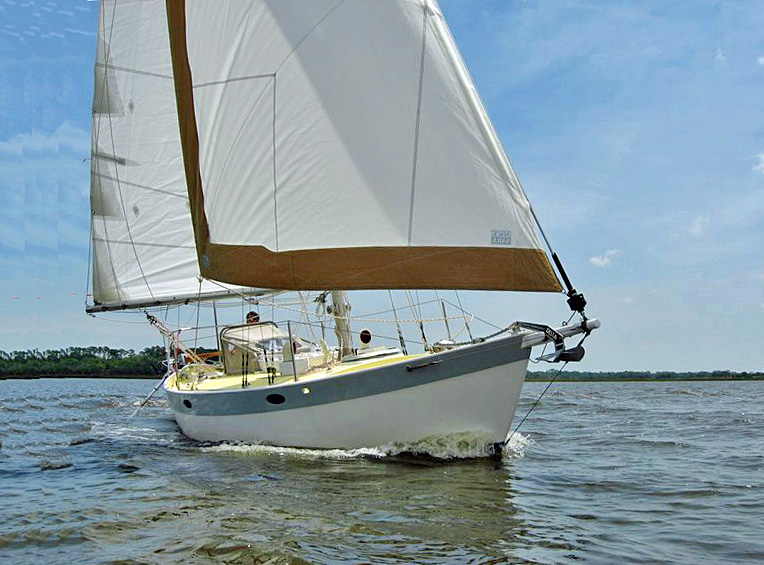
LALUZ. A flush decked Frances that has sailed more than halfway around the world.
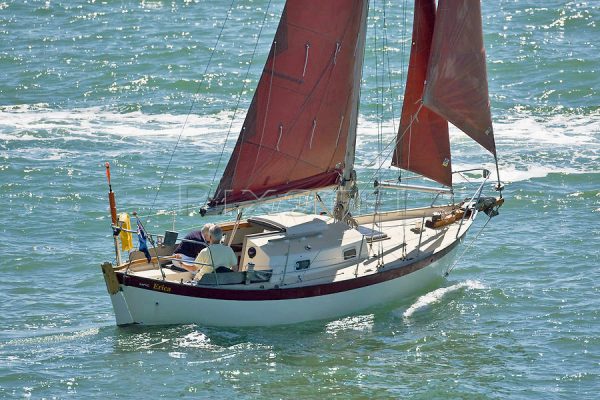
ONE OF THE British cutters, She has the more conservative, shorter mast and two jibs of short hoist. Her tidy rig would be the better choice for longer, further offshore voyaging.
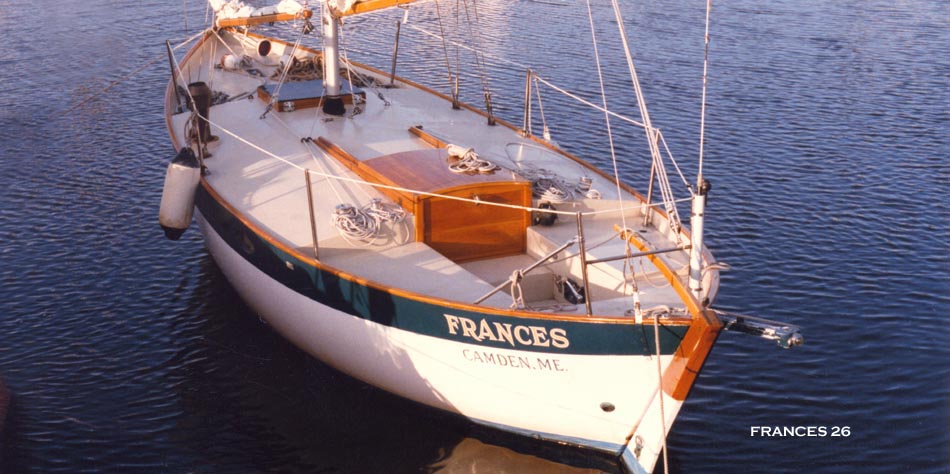
The second FRANCES was fractional sloop rigged with a self-tending jib. The first few FRANCESes were flush decked like this. When a short house was added with full headroom (if one was less than six feet tall), and more efficient sailplans were designed, interest in the boat blossomed. Before all was said and done, more than 200 yachts were built to this design.
ORIGINAL FRANCES DIMENSIONS
LOA: 25′ 10″
LWL: 21′ 3″
BEAM: 8′ 4″
DRAFT: 3’ 10″ (NOW 4′-1″)
DISPLACEMENT, as built: 6,800 lbs Full load 7300 lbs (approx)
BALLAST (lead): 3,500 lbs
SAIL AREA (100% foretriangle): 317 to 340 sq ft (varies)
DISPL/L RATIO: 316 – 330 (varies)
SAIL AREA/DISP RATIO: 14.5 to 15.6 (varies)
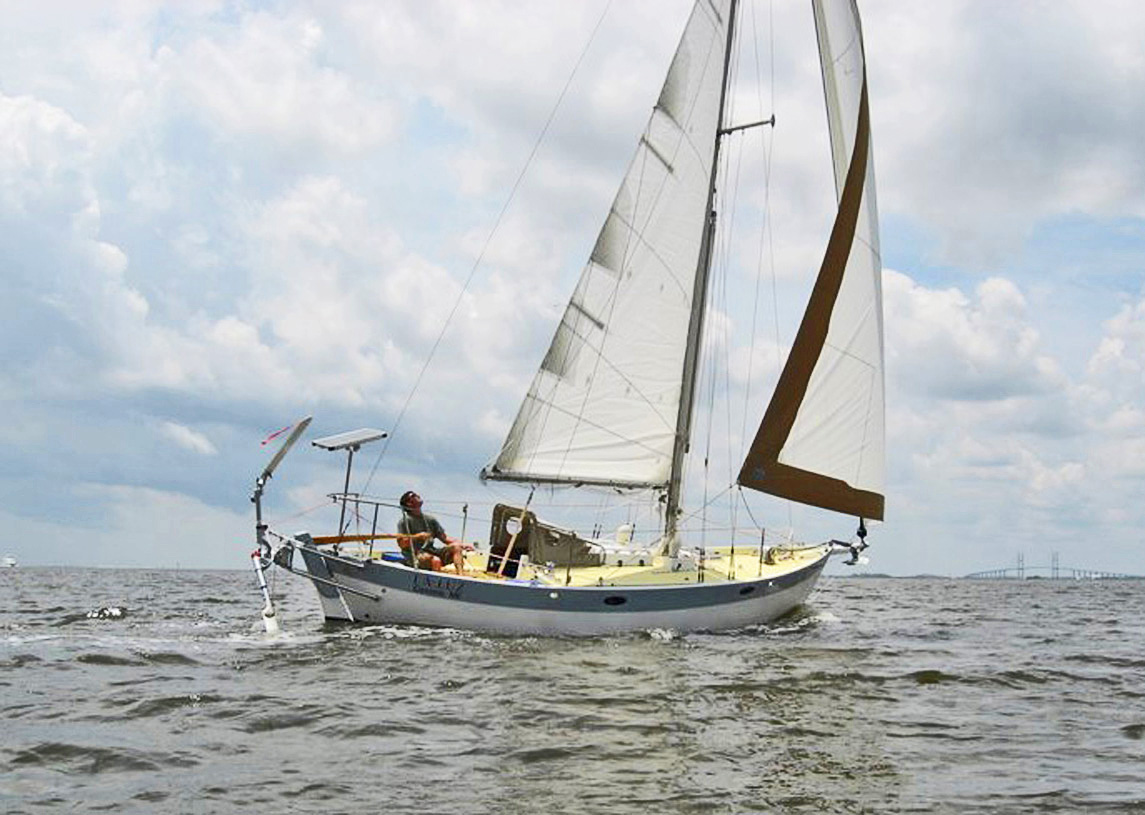
LA LUZ cruising in the tropics. She sailed from Maine to New Zealand.
The FRANCES is one of recent history’s most admired small cruising designs. Well over 200 of the small yachts are now sailing, and they are well loved wherever they voyage. I decided to design this small but capable cruising boat in 1974. My own boat was flush-decked, and I cruised it from Maine to Rhode Island. Another (LA LUZ) is halfway through a circumnavigation. A third (YANLI) has sailed from England to Australia and then to Hawaii and back to Australia. Many of the sisterships added a small house for full headroom, and a variety of sailplans have been fitted.
FRANCES es were built in fiberglass by Morris Yachts in America and Victoria Marine in the U.K. Quite a few fine examples were custom built from our plans of cold-moulded wood using the WEST system.
And now, in her dotage, new aspirants are restoring these fine old boats for their own adventures. Sailing the open ocean in such a small boat is borderline foolhardy- though many have successfully crossed oceans. But if you are aware of the discomforts of facing a storm at sea in something of this size, and are aware of the many advantages of a small, manually handleable yacht, the Frances is one of the better alternatives.

The lines of the original FRANCES.
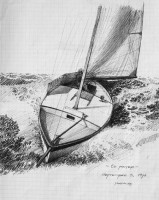
A preliminary sketch for the first FRANCES .
I often ponder what it might be about the FRANCES design that makes it so popular. I think it must be the aesthetics first and foremost. But the real surprise is how well it sails. Nearly half of her weight is ballast, and it is made of lead. So despite her shallow draft she is reasonably stable and surprisingly fast. Of the various rigs the ones with larger headsails and smaller mainsails proved to be the faster and more weatherly, at the expense of more work trimming, of course. Some of the earlier sailplans were frankly overcanvassed, and a new sailplan, designed in 2020, offers more drive with less heeling,
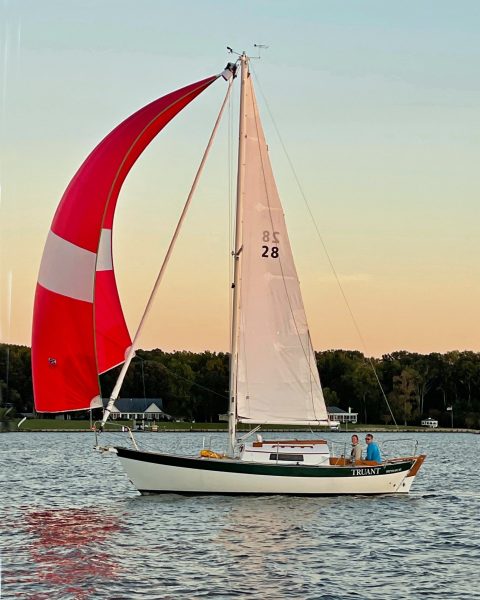
YOU COULD add a spinnaker, and then you could race her. With a shallow keel and a lot of wetted surface, racing the short-rigged Frances is an exercise in futility. But it’s colorful and if there’s not a lot of windward work, you might just possibly collect silverware.
In the last year I have been contacted by three Frances owners who want to improve their 45-year-old boats, and one who intends to build a new one. The biggest improvement among many small ones is to fit a carbon fiber mast and a new sailplan. This new rig falls about halfway between the old short and tall rigs. It specifies a roller-furler for the jib and a genoa, and a solid vang for the boom, plus a deployable Spectra inner forestay and Solent jib for windier conditions. If you own an old Frances and want to improve it, or can buy one for a reasonable price but are realistic about the significant cost to bring it up to date, contact the designer and invest in a new rig and sails that will significantly improve your boat’s performance, and leave the political craziness and economic uncertainty of life ashore behind.
The original FRANCES hull is pared away in width below the points where the cabin sole needs width and the fairing radius between keel and hull is tight. This is a shape without a lot of form stability, so the FRANCES compensated with an unusually low center of gravity thanks to 3500 pounds of lead ballast.
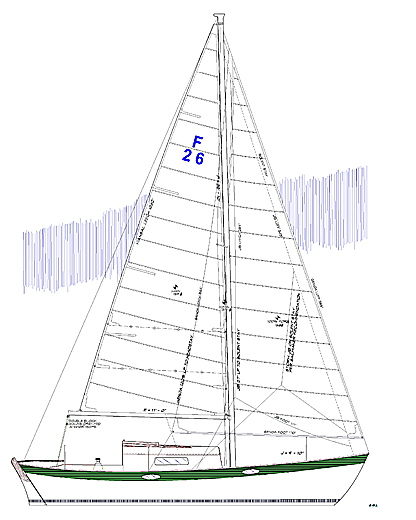
THE NEWEST SAILPLAN. It uses a carbon fiber mast and simplified rigging with sweptback spreaders, a single aft lower shroud, and larger diameter stainless steel rigging. The offshore or inshore mission of each boat can be addressed by the amount of overlap of the genoa. This particular boat’s owner anticipates heading off on an immediate ocean crossing, so the genoa is of modest overlap and a deployable Spectra stay and Solent jib are available for heavy weather.
I adored my little FRANCES . She was beautiful, well mannered, stable enough, and just plain fun. Her sleek lines cut through resistance like a dreadnaught. Point FRANCES toward a destination and she was unstoppable. Her timeless virtues seem to have disappeared from the modern world. They just don’t build ’em like FRANCES anymore.
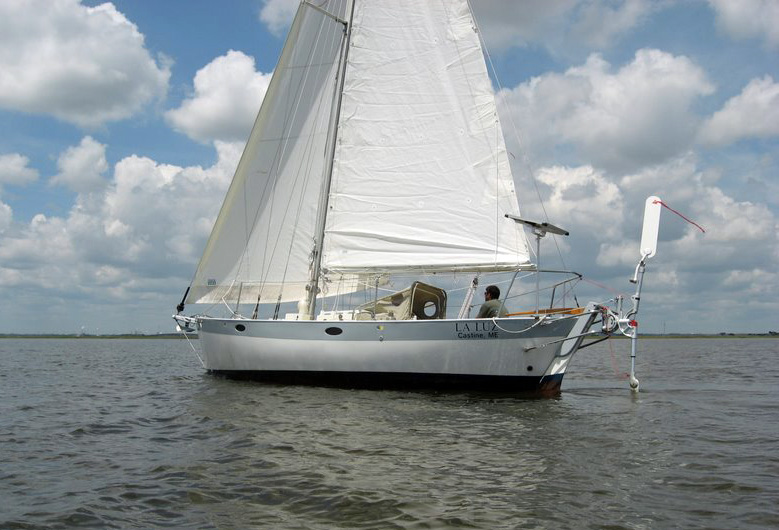
LA LUZ had a big genoa so she goes very well in light airs. She spent five years sailing in the South Pacific and ended up in New Zealand.
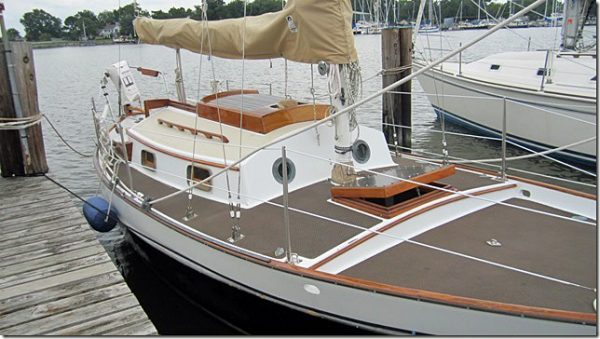
THE NEW VERSIONS will have a short cabin very similar to this, perched atop the midship raised deck. The perception of space this lends to the interior is quite amazing.
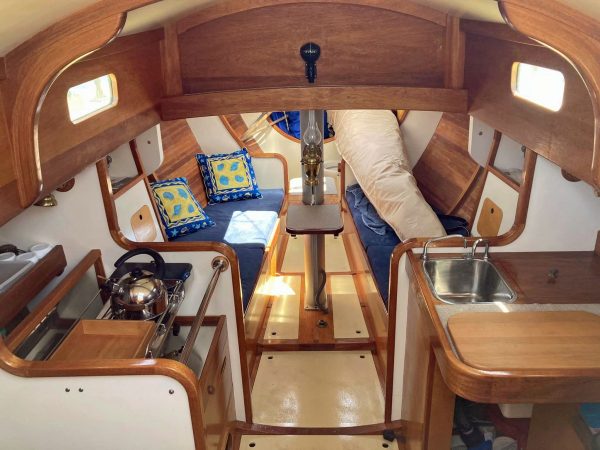
WITH THE SHORT, almost 6-foot headroom house, the interior of a Frances could feel much larger than you’d expect on a 26-foot boat. This is a custom WEST-system boat built in New Zealand.
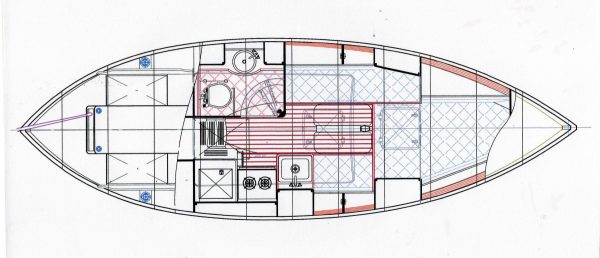
The Aft Head arrangement for the Frances with one seaberth and a permanent double. (Note: The companionway steps may have to be slid forward depending upon your choice of propulsion).
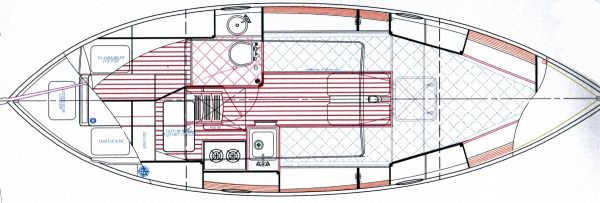
The Aft Head arrangement for the Frances with two settees, and a large double berth forward. (Note: The companionway steps may have to be slid forward depending upon your choice of propulsion).
The original FRANCES is a highly respected, classic design. She’s comparable in many ways to an MGTD or a J3 Cub. They spewed oil and weren’t very fast by today’s standards, but they were so cute and stylish and safe that owners have enjoyed every minute of their use for decades. The hullform is conventional, heavily ballasted , with no concessions made for speed. It has a CSV (capsize screen value) of 1.70. Anything less than 2.00 is considered a good choice for offshore voyaging.
This design is featured in both of my recent books; MY YACHT DESIGNS and the Lessons they taught me, and THE BOATS I’VE LOVED— 20 Classic Sailboat Designs by Chuck Paine. Both are beautiful, full colored, first class books which give you lots more information on this design, and can be purchased on this website.
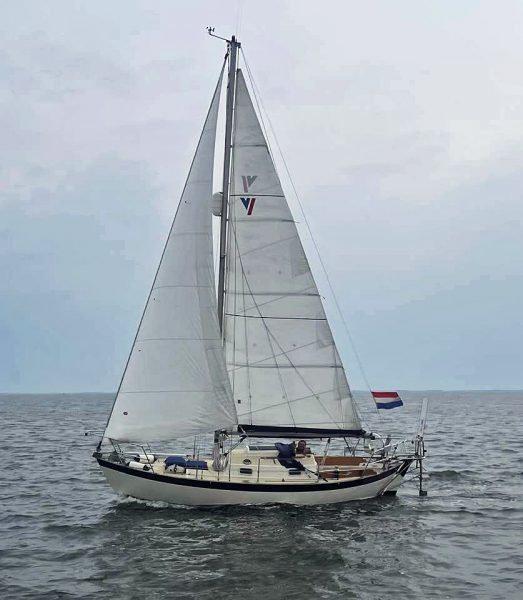
QUITE A FEW sailplans have been fitted to a FRANCES. This is one of the “tall rigs”, which could even be raced, and really got the boat going in light to moderate airs, but are too overcanvassed for offshore voyaging. If your idea is to sail around the world, the more conservative rigs, with a three-foot shorter mast, would require reefing less often.
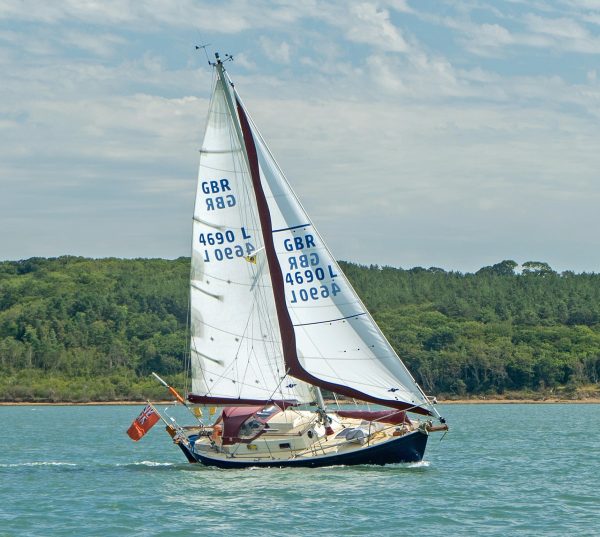
A British built cutter rigged FRANCES. photo credit Charlie Whiteman
FOR MORE PHOTOS OF LA LUZ , A FLUSH-DECKED FRANCES THAT HAS BEEN SAILED HALFWAY AROUND THE WORLD, CLICK HERE:
http://frances26.org/laluz.php
Further information may be obtained from:
CHUCKPAINE.COM LLC Tenants Harbor, Maine 04860-0114
To email Chuck:
A LONG, FUN HISTORY OF THE FRANCES 26 DESIGN
You’ll find great histories of the FRANCES design in both of my books, available as digital downloads from this website. But a recently formed Facebook Group called The Chuck Paine Yacht Designs Fan Club has produced all sorts of photos from owners all over the world, and a few interesting anecdotes. With the benefit of these gifts from the 48-year history of the Frances design, here is a much longer story, told mostly in pictures..
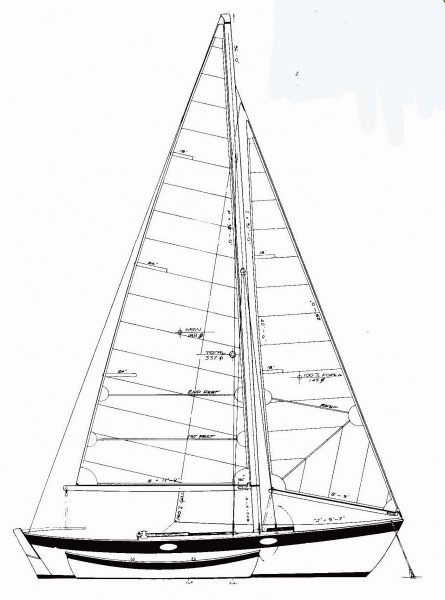
The first of many eventual sailplans had a tall fractional sloop rig with a self-tending jib set on a jibboom. This worked okay before jib roller-furling became popular, but the boomed jib gave up some potential sail area and the tall mast was heavy and required a lot of rigging with its weight and windage.
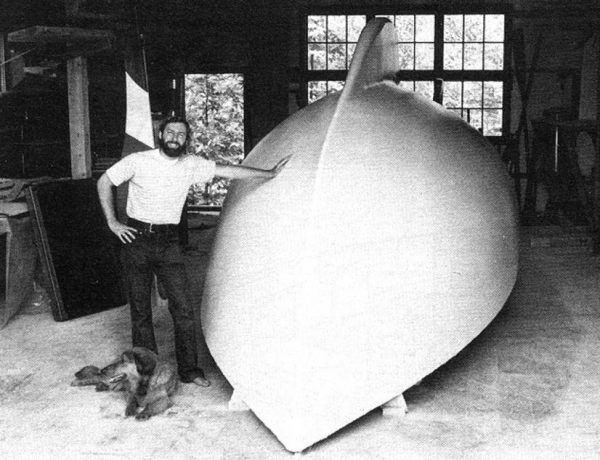
THERE I WAS at age 30. Young and ambitious, I’d come up with an idea of what life was about for me. Design a new yacht, build a prototype in my beautiful rented shop, sell it to one of the many emerging fiberglass boatbuilders and do it all over again. With my superb shop full of the finest tools someone else’s money could buy, a pretty girlfriend who looked like she might stick around, and my loyal dog Shep at my feet, what could possibly go wrong?
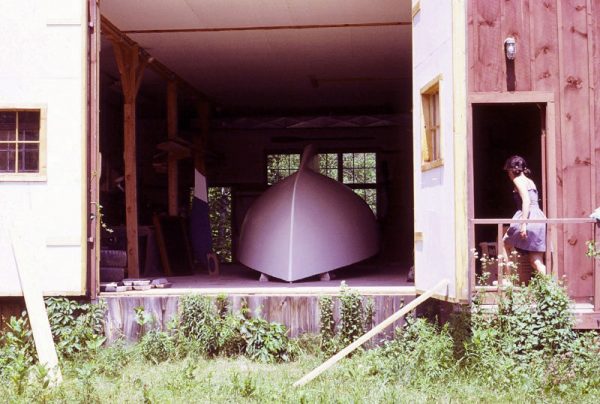
IN 1973 I had recently quit my job working for Dick Carter as a draftsman. I’d met this girl (now my wife) and decided to take her on a backpacking trip from Scotland to India. I had this idea that when we returned I would take my life savings and design and build a boat. The Westsail 32 had become a life-changing phenomenon for sea-seeking vagabonds, and I figured what the world needed was a smaller, more affordable double-ender. 26 feet was all I could afford so that determined her size. I lucked out and was able to rent this beautiful, heated and insulated shop full of the best woodworking tools for next to nothing. This shows the nearly finished hull upside down in midsummer of 1974, when I met this guy named Tom Morris who was getting started as a boatbuilder and fell in love with the design. We made a handshake deal that he would take a fiberglass mold off my hull, invest in a lot more tooling and a ballast mold, and I would press on and finish my boat in time for me to take it to the Newport Boat Show in September, and we would both become rich and famous. In the end, luck intervened.
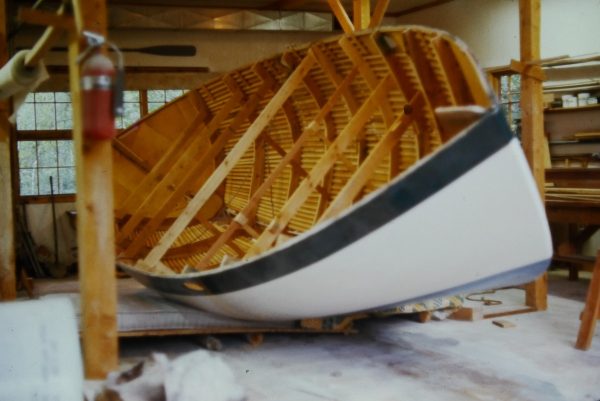
AFTER TOM MORRIS had taken his mold off my hull the day came to turn her over.
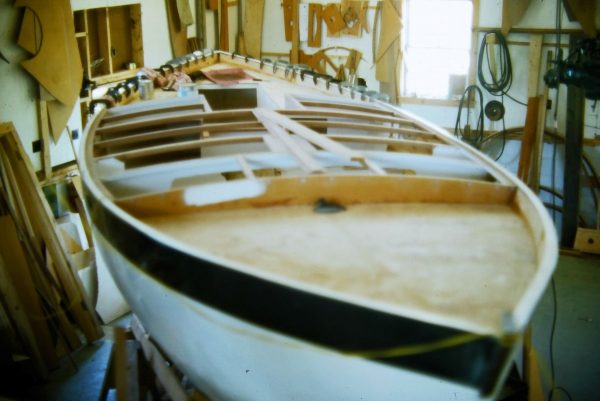
AS THE SUMMER wore on my boat was nearing completion. Her hull was built using the then popular foam core over stringers method, with a conventional glass covered plywood deck over frames.

WITH MY BOAT NEARLY FINISHED, the shop burned to the ground. Gone were my new boat, my life savings, all my tools, my landlord’s beautiful shop that I had planned to live out my life in, and my newfound livelihood. But I dusted myself off and determined to take the insurance settlement and build another Frances in the Spring.
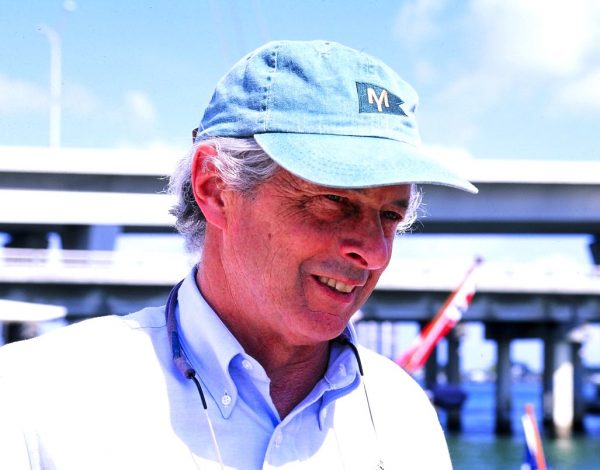
IN A STROKE OF GOOD FORTUNE I had met Tom Morris and he had committed to building new Franceses. When he heard about the loss of my boat he offered to sell me a hull from his new mold at cost, and space in his shop in Southwest Harbor in which to complete it. I hired my twin and he moved to Maine to help me get it built. We worked together for six months of intense work and got her finished in time to show her at the 1975 Newport Boat Show. Tom and I sat together on the side deck for four days and sold boats… it was that easy back in the halcyon days of fiberglass boatbuilding.
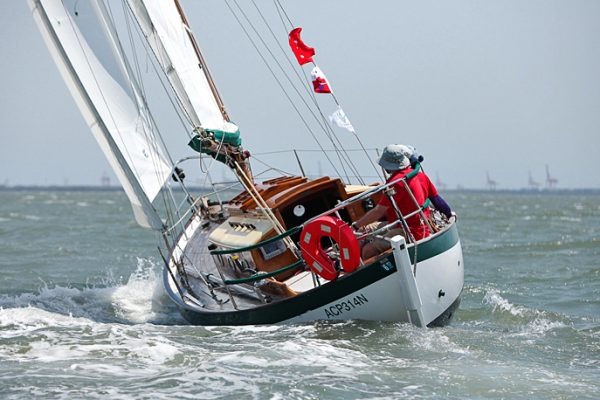
WHEN CUSTOMERS CAME ALONG who wanted to build a FRANCES of some other material than fiberglass, I would sell them the appropriate plans. Most of these customers hailed from other parts of the world. This one is Tom Thumb , built in Australia.
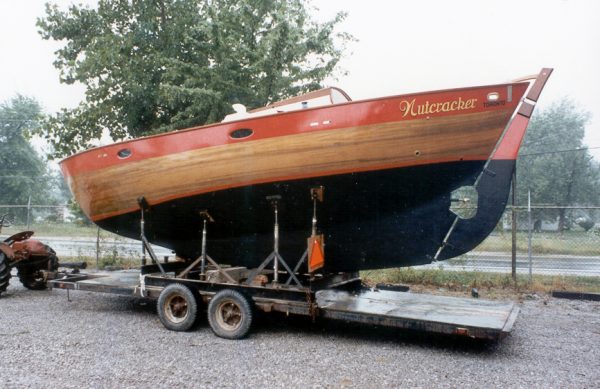
NUTCRACKER was built in the WEST System by a lady sailmaker from Toronto.
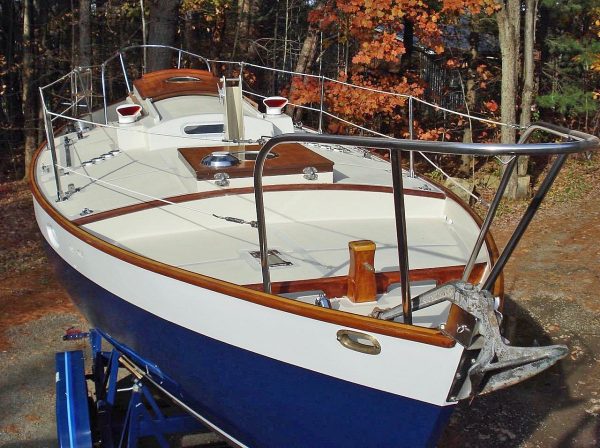
HERE’s NUTCRACKER 46 years after first launched, restored to like-new condition. WEST System cold molded yachts last virtually forever., given a facelift every 50 years or so.
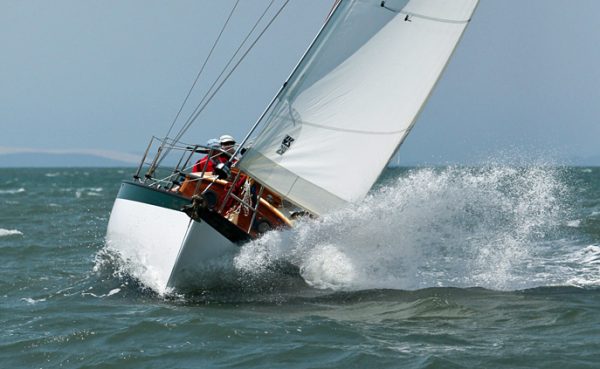
TOM THUMB coming at you. A lot of boat, a lot of ballast, and a lot of wind.
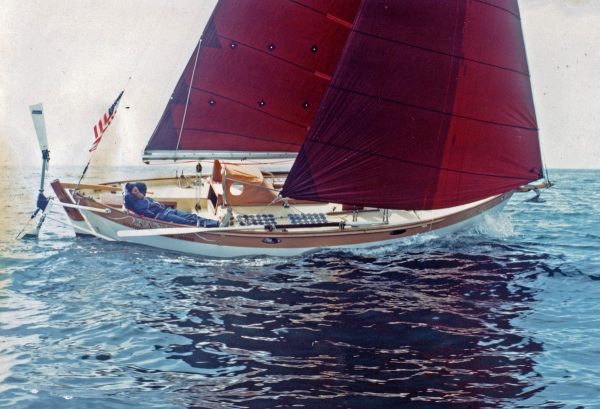
A GUY NAMED DICK CROSS BOUGHT A KITBOAT FROM Tom and hired my brother Art to help him finish it. Art drew a rig with a huge 150% overlap genoa, and in less than ten knots of wind the boat really flew. Like many well-drawn double-enders his boat KARMA could be easily steered by a wind-vane self steerer. Here Dick is having a kip while the boat steers itself happily to windward. Dick was a man’s man. No roller furling on that genoa, and if the breeze got above 10 knots he’d have to wrestle it into submission and hoist a smaller jib. And don’t forget his version had a bowsprit.
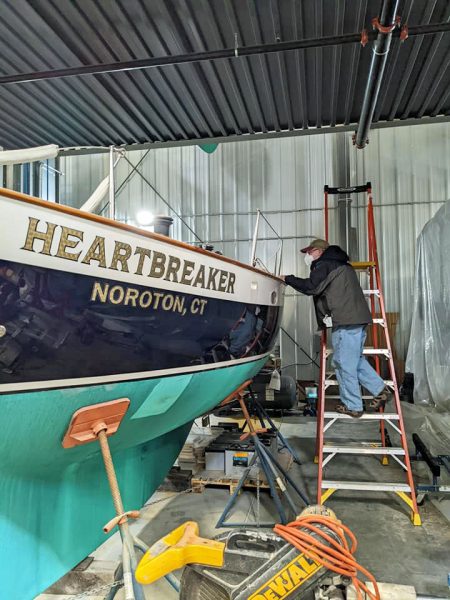
IN 2022 I caught up with hull number one of the FRANCES, built by Tom Morris alongside the hull that I was completing in his shop. She’s still going strong. I still remember that her original owner asked me to design a tall double-spreader rig for her so that she could be raced.
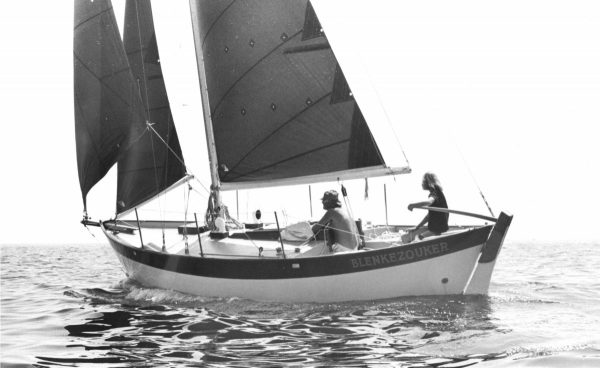
TOM MORRIS sent this photo of one of his first builds, BLENKEZOUKER, to most of the European yachting magazines. As a result Bernard Hayman, the then editor of Yachting World in Britain, wrote an embarrassingly favourable editorial, decrying the fact that it took a bloody Yank to design something so beautiful. Four British boatbuilders saw the editorial and heard that it had in the words of Hayman elicited more inquiries to Yachting World than any article in its history, and asked to build it under license. Tom Morris and I chose a young and ambitious entrepreneur, Peter Gregory, and his new company Victoria Marine, to build the Frances in the UK. In a few years he had built more than 150 Franceses is various versions, and commissioned three more Chuck Paine designs to be built at his shop in Warsash at the mouth of the Hamble river. The success of the Frances and my next design for Peter, the Victoria 30 , caught the eye of Charles Maunder at Bowman Yachts in Woolston (Southampton, UK), and in the next few years he built hundreds of yachts to four of my designs.
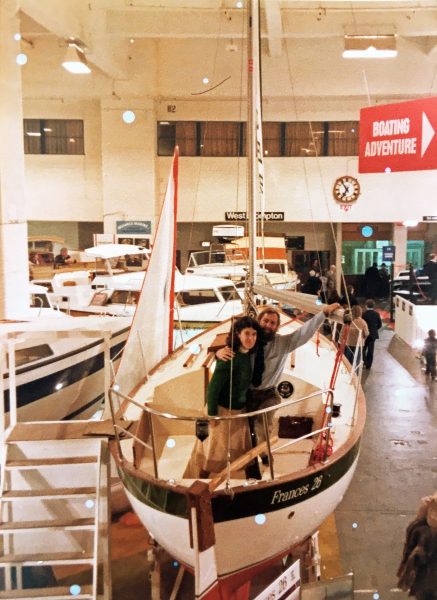
CHUCK AND DEBBY at their first London Boat Show, 1977.
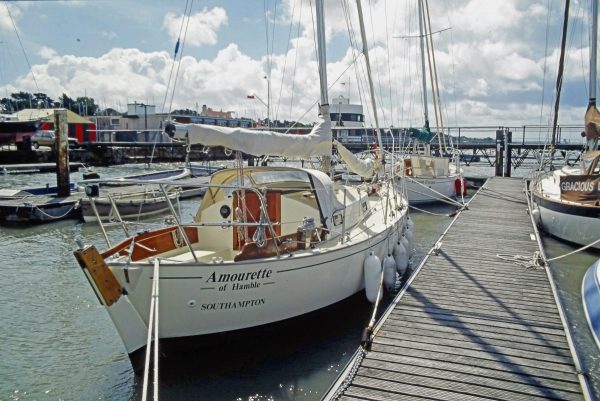
HERE’S ONE OF the many Franceses at her birthplace Stone Pier Yard in Warsash, UK. Not your typical English weather, but when the sun shines in southern England, it’s glorious.
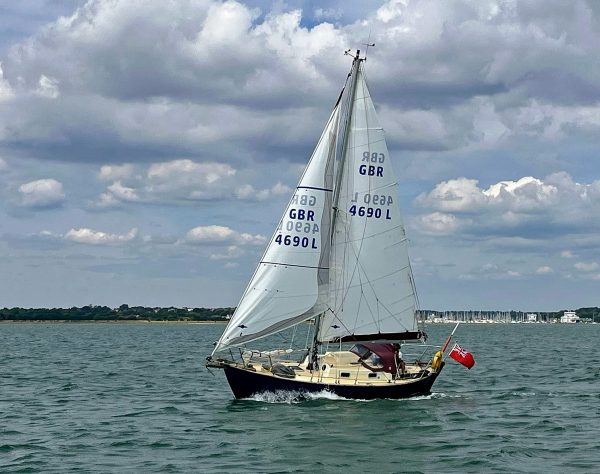
A CUTTER RIGGED Frances somewhere along the coast of England. The wobbly perimeter of the sunshade makes me crazy.
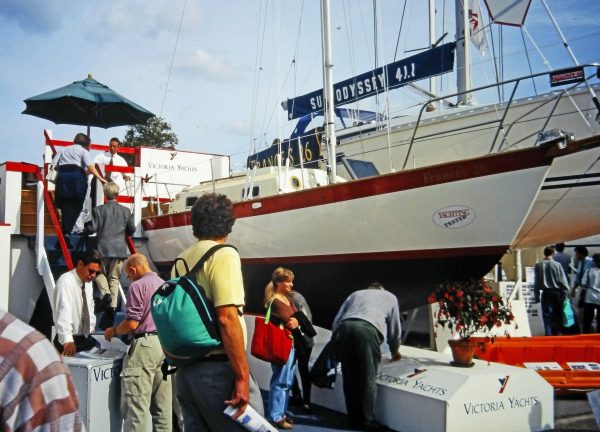
THUS BEGAN MANY YEARS of commuting to England to sell boats, and to convince either Peter or Charles Maunder of Bowman Yachts that he needed a new design. I would attend the London Boat Show at Earls Court Exhibition Centre every January, and the Southampton Boat Show every September. In all those years I can’t recall a Southampton show when the relentless rain that typifies an English summer didn’t cease for the week in September that I had to be at the show
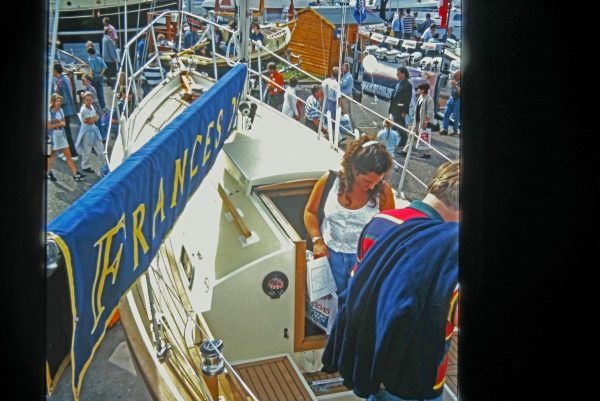
A TYPICAL Southampton Boat Show scene.
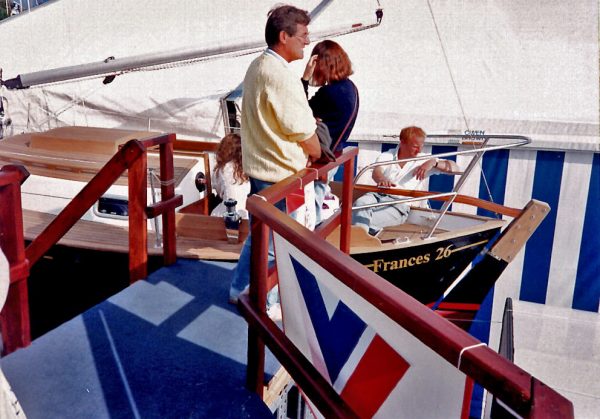
DITTO. Was it my sunny disposition that brought the fine weather?
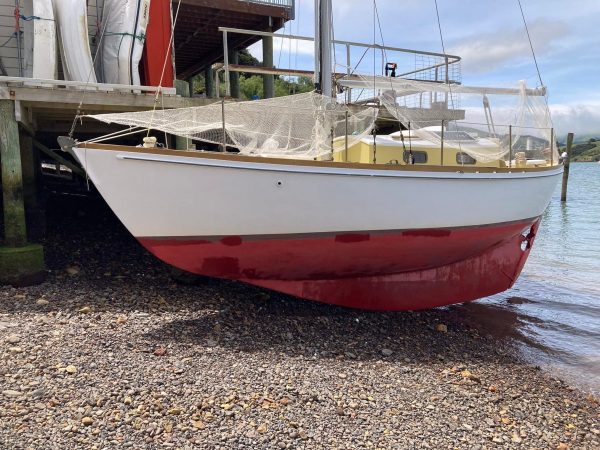
GALAVANT WAS built in New Zealand in wood/epoxy. If you ever get to Christchurch, drive to its seaport Lyttleton and maybe you will find her there.
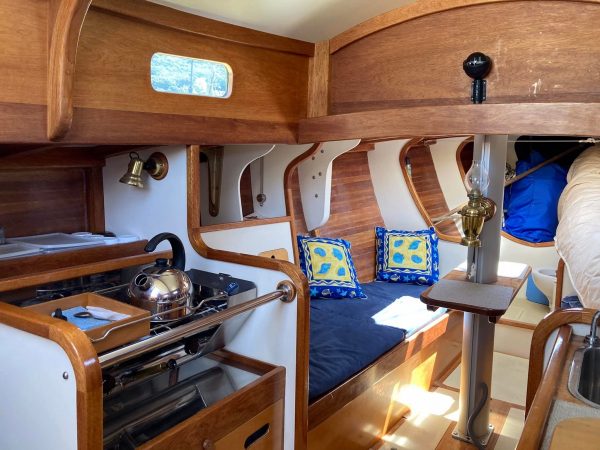
SOME OF THESE home-built boats were really nicely done. GALAVANT ‘s owner decided to open up the interior by eliminating the usual “main bulkhead”, using a series of hanging knees to provide adequate strength. I like it.
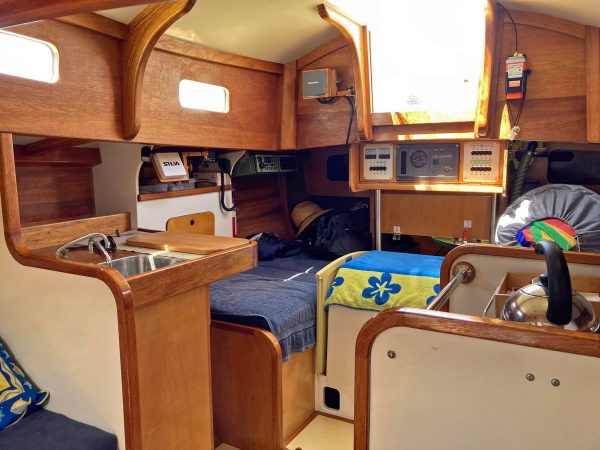
SAME BOAT looking aft
I PARTICULARLY LIKE the cabin sole- nice, light color.
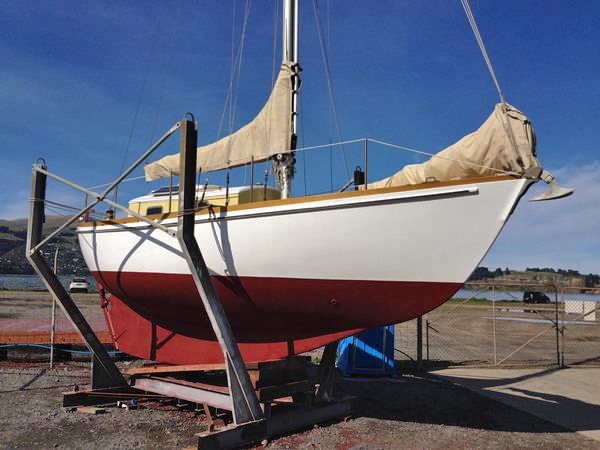
ANOTHER PHOTO OF HER SHAPE.
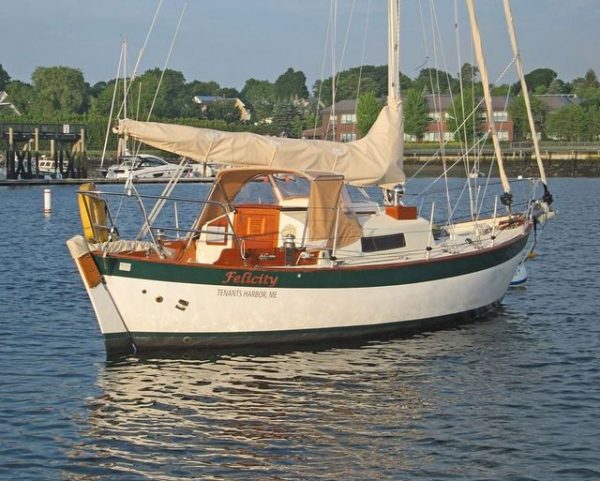
FELICITY . A British Frances that sailed to Maine.
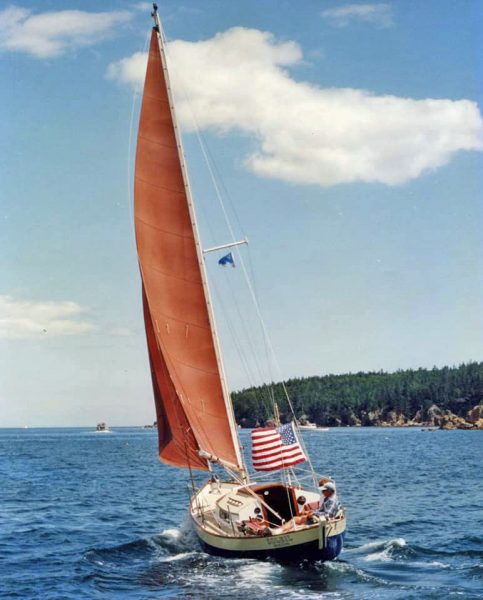
SOLEIL . Tom Morris owned this one himself for awhile.
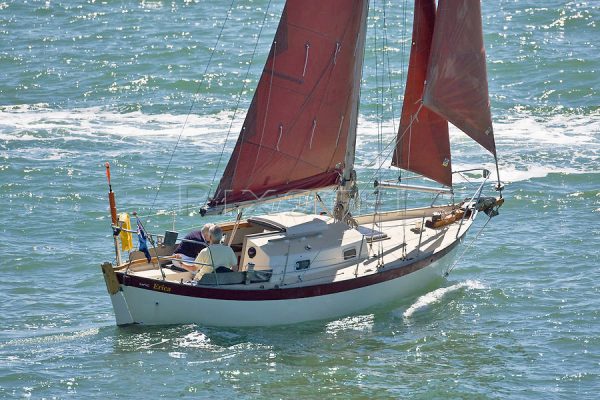
A VICTORIA FRANCES. Location unknown. This is the tidy original “British Cutter” rig. Not fast, but it could stand up to much more wind than the tall, racy rigs.
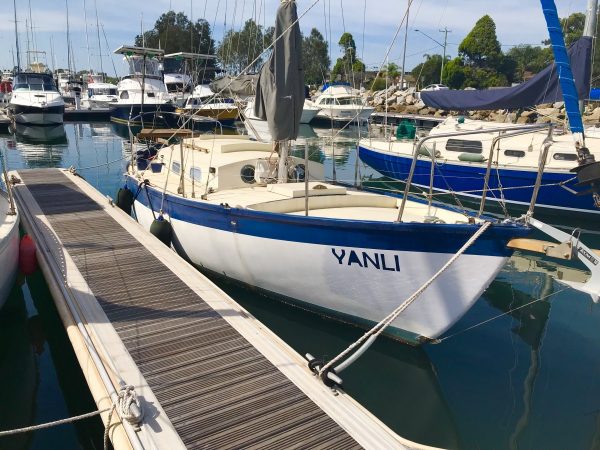
I FOUND YANLI in Bateman’s Bay, Australia. When I encountered her I didn’t know her story. She must have been shipped there on the deck of a freighter, I thought. Nobody would be crazy enough to sail a Frances that distance. Then through the Chuck Paine Yacht Designs Fan Club on Facebook I learned her actual story. A fellow bought her new in Warsash, UK. He financed her. Put down his down payment, hoisted the sails, and that was the last the bank heard from her owner for years. He sailed her south to the Canary Islands, then across to the Caribbean. Then through the Panama Canal. Howcum the bank didn’t have an arrest warrant waiting for her at this obvious choke point I can’t fathom. Then on he sailed to New Zealand. As if that weren’t enough adventure sailing too small a boat on too large an ocean, he then sailed across the Pacific again to the North, to Hawaii. And that is where the bank finally caught up with him. The bank arrested the boat and sold it to an Aussie. Who then sailed it BACK across the Pacific to Australia. Which is how I got to take this photo in Bateman’s Bay Australia three years ago- not looking too bad after the equivalent of sailing around the world!
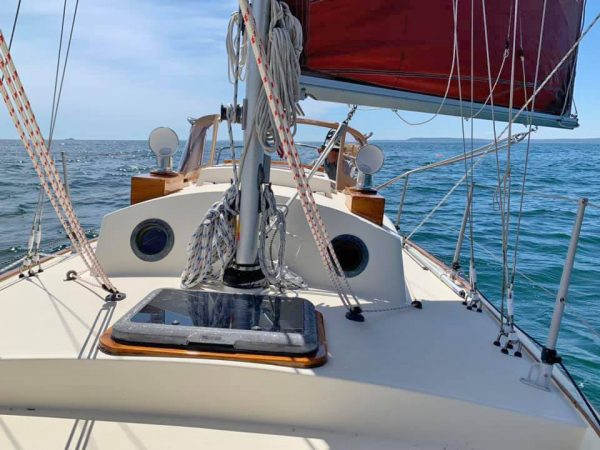
THE JOYS OF downwind sailing.
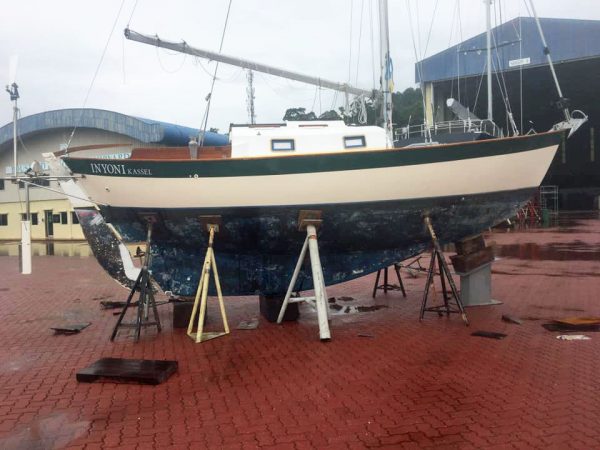
INYONI . Needs some bottom paint.
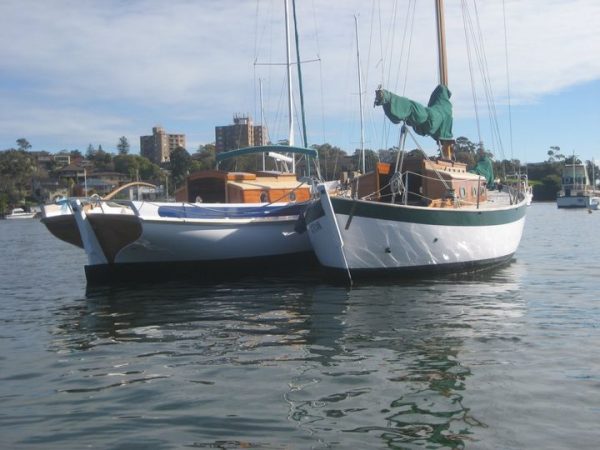
TOM THUMB in Sydney, Australia.
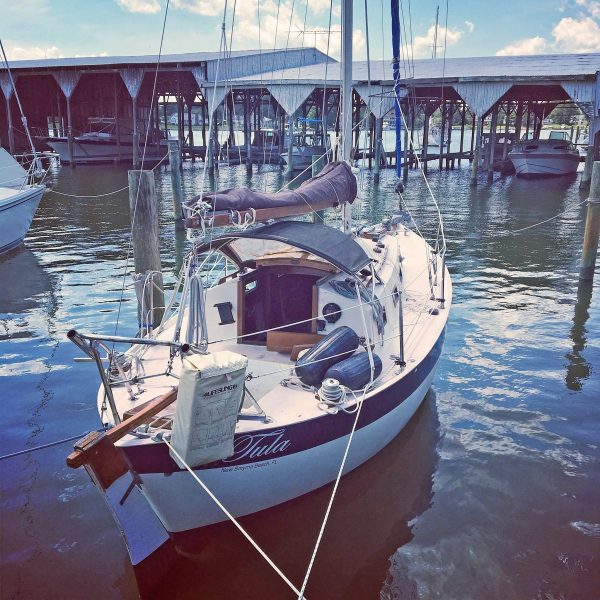
TULA . Someplace in Florida, I think.
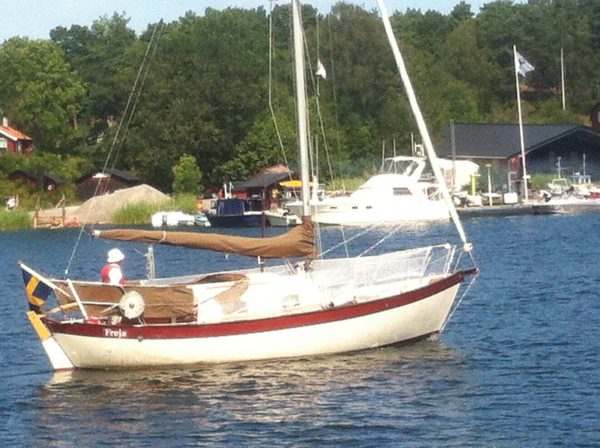
FREJA . Location unknown.
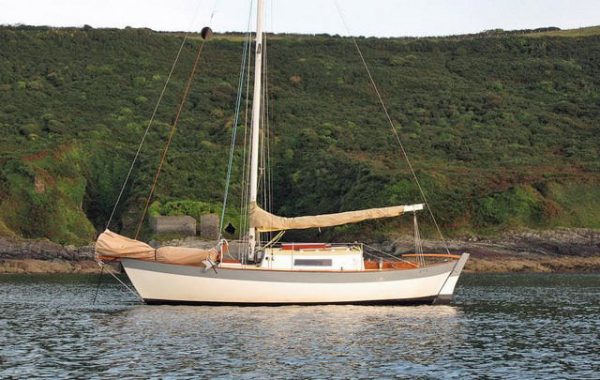
A BRITISH BUILT FRANCES, someplace in England..
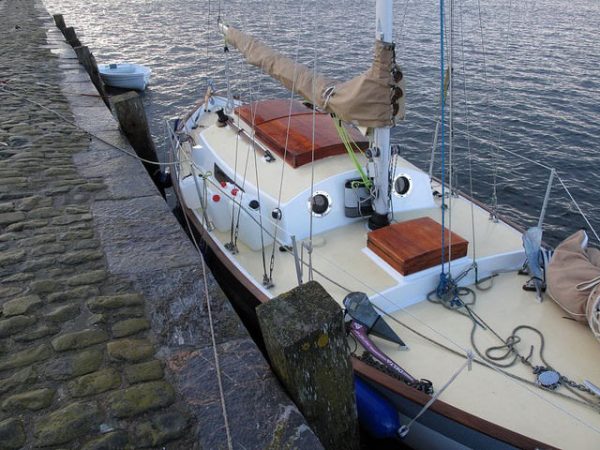
THE CUSTOM VARNISHED companionway and forward hatch are nice touches.
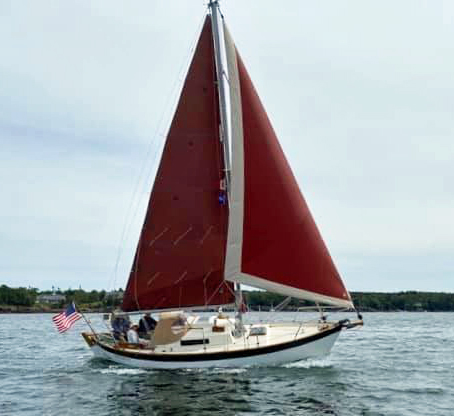
FELICITY SAILED transatlantic from the UK to Maine. She lives in Rockland, Maine now, a few miles from my home.
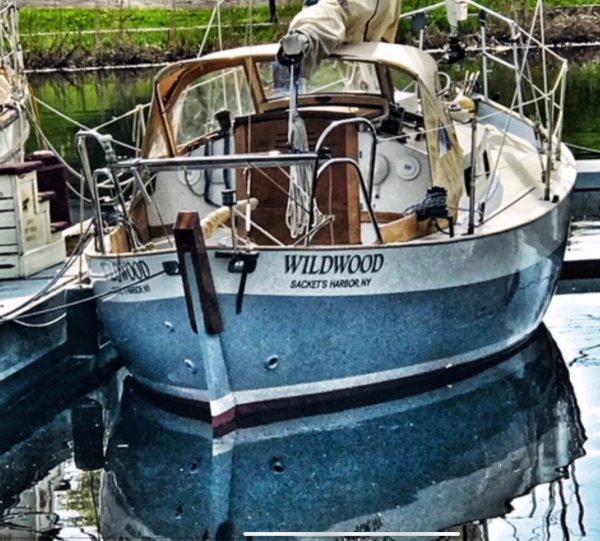
WILDWOOD is one of the Tom Morris built beauties.
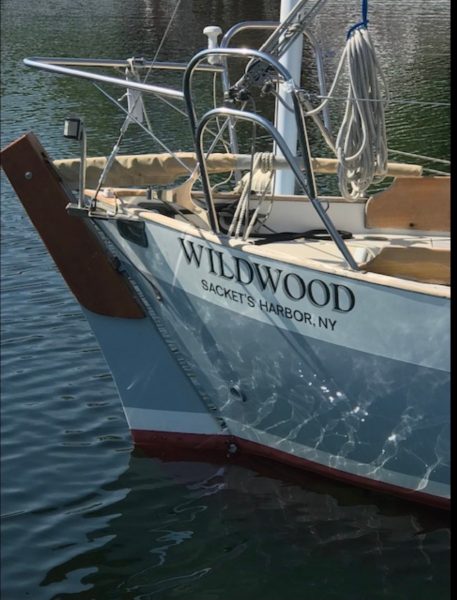
THIS BRITISH BUILT Frances is trying out her new mainsail.
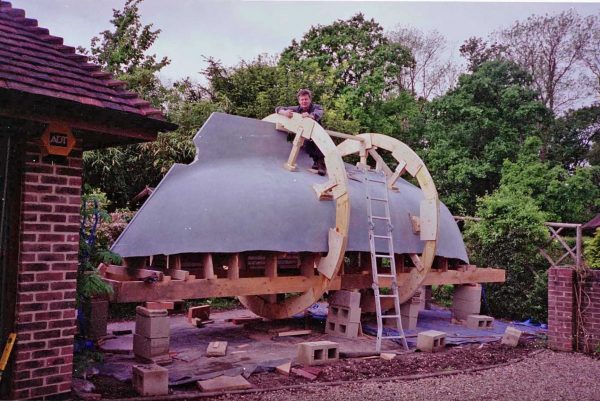
A HOME-BUILT Frances on turnover day. Location and details unknown.
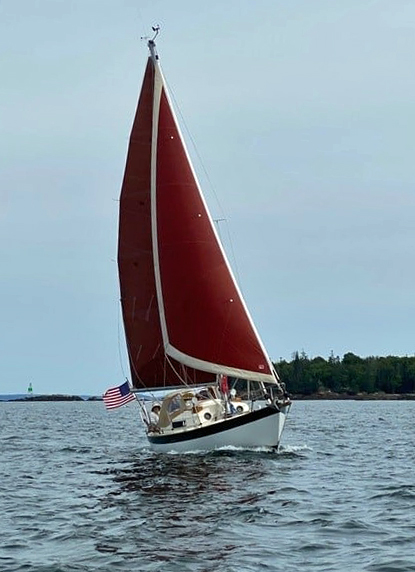
ANOTHER PHOTO OF David White’s British-built FELICITY outside of Rockland, Maine harbor.
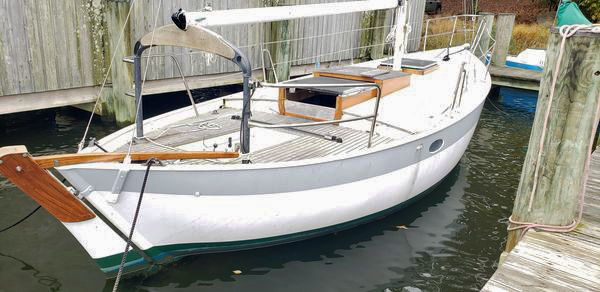
TOLERANCE . In my dotage I’ve come to find varnished teak railcaps intolerable. I really like the ones that are simply painted white. They’re so much easier to take care of. And if the shape of the design is inherently beautiful, varnished teak is just gilding the lily.
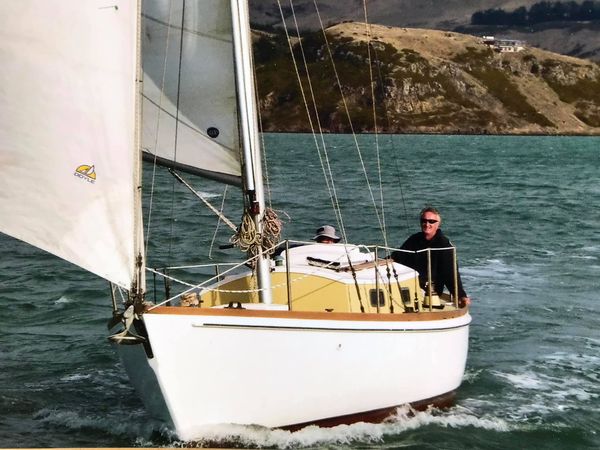
A CLOSEUP OF GALAVANT sailing in Lyttlton Harbour, NZ.
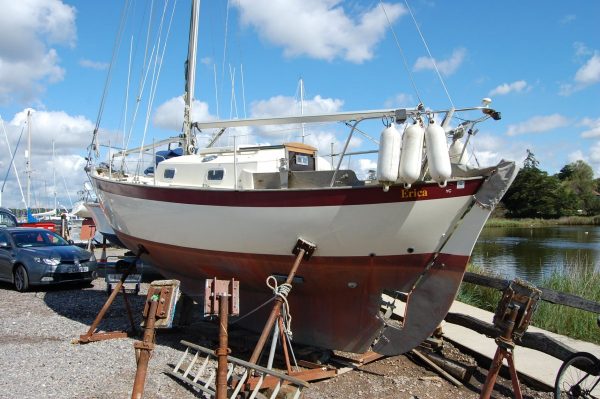
ERICA . I think she’s at Universal Marina on the Hamble river.
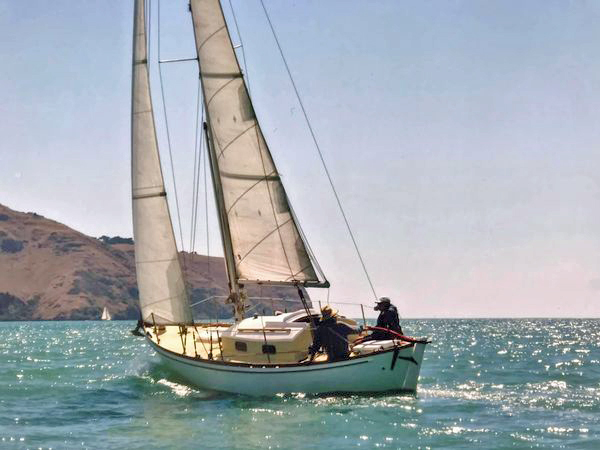
GALAVANT Galavanting nicely to windward.
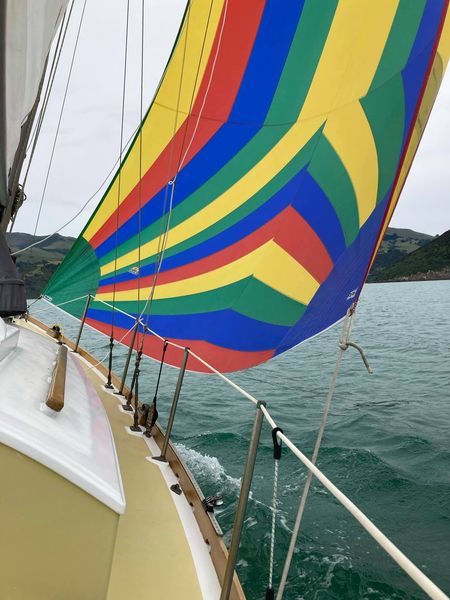
GALAVANT’s colorful reacher.
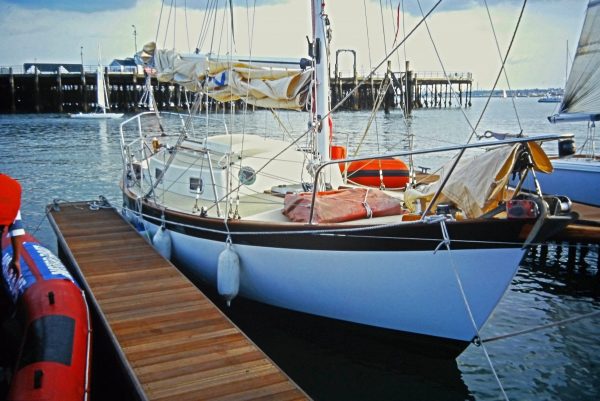
ONE YEAR PETER GREGORY showed one of his creations in the water at the Southampton Boat Show.
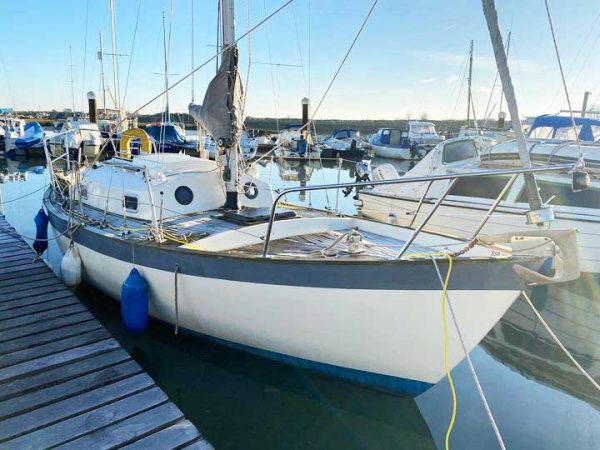
WHIM. Tollesbury, Essex, UK.
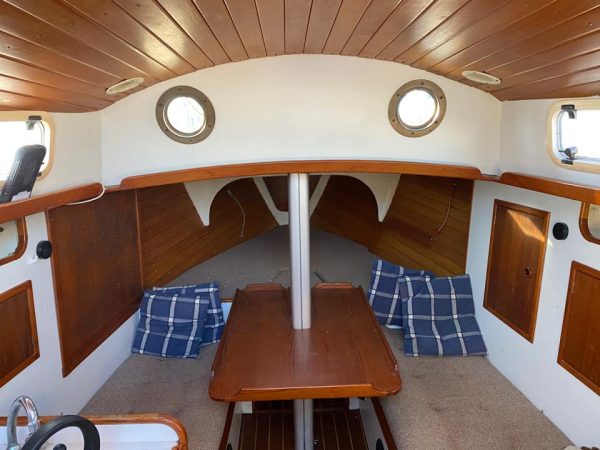
WHIM ‘s nice, wide open interior.
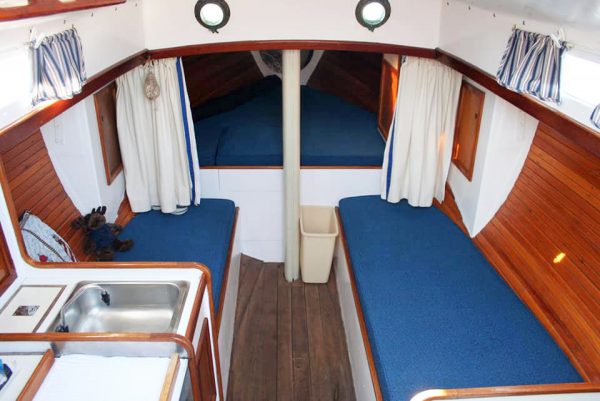
SOLEIL’ s Interior
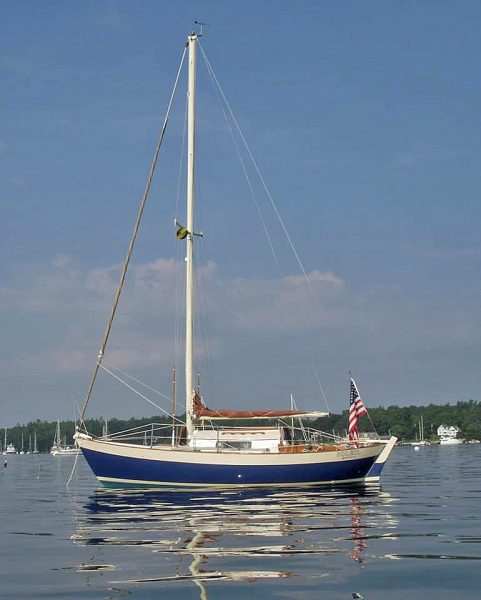
SOLEIL – Morris built Frances
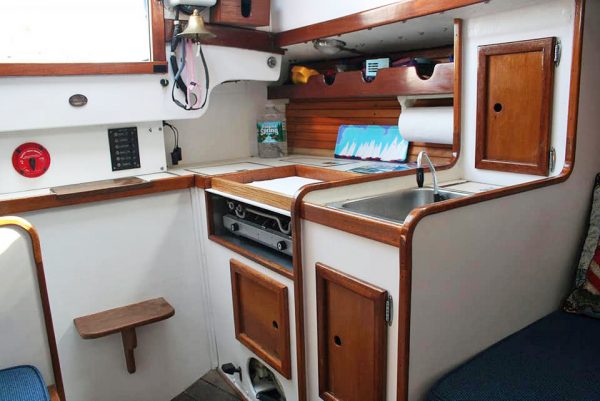
SOLEIL ‘s Galley.
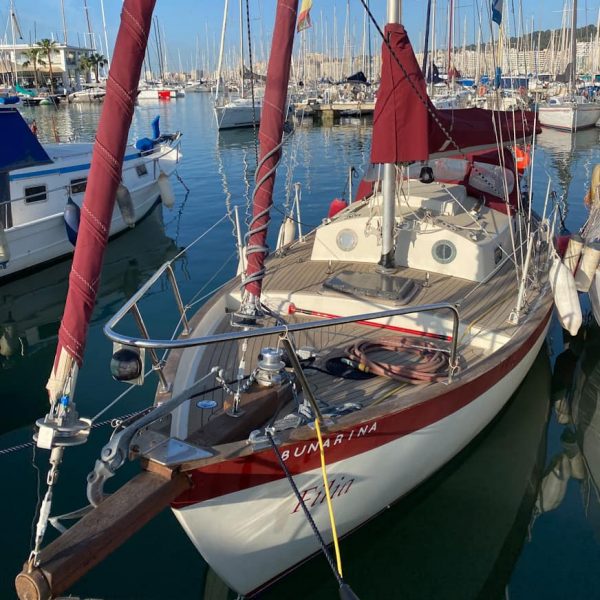
A CUTTER RIGGED FRANCES. Location unknown.
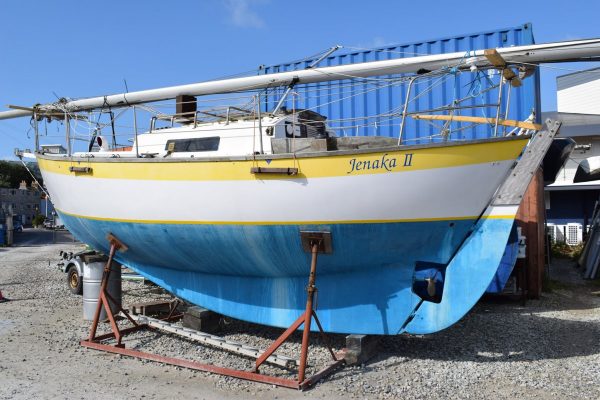
AN ENGLISH FRANCES somewhere in the UK. One reason the Frances sails reasonably well despite the shoal draft is the absence of a garboard radius. The entire keel does its work of preventing leeway- all the way up to where it meets the hull.
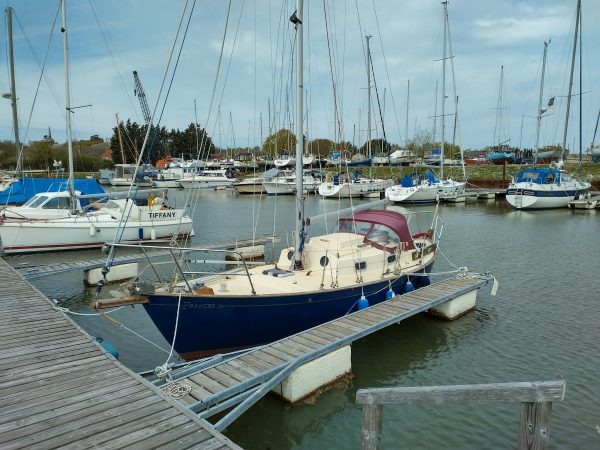
A cutter rigged Frances somewhere in the UK.

ELLA is one of the two FRANCESes I am aware of that fitted a gaff rig.
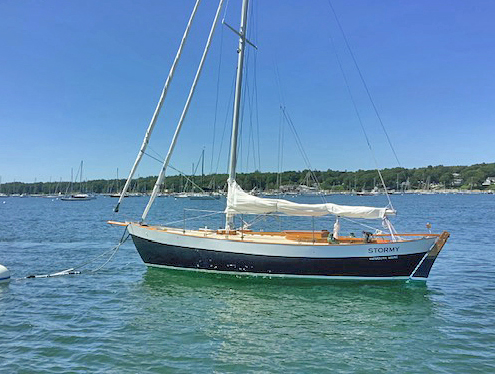
STORMY is one of the newly restored Morris Franceses. She is once again in like-new condition, and comparable with a brand-new custom Frances that would cost well over half a million dollars to build today.

10 Best Sailboats for Solo Sailing (One Person)

Last Updated by
Daniel Wade
December 27, 2023
The idea of single-handed sailing or solo sailing appeals to racers and cruisers alike. But what are the best sailboats for solo sailing? Well, let's find out.
Whether you've been thinking of going for a day's sail without assistance or dreaming of a solo passage to Bermuda, the desire and the magic of venturing out alone at the sea is something that any sailor can experience. It doesn't matter if you're cruising or racing, solo sailing, of course, requires you to change your thinking as you'll be solely responsible for the entire operation of the boat. More importantly, choosing a well-founded boat is critical to solo sailing.
When sailing with a crew, things may seem a little easy because you share the responsibilities among the crew and support each other in case of anything. But what happens when you decide to venture out alone or sail single-handedly? Whatever motivates you to go out sailing solo, you should choose a good boat that you can perfectly operate single-handedly.
In this article, we'll highlight 10 best sailboats for solo sailing, their prices, their best rigs, and everything else that you might need to sail them comfortably and safely.
Table of contents
General Features of Best Sailboats for Solo Sailing
Here are the general features to look for when choosing the best sailboat for solo sailing.
The Availability of Automation Systems
The forces that you sometimes have to deal with when out sailing can be extreme, to say the least. It doesn't matter whether you're sailing solo or with a crew, it's always very important not to underestimate the power of the wind and tide. While you can do a lot on your own, having some automation systems in place is an important feature if you're planning to sail single-handedly. In other words, a good sailboat for solo sailing should have various automation systems to make your work a lot simpler.
So if you're planning to go solo sailing, it would be great to consider a boat with the following systems:
- Autopilot for steering
- Lines running aft (running to the cockpit)
- Roller furling
- Electric windlass
- Hydraulic bow/stern thrusters with remote
Stability and Ease of Use
Again, the best sailboats for solo sailing are generally not known for their speeds. This is because they typically have wide beams and short waterlines, which are vital in providing stability thereby limiting their speeds. In short, the best sailboats for solo sailing usually sacrifice speed and additional performance for ease of use and stability.
Boat Features
When it comes to the structure of the boat itself, it's important to go for a boat that is close to the water, relatively small when compared to the wave height, and has lighter ballast, especially when compared to the displacement ratio. The idea here is that these features can combine to increase the boat's performance when you're sailing solo.
Additionally, a good solo sailing boat should be designed with a flat profiled aft bottom section. This is to ensure that the boat can come up on a plane when the wind conditions are breezy or marginal.
When it comes to the best sails for solo sailing, you can go for the unique sail design that combines both a Bermuda sail and a gaff sail. This can be essential in giving you a more sail area on a shorter mast than is possible when using either a gaff sail or a Bermuda sail. More importantly, the combination of a gaff sail and a Bermuda sail not only gives you a greater sail area on a shorter and easy to control mast but can also reduce the heeling force that's common in boats with taller and narrower sails.
Still on sails, it makes a lot of sense to choose easily operated sail controls. You certainly want a sail that one person can tuck a reef in quickly and be able to easily adjust the sheets. You should, therefore, prioritize the reefing and sail handling systems.
In terms of rigs, the gaff rig is arguably the best when solo sailing. Although the Bermuda rig is the most common, especially in modern sailboats, you can lose some windward abilities because of its lower aspects. As such, you can choose to use the gaff rig thanks to its ease of use and superior downwind performance.
10 Best Sailboats for Solo Sailing
There are numerous sailboats out there that can be easily and properly handled by a skilled and experienced sailor. To make it a lot easier for you, the following boats are great choices when solo sailing. Whether you're just looking to experience how it feels to solo sail or short-handed, they all offer easy, comfortable, and safe sailing.
Jeanneau Sunfast 3200
{{boat-info="/boats/jeanneau-sun-fast-3200"}}
From the outset, it's easy to see that the Jeanneau Sunfast 3200 is designed with offshore short-handed sailing in mind. In addition to being a purist's sailing boat, this boat is a small and light boat that can be easily handled. Even better, it has the stability and strength to handle long passages and that's exactly why it was initially designed with the Trans-Atlantic race in mind.
With this boat, you can easily attain double figures in terms of speed even if you're sailing downwind. In essence, the Sunfast 3200 is designed with some of the latest technology to afford you the best strength-to-weight ratios. It has all the necessary features to allow you to easily adapt it to perform perfectly either as a cruising or racing sailboat. Some of its greatest features include the two double cabins, the chart table, a galley, and a head compartment.
This boat is particularly impressive when sailing off the wind and it's designed to ensure that it's functional and reliable even when solo sailing. This is perhaps because it's designed and set up for racing, so it can be great for you especially if you're looking for a coastal cruiser that can be easily handled.
Using the sloop Marconi can be the best way to go given that this vessel has a keel-stepped mast. Its maximum beam begins at 60% aft of the stem before extending to the transom, which can result in the sled hull being driven by a mainsail-heavy rig. This can then fly the masthead asymmetrical off a short sprit.
Given that the Jeanneau Sunfast 3200 is a very modern boat that's equipped with some of the latest boating technology; it comes with a base price of about $160,000. This is a vessel that's built by one of the world's premier builders and offers an intriguing blend of technology, reliability, functionality, practicality, and performance.
Having been the European Yacht of the Year for 2008, the Sunfast 3200 may just be the godsend boat for your solo sailing dreams.
{{boat-info="/boats/hanse-371"}}
If you're looking for a slippery cruiser-racer that's always ready to sail single-handedly, you might perhaps want to take a serious look at the Hanse 371. Introduced in 2003, the Hanse 371 is a mid-sized boat that was designed in a true blend of old and new boating technology. Thanks to its furling and self- tacking jib, the Hanse 371 becomes an instant single-handed sailing vessel that takes much of the strain out of your solo sailing adventures. That's not all; this boat is more popular as a result of its autopilot system. Press a few buttons and you'll be ready to go.
Although it's a little bigger and not one of the smallest boats out there, it can be a great option if you're planning to sail solo but on a vessel that offers a tremendous amount of space. Whether you love a boat with a shallow or deep center of gravity, the Hanse 371 has a commendable large galley and a spacious cabin layout.
Everything about rigging this boat is designed to be easy. Again, the jib on a roller furler is self-tacking. In essence, everything is standard and easy to use, which makes this boat a dream when sailing single-handed.
Already a classic that's known for its stylish interior, timeless look, and ultimate performance, the Hanse 371 is a coveted vessel that may cost you around $60,000.
Hunter Channel 31
{{boat-info="/boats/hunter-channel-31"}}
Launched in 2001, the Hunter Channel 31 is structured with a hull and keel design that makes it easy to sail single-handed. This is a British-made vessel that has steadily moved from the racing scene to become a well-respected cruiser, especially among the solo sailing community. Thanks to its faultless handling and impressive turn of speed, the Hunter Channel 31 provides near uncomplicated sailing without losing its impeccable handling features.
Its well-balanced hull shape can either be structured with a low or deep center of gravity. It also has an efficient twin keel to give it more stability, which is perfect for solo sailing. This is, without a doubt, one of the main reasons why Hunter Channel 31 has proved popular among solo sailors trying to sail across narrow channels.
The Hunter Channel 31 is also designed with a great standard deck layout, as well as a non-compulsory self-tacking jib that comes with a single line mainsail reefing. That's not all; the tiller steering is also efficient if you're sailing single-handed as you can steer it with your legs while trimming sails.
It should, therefore, not come as a surprise that owners of the Hunter Channel 31 keep them for a long time, so finding them on the market will be a long shot. But if you're lucky enough to find one, you'll be getting a great vessel that will never let you down if you want to sail solo.
Like many Hunter designs, the Hunter 31 can be fractionally rigged given that it has a relatively large mainsail to give it a more sail area in light winds and a small headsail with a lower sheet load. In other words, you can efficiently and easily reef from the cockpit.
At about $35,000, the Hunter Channel 31 is quite affordable and is a great bargain in its category.
{{boat-info="/boats/j-boats-j109"}}
The J/109 is unquestionably one of the best single-handed or double-handed sailboats that money can buy. Whether you're looking for a coastal cruiser or a long-distance single-handed vessel, the J/109 will rarely disappoint. That's essentially why its single-handed offshore capabilities remain popular with sailors looking to make North Atlantic crossings.
Even though it is widely categorized as a planing sailboat, this vessel is too heavy for simple planing. Instead, this is a superb boat that offers an all-round performance. It doesn't matter whether you're solo sailing or sailing with a crew, its performance is always top-notch.
Thanks to its asymmetric spinnaker, you can easily jib it from the cockpit, especially in light wind. But when the wind is on the north of 20 knots, you can pole out the jib to give you a quick downwind speed. No matter which type of rig you choose to use, the J/109 offers a fair degree of control.
In terms of price, the J/109 is one of the relatively expensive sailboats out there, though this is compensated with the high standard equipment and outstanding quality of construction. For about $58,000, you can get a great boat that offers excellent solo sailing adventures.
West Wight Potter 19
{{boat-info="/boats/west-wight-potter-19"}}
Designed for safety and easy handling, the West Wight Potter 19 is a great sailboat for solo sailing. Although its name might not be one of the catchiest in the sailing scene, it's been around for over three decades and is steadily becoming a popular pocket cruiser. The original design draws inspiration from the U.K. but is currently built by the International Marine in California.
Over the years, this boat has seen several improvements even though its original look and features still attract a large and dedicated group of followers. This is not only a tough little boat but its hard-chine hull offers incredible stability. This makes it a very easy and ultimately forgiving sailboat. Whether you're looking to sail from California to Hawaii or across the Atlantic, the Potter 19 is outstanding for solo sailing.
This is a Bermuda-rigged sloop. Its sail plan is huge enough to propel the sailboat in various conditions. This makes it a perfect single-handed boat as you can easily set it up or take it down with no special equipment.
This is a remarkably affordable boat. At around $5,000 you can get a superb solo sailing sailboat. But if you want a new Potter 19 with additional features, you could pay about $25,000.
Beneteau 31
{{boat-info="/boats/beneteau-31"}}
As a small cruiser keelboat, this French-designed boat is primarily built of fiberglass and is perfect if you want a vessel that's great for solo sailing while still offering maximum space for comfort. Its galley is equipped with superb stowage and counter space and even a sit-down navigation station with a small table.
Maneuvering this boat under power is quite easy and is well worth it for any solo sailor who is in the market for a coastal cruiser.
It has a fractional sloop rig, which makes in-mast furling a great option. This makes it easy to handle but also powerful in light winds. If you're sailing the boat off the wind, bow pulpit and an optional asymmetric cruising chute can keep things lively.
The new 31 can cost around $115,000, which is quite expensive but certainly worth it if you want to cruise the world in this French masterpiece.
Catalina 315
{{boat-info="/boats/catalina-315"}}
This is a nifty pocket cruiser that raises the quality bar for solo sailors with extreme comfort and performance. With just a 9.45 meter hull, the Catalina 315 has more internal room than most classics and remains superb for solo sailing.
Although it's a much bigger boat, it has little but significant features that make all the difference. For instance, the split backstays are great for balance and functionality. This is one of the main reasons why it won the Cruising World's 2013 Boat of the Year Best Inshore Cruiser award.
With a masthead sloop, rigging the Catalina 315 is a lot easier as it is equipped with both an in-mast roller furling mainsail and a roller furling genoa.
Even though the Catalina 315 will exceed your expectations when sailing solo, it's a high-end sailboat that will cost you north of $175,000. But if that seems expensive, you can look for a used model, which will cost you slightly lower.
{{boat-info="/boats/vanguard-laser"}}
A boat that has become a staple in the Olympics Games, the Laser may be simple and small but a real-go to boat if you want a vessel that will rarely let you down for your solo sailing escapades. As one of the world's most popular single-handed sailboats, its main feature is its sheer simplicity. This might not be the best boat for you if you love those fussy, big boats. But if you're looking for an amazing boat with a two-part free-standing mast and a sleeved sail, the Laser should be on top of your list.
The fact that it has a lightweight hull and is easy to rig makes it one of the most popular racing sailboats in the world with over 200,000 boats in over 140 countries. This is undoubtedly a perfect boat that's specifically designed for solo sailing.
This boat can be rigged using various rigs, so you should go with whatever works for you. We, however, prefer cat rigging the boat since it has no headsail and only has one mainsail. This is a boat that is designed for speed, particularly in high winds. It's also easy to set up, which makes it a marvelous option for solo sailing.
For around $7,000, this is probably one of the most affordable solo sailing sailboats you could ever get your hands on. You should, however, keep in mind that its price may widely vary depending on their availability in your area.
{{boat-info="/boats/oday-rhodes-19"}}
A real classically-styled sailboat, the Rhodes 19 is an ideal family daysailer that can be perfect for you if you're a spirited solo sailor. Whether you're planning to sail in heavy weather or fast, the Rhodes 19 is designed with a forgiving hull and is an accomplished heavy-weather performer. For over 5 decades, and with more than 3,500 boats built, this sailboat has proven time and time again that it has the characters for both beginners and experienced sailors.
With a low center of gravity, this boat remains a classic beauty that's very fast, easy to trailer, and will get many compliments whenever you're solo sailing. No wonder it is still actively raced throughout the United States.
A simple sprit rig can work greatly on this boat but you can also consider Bermuda-Rigged sloop, which is efficient in propelling the boat in various wind conditions.
Its price may vary depending on your location but something around $20,000 will get you a sailboat that's still in tip-top condition.
{{boat-info="/boats/dehler-29"}}
If like most Americans, you have a soft spot for finely engineered German automobiles, the Dehler 29 can be a great option for your solo sailing escapades. Even though the Dehler 29 hasn't attracted a huge following in the American shores, it remains an excellently-structured German sailboat, especially for sailors looking for a stable, agile, adaptable, and comfortable sailboat.
Whether you enjoy a smooth and solo cruise on a breezy afternoon or is energized by speed, the Dehler 29 is one of the most adaptable sailboats. This is certainly why it has received numerous accolades in the boating scene including the 1998 Cruising World Magazine Boat of the Year, as well as Sailing World Boat of the Year award.
Given that it's a single-handed sailboat, you can tiller steer it and cat rig it with ease to give you easy maneuverability, confidence, and absolute versatility.
With powerful dynamics and maximum safety, the Dehler 29 is one of the best German-produced sailboats that will set you back around $55,000.
Related Articles
I've personally had thousands of questions about sailing and sailboats over the years. As I learn and experience sailing, and the community, I share the answers that work and make sense to me, here on Life of Sailing.
by this author
Best Sailboats
Most Recent

What Does "Sailing By The Lee" Mean?
October 3, 2023

The Best Sailing Schools And Programs: Reviews & Ratings
September 26, 2023
Important Legal Info
Lifeofsailing.com is a participant in the Amazon Services LLC Associates Program, an affiliate advertising program designed to provide a means for sites to earn advertising fees by advertising and linking to Amazon. This site also participates in other affiliate programs and is compensated for referring traffic and business to these companies.
Similar Posts

Affordable Sailboats You Can Build at Home
September 13, 2023

Best Small Sailboats With Standing Headroom
December 28, 2023

Best Bluewater Sailboats Under $50K
Popular posts.

Best Liveaboard Catamaran Sailboats

Can a Novice Sail Around the World?
Elizabeth O'Malley
June 15, 2022

4 Best Electric Outboard Motors

How Long Did It Take The Vikings To Sail To England?

10 Best Sailboat Brands (And Why)
December 20, 2023

7 Best Places To Liveaboard A Sailboat
Get the best sailing content.
Top Rated Posts
Lifeofsailing.com is a participant in the Amazon Services LLC Associates Program, an affiliate advertising program designed to provide a means for sites to earn advertising fees by advertising and linking to Amazon. This site also participates in other affiliate programs and is compensated for referring traffic and business to these companies. (866) 342-SAIL
© 2024 Life of Sailing Email: [email protected] Address: 11816 Inwood Rd #3024 Dallas, TX 75244 Disclaimer Privacy Policy
- Restored Boats For Sale
- 17' Deep V Center Console
- 23' Double Ended Sailboat
- 29' All Weather Inboard Launch
Norton Boat Works 535 Commercial Ave
Green Lake, WI 54941
920.294.3544 Shop 312.543.4689 Cell
Shop Hours Monday through Friday
7:30 am to 4:00 pm or by appointment
Recommend this page on:
Sakonnet 23 – 23' Double Ended Sailboat (LaLa)
Thi sis LaLa – the original Sakonnet 23. Designed by Joel White and built by Joe Norton III. We built the original boat that became the mold for the fiberglass Sakonnet 23 now manufactured by Edey and Duff. This is a time-proven design that we love dearly. Probably our most "famous" project, it has been featured in many articles and publications. Wooden Boat Magazine #126, Small Craft Advisor, Harken Bearings (Fall 1996), just to name a few, as well as countless other pages on the internet. There are even small-scale models based on this boat! Click the links below to read the articles. When you're done, give us a call. We'd love to build one for you!
Web View Mobile View

- Sort Designs
- Site Upgrades
- Alajuela 33
- Alajuela 38
- Anastasia 32
- Andromeda 48
- Baba 40 Pilothouse
- Birdwatcher II
- CatFisher 28
- Cheoy Lee 43 MS
- Cheoy Lee 53
- Colin Archer Finnish Pilot Boat
- Corbin 39 CC
- Crealock 34
- Crealock 37
- Crealock 44
- CT-44 Pilothouse
- Dartsailor 27
- Dartsailor 30
- Dreadnought 32
- Fairey Fisherman 27
- Fales 32 Navigator
- Fales 38 Explorer
- Fantasia 35
- Fast Passage 39
- Finnclipper 34
- Finnsailer 29
- Finnsailer 35
- Fisher 30 MS
- Fisher 34 MS
- Fisher 37 MS
- Flying Dutchman 12
- Gale Force 34
- Hallberg-Rassy 94 Kutter
- Halman Horizon
- Hans Christian 33
- Hans Christian 36
- Hans Christian 38 MKII
- Hans Christian 38T
- Hans Christian 41
- Hans Christian 43
- Hans Christian 48
- Knud Aage Nielsen Snow Star
- Landfall 39
- Lapworth 50
- LM Mermaid 315
- Lord Helmsman
- Lord Nelson 35
- Lord Nelson 41
- Midget 15'
- Minstrel 23
- Montagu Whaler
- Monterey Clipper
- Nauticat 33
- Nauticat 331
- Nimble 25 Arctic
- Nimble Kodiak 24
- Nor'Sea 27
- Nor'Sea 37
- Norselander 53
- North Sea 33
- Offshore 39
- Offshore 43
- Offshore 45
- Pacific Seacraft 25-1
- Pacific Seacraft 34
- Pacific Seacraft 37
- Pacific Seacraft 40
- Pacific Seacraft 44
- Pacific Seacraft Pilothouse 40
- Passagemaker 33
- Passport 42
- Passport 51
- Puget Sound Daysailer
- Quickstep 24
- Redningsskoyte
- Rhodes Design #1600
- Rossiter Pintail
- Roughwater 33
- Sakonnet 23
- Scanyacht 290
- Sea Eagle 31
- Sea Pearl 28
- Seaforth 24
- Searaker 28
- Southern Cross 28
- Southern Cross 31
- Southern Cross 32
- Southern Cross 35
- Southern Cross 39
- Storfidra 25
- Sun Seeker 23
- Tahiti Ketch
- Tashiba 36 Pilothouse
- Tiffany Jane 34
- Traveller 32
- True North 34
- Vagabond 31
- Vagabond 39
- Valiant 40 Pilothouse
- Valiant 42RS
- Vancouver 25
- Vancouver 36
- Vancouver 42
- Victoria 26
- Victoria 30
- Viksund 31 Goldfish MS
- Vineyard Vixen 29
- Vineyard Vixen 34
- Watson 19.5
- Watson 31.5
- Watson 34.5
- Weatherly 32
- Westsail 28
- Westsail 32
- Westsail 42
- Westsail 43
- Willard 30/8T
- Young Sun 35
- Young Sun 43
- Adventurous
- Barca Verde
- Big Adventure
- Bladerunner
- Celestial Melody
- Charity Rose
- De Vrouwe Christina
- Eagles Quest
- Emerald Mistress
- Fascination
- FRANCIS LEE
- Golden Hour
- Imagine 2012
- Kleinkapitalist
- Little Wing
- Loose Cannon
- Magic Dragon
- Maitresse de Mer
- Montagu Whaler 536
- Morning Light
- Mystic Voyager
- Northern Light
- Ramblin Rose
- RS 1 Colin Archer
- RS 6 Nordland
- s/v Veritas
- Sea Anemone
- Sea Biscuit
- Sea Sisters
- Sherri Lynn
- Small Wonder
- Speculation
- Star Chaser
- Three Quarter Time
- Trustworthy
- Wandering Star
- Wave Dancer
- Wind Dancer
- W. Aarnipalo
- Eivind Amble
- Bent Juul Andersen
- Carl Andersson
- Colin Archer
- William Atkin
- Daniel J. Avoures
- Jay R. Benford
- Bruce Bingham
- Phillip Bolger
- Peter Bruun
- Wendell H. Calkins
- Terry Compton
- William Crealock
- Robert Dufour
- Olle Enderlein
- Joe Fennell
- William Garden
- Thomas Gillmer
- Thomas Hale
- Trygve Halvorsen
- John G. Hanna
- Robert B. Harris
- George S. Hawn, Jr.
- L. Francis Herreshoff
- Lyle C. Hess
- Alan F. Hill
- Eva Hollman
- C. Raymond Hunt
- Stan Huntingford
- Harwood Ives
- Ron Johnson
- John Kaiser, Sr.
- Paul R. Kotzebue
- Bill Lapworth
- Arvid Laurin
- Dick Lefeber
- B. Malta-Muller
- Henry Mohrschladt
- Ed Monk, Sr.
- Palle Mortensen
- Knud Aage Nielsen
- Lars Olof Norlin
- Chuck Paine
- Robert Perry
- Angus Primrose
- Knud Reimers
- Philip Rhodes
- Raymond Richards
- Hugh Rossiter
- Stephen Seaton
- Grahame Shannon
- Robert Slater
- Scott Sprague
- Charles Street
- Ron Swanson
- Yves-Marie de Tanton
- David Thomas
- Reuben Trane
- Turun Veneveistramo
- Erling Viksund
- Michael Volmer
- Willem de Vries-Lentsch
- Gordon R. Wyatt

All Designers
All vessels, all designs.

Select a Designer

Select a Vessel

17 Sailboat Types Explained: How To Recognize Them
Ever wondered what type of sailboat you're looking at? Identifying sailboats isn't hard, you just have to know what to look for. In this article, I'll help you.
Every time I'm around a large number of sailboats, I look around in awe (especially with the bigger ones). I recognize some, but with most of them, I'll have to ask the owner. When they answer, I try to hide my ignorance. The words don't make any sense!
So here's a complete list with pictures of the most common sailboat types today. For each of them, I'll explain exactly where the name comes from, and how you can recognize it easily.

So here's my list of popular sailboat types, explained:
Bermuda sloop, sailing hydrofoil, dutch barge, chinese junk, square-rigged tall ship, in conclusion, how to recognize any sailboat.
Before we get started, I wanted to quickly explain what you should look for when you try to identify a sailboat.
The type of sailboat is always determined by one of these four things:
- The type of hull
- The type of keel
- The number of masts
- And the type of sails and rig
The hull is the boat's body. There are basically three hull types: monohull, catamaran, and trimaran. Simply said: do I see one hull, two hulls (catamaran) or three hulls (trimaran)? Most sailboats are monohulls.
Next, there is the keel type. The keel is the underwater part of the hull. Mostly, you won't be able to see that, because it's underwater. So we'll leave that for now.
The sail plan
The last factor is the number of masts and the sail plan. The sail plan, simply put, is the number of sails, the type of sails, and how the sails are mounted to the masts (also called rigging ).
Sailboat are mostly named after the sail plan, but occasionally, a sail type is thrown in there as well.
So now we know what to pay attention to, let's go and check out some sailboats!

Dinghies are the smallest and most simple sailboats around.
They are your typical training sailboats. Small boats with an open hull, with just one mast and one sail. Perfect for learning the ways of the wind.
On average, they are between 6 and 20 ft long. Mostly sailed single-handed (solo). There's no special rigging, just the mainsail. The mainsail is commonly a Bermuda (triangular) mainsail. Dinghies have a simple rudder stick and no special equipment or rigging.
Dinghies are great for learning how to sail. The smaller the boat, the better you feel the impact of your trim and actions.
How to recognize a sailing dinghy:
- short (8ft)
- one Bermuda sail
- open hull design
- rudder stick
Common places to spot them: lakes, near docks

If you'd ask a kid to draw a sailboat, she'll most probably draw this one. The Bermuda Sloop is the most popular and most common sailboat type today. You'll definitely recognize this one.
How to recognize a Bermuda Sloop:
- triangular mainsail (called a Bermuda sail)
- a foresail (also called the jib)
- fore-and-aft rigged
- medium-sized (12 - 50 ft)
Fore-and-aft rigged just means "from front to back". This type of rigging helps to sail upwind.
Any sailboat with one mast and two sails could still be a sloop. Even if the sails are another shape or rigged in another way. For example, here's a gaff-rigged sloop (more on the gaff rig later):

If you want to learn all about sail rigs, check out my full Guide to Understanding Sail Rig Types here. It has good infographics and explains it in more detail
The Bermuda sloop has a lot of advantages over other sailboat types (which is why it's so popular):
- the Bermuda rig is very maneuverable and pretty fast in almost all conditions
- it's really versatile
- you can sail it by yourself without any problems
- it's a simple setup
Common places to spot a sloop: everywhere. Smaller sloops are more common for inland waters, rivers, and lakes. Medium-sized and large sloops are very popular cruising boats.

Cutters have one mast but three or more sails. Most cutters are Bermuda rigged, which means they look a lot like sloops.
How to recognize a cutter:
- looks like a sloop
- two or more headsails instead of one
- commonly one mast
- sometimes an extra mast with mainsail
Cutters have more sail area, which makes them faster, but also harder to sail single-handed. There's also more strain on the mast and rigging.
Common places to spot a cutter: everywhere. Cutters are very popular for cruising.
They mostly have a Bermuda rig, which means triangular sails. But there are also gaff cutters and naval cutters, and some have two masts.
Here's an example of a two-masted naval cutter with an extra gaff mainsail and top gaff:

The Hydrofoil is a pretty new sailboat design. It's a racing sailboat with thin wing foils under the hull. These lift up the hull, out of the water, reducing the displacement to nearly zero. The foils create downforce and keep it from lifting off entirely.
This makes the hydrofoil extremely fast and also impressive.
The hydrofoil refers to the keel type. There are both monohull and multihull hydrofoils.
How to recognize a hydrofoil:
- it flies above the waterline and has small fins
Common places to spot a hydrofoil: at racing events

Famous catamaran: La Vagabonde from Sailing La Vagabonde
A catamaran is a type of cruising and racing multihull sailboat with two hulls. The hulls are always the same size.
Most catamarans have a standard Bermuda rig. The catamaran refers to the hull, so it can have any number of masts, sails, sail types and rig type.
How to recognize a catamaran:
- any boat with two hulls is called a catamaran
Common places to spot catamarans: coastal waters, The Caribbean, shallow reefs
The advantages of a catamaran: Catamarans heel less than monohulls and are more buoyant. Because of the double hull, they don't need as deep a keel to be stable. They have a smaller displacement, making them faster. They also have a very shallow draft. That's why catamarans are so popular in the Caribbean, where there's lots of shallow water.
Catamarans are nearly impossible to capsize:
"Compared with a monohull, a cruising catamaran sailboat has a high initial resistance to heeling and capsize—a fifty-footer requires four times the force to initiate a capsize than an equivalent monohull." Source: Wikipedia

How to recognize a trimaran:
- any boat with three hulls is called a trimaran
Trimarans have three hulls, so it's a multi-hull design. It's mostly a regular monohull with two smaller hulls or floaters on the sides. Some trimarans can be trailered by winching in the auxiliary hulls, like this:

This makes them very suitable for long-term cruising, but also for regular docking. This is great for crowded areas and small berths, like in the Mediterranean. It sure is more cost-effective than the catamaran (but you also don't have the extra storage and living space!).
Common places to spot Trimarans: mostly popular for long-term cruising, you'll find the trimaran in coastal areas.

Gaffer refers to gaff-rigged, which is the way the sails are rigged. A gaff rig is a rectangular sail with a top pole, or 'spar', which attaches it to the mast. This pole is called the 'gaff'. To hoist the mainsail, you hoist this top spar with a separate halyard. Most gaffers carry additional gaff topsails as well.
Gaff rigs are a bit less versatile than sloops. Because of the gaff, they can have a larger sail area. So they will perform better with downwind points of sail. Upwind, however, they handle less well.
How to recognize a gaffer:
- sail is rectangular
- mainsail has a top pole (or spar)
Since a gaffer refers to the rig type, and not the mast configuration or keel type, all sailboats with this kind of rigging can be called 'gaffers'.
Common places to spot a gaffer: Gaffers are popular inland sailboats. It's a more traditional rig, being used recreationally.

Schooners used to be extremely popular before sloops took over. Schooners are easy to sail but slower than sloops. They handle better than sloops in all comfortable (cruising) points of sail, except for upwind.
How to recognize a schooner:
- mostly two masts
- smaller mast in front
- taller mast in the back
- fore-and-aft rigged sails
- gaff-rigged mainsails (spar on top of the sail)
Common places to spot a schooner: coastal marinas, bays

How to recognize a ketch:
- medium-sized (30 ft and up)
- smaller mast in back
- taller mast in front
- both masts have a mainsail
The ketch refers to the sail plan (mast configuration and type of rig). Ketches actually handle really well. The back mast (mizzenmast) powers the hull, giving the skipper more control. Because of the extra mainsail, the ketch has shorter masts. This means less stress on masts and rigging, and less heel.
Common places to spot a ketch: larger marinas, coastal regions

How to recognize a yawl:
- main mast in front
- much smaller mast in the back
- back mast doesn't carry a mainsail
The aft mast is called a mizzenmast. Most ketches are gaff-rigged, so they have a spar at the top of the sail. They sometimes carry gaff topsails. They are harder to sail than sloops.
The yawl refers to the sail plan (mast configuration and type of rig).
Common places to spot a yawl: they are not as popular as sloops, and most yawls are vintage sailboat models. You'll find most being used as daysailers on lakes and in bays.

Dutch Barges are very traditional cargo ships for inland waters. My hometown is literally littered with a very well-known type of barge, the Skutsje. This is a Frisian design with leeboards.
Skutsjes don't have a keel but use leeboards for stability instead, which are the 'swords' or boards on the side of the hull.
How to recognize a Dutch Barge:
- most barges have one or two masts
- large, wooden masts
- leeboards (wooden wings on the side of the hull)
- mostly gaff-rigged sails (pole on top of the sail, attached to mast)
- a ducktail transom

The clipper is one of the latest sailboat designs before steam-powered vessels took over. The cutter has a large cargo area for transporting cargo. But they also needed to be fast to compete with steam vessels. It's a large, yet surprisingly fast sailboat model, and is known for its good handling.
This made them good for trade, especially transporting valuable goods like tea or spices.
How to recognize a Clipper:
- mostly three masts
- square-rigged sails
- narrow but long, steel hull
Common places to spot a clipper: inland waters, used as houseboats, but coastal waters as well. There are a lot of clippers on the Frisian Lakes and Waddenzee in The Netherlands (where I live).

This particular junk is Satu, from the Chesapeake Bay Area.
The Chinese Junk is an ancient type of sailboat. Junks were used to sail to Indonesia and India from the start of the Middle Ages onward (500 AD). The word junk supposedly comes from the Chinese word 'jung', meaning 'floating house'.
How to recognize a Chinese junk:
- medium-sized (30 - 50 ft)
- large, flat sails with full-length battens
- stern (back of the hull) opens up in a high deck
- mostly two masts (sometimes one)
- with two mainsails, sails are traditionally maroon
- lug-rigged sails
The junk has a large sail area. The full-length battens make sure the sails stay flat. It's one of the flattest sails around, which makes it good for downwind courses. This also comes at a cost: the junk doesn't sail as well upwind.

The cat rig is a sail plan with most commonly just one mast and one sail, the mainsail.
Most sailing dinghies are cats, but there are also larger boats with this type of sail plan. The picture above is a great example.
How to recognize a cat rig:
- smaller boats
- mostly one mast
- one sail per mast
- no standing rigging
Cat-rigged refers to the rigging, not the mast configuration or sail type. So you can have cats with a Bermuda sail (called a Bermuda Cat) or gaff-rigged sail (called a Gaff Cat), and so on. There are also Cat Ketches and Cat Schooners, for example. These have two masts.
The important thing to know is: cats have one sail per mast and no standing rigging .
Most typical place to spot Cats: lakes and inland waters

Famous brig: HMS Beagle (Charles Darwin's ship)
A brig was a very popular type of small warship of the U.S. navy during the 19th century. They were used in the American Revolution and other wars with the United Kingdom. They carry 10-18 guns and are relatively fast and maneuverable. They required less crew than a square-rigged ship.
How to recognize a brig:
- square-rigged foremast
- mainmast square-rigged or square-rigged and gaff-rigged

How to recognize a tall ship:
- three or four masts
- square sails with a pole across the top
- multiple square sails on each mast
- a lot of lines and rigging
Square-rigged ships, or tall ships, are what we think of when we think of pirate ships. Now, most pirate ships weren't actually tall ships, but they come from around the same period. They used to be built from wood, but more modern tall ships are nearly always steel.
Tall ships have three or four masts and square sails which are square-rigged. That means they are attached to the masts with yards.
We have the tall ship races every four years, where dozens of tall ships meet and race just offshore.
Most common place to spot Tall Ships: Museums, special events, open ocean

This is a bonus type since it is not very common anymore. As far as I know, there's only one left.
The Trabaccolo is a small cargo ship used in the Adriatic Sea. It has lug sails. A lug rig is a rectangular sail, but on a long pole or yard that runs fore-and-aft. It was a popular Venetian sailboat used for trade.
The name comes from the Italian word trabacca , which means tent, referring to the sails.
How to recognize a Trabaccolo:
- wide and short hull
- sails look like a tent
Most common place to spot Trabaccolo's: the Marine Museum of Cesenatico has a fully restored Trabaccolo.
So, there you have it. Now you know what to look for, and how to recognize the most common sailboat types easily. Next time you encounter a magnificent sailboat, you'll know what it's called - or where to find out quickly.

I loved this article. I had no idea there were so many kinds of sailboats.
i have a large sailing boat about 28ft. that im having a difficult time identifying. it was my fathers & unfortunately hes passed away now. any helpful information would be appreciated.
Jorge Eusali Castro Archbold
I find a saleboat boat but i can find the módem…os registré out off bru’x, and the saleboat name is TADCOZ, can you tell me who to go about this matter in getting info.thank con voz your time…
Leave a comment
You may also like, guide to understanding sail rig types (with pictures).
There are a lot of different sail rig types and it can be difficult to remember what's what. So I've come up with a system. Let me explain it in this article.

The Ultimate Guide to Sail Types and Rigs (with Pictures)

How Much Sailboats Cost On Average (380+ Prices Compared)
Own your first boat within a year on any budget.
A sailboat doesn't have to be expensive if you know what you're doing. If you want to learn how to make your sailing dream reality within a year, leave your email and I'll send you free updates . I don't like spam - I will only send helpful content.

Ready to Own Your First Boat?
Just tell us the best email address to send your tips to:
- BOAT OF THE YEAR
- Newsletters
- Sailboat Reviews
- Boating Safety
- Sailing Totem
- Charter Resources
- Destinations
- Galley Recipes
- Living Aboard
- Sails and Rigging
- Maintenance

10 Best Used Cruising Sailboats
- By John Kretschmer
- Updated: June 4, 2021
The appeal of offshore voyaging is difficult to explain to land people who can’t imagine life without basic human rights like copious quantities of hot water and unlimited data. It can even be challenging to explain to fellow sailors who think the notion of spending days or weeks at sea is a form of waterboarding, some kind of self-inflicted torture.
But for those of us who understand, who relish intimacy with the untamed wilderness that is the ocean and embrace self-reliance and individual expression while accepting the dispassionate whims of Neptune, this is the good life.
There are two essential truths about this life: One, money does not matter. Cruising budgets and lifestyles reflect bank accounts with variously positioned commas; it’s the passages and landfalls that add up, not your investment portfolio. And two, a good bluewater sailboat — not necessarily an expensive boat, but a well-designed, solidly built, imminently seaworthy boat that is only limited by your moxie and imagination — is the key to successful bluewater passagemaking.
So, to that second point, I’ve compiled a list of interesting and affordable cruising sailboats for serious voyaging. A list of 10 sailboats for any purpose, much less world cruising, is sure to evoke outrage from strong-minded sailors, who by nature tend to be a bit opinionated. Stand by before hurling insults my way, and let me explain. I have decided to stay away from the sailboats we know by heart, the iconic old boats that usually populate a list like this: the Westsail 32, Tayana 37, Shannon 38 and Valiant 40 (the last of which, with a bit of searching, can still be found at or just below $100,000).
My list of some of the best liveaboard sailboats is eclectic and includes a mix of well-known and obscure manufacturers, but all the boats are linked in three ways: All are top-quality vessels capable of crossing oceans. They’re affordable, although in a few cases you have to look for older models in less-than-stellar condition to stay below $100,000. Indeed, in some ways, this list of used sailboats is a function of age; most of the boats were priced at more than $100,000 when new but have dipped below our self-imposed threshold in middle age. And finally, they’re all boats that I have encountered in the past few years in far-flung cruising destinations .
Island Packet 35
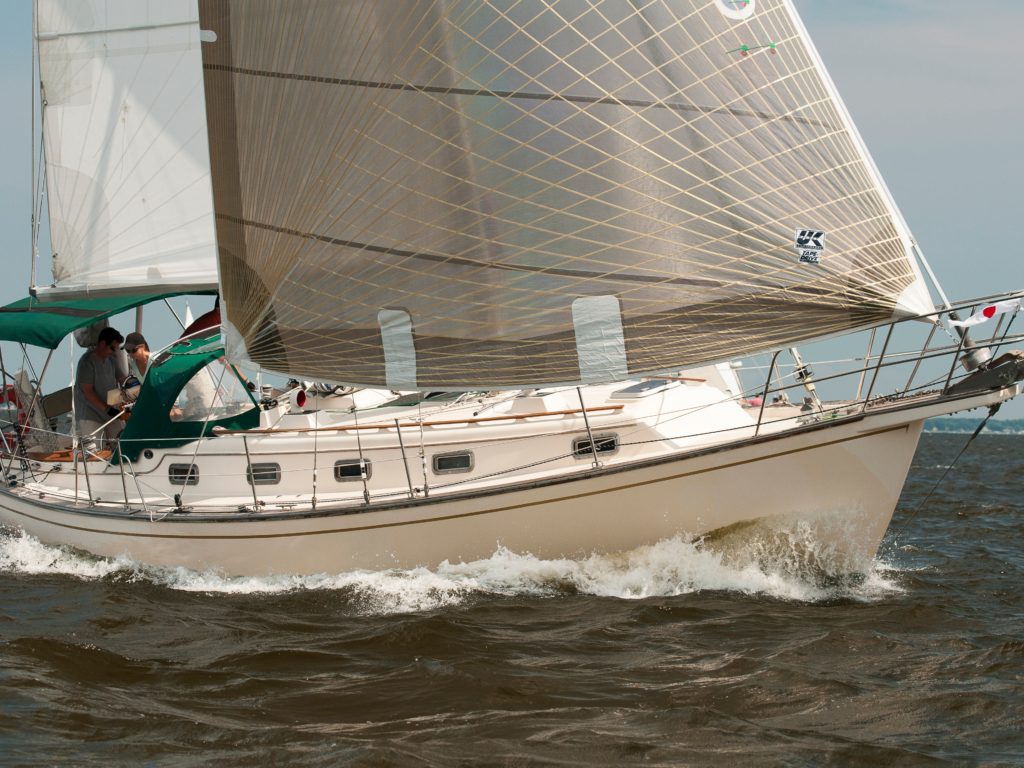
Love them or loathe them, Island Packets are everywhere. To some, the beamy, full-keel, high-freeboard hull designs seem quaint, to put it charitably. To others, the robust construction standards, roomy interiors and overall user-friendliness make them the ideal cruising boat. More than most, sailing vessels are compromises, and Bob Johnson and his crew at Island Packet were brilliant in prioritizing the needs of sailors. The IP 35 was introduced in 1988 and features a huge cockpit, an easy-to-handle cutter rig with a jib boom, and a clever, comfortable interior with the volume of many 40-footers. It might not be the fastest boat upwind, but the long waterline translates to good performance off the breeze, meaning the IP 35 finds its stride in the trade winds. In all, 188 boats were built before production stopped in 1994.
Don’t confuse the IP 35 with the IP 350, which was launched in 1997 and included a stern swim step. You won’t find a 350 for less than $100,000, but you will have a choice among 35s, especially those built before 1990. With two nice staterooms, the 35 is ideal for family cruising. I know of a couple of 35s that have completed the classic Atlantic Circle passage. It’s perfect for a sabbatical cruise because it holds its value and there’s a ready market when it comes time to sell.
Prout Snowgoose 37
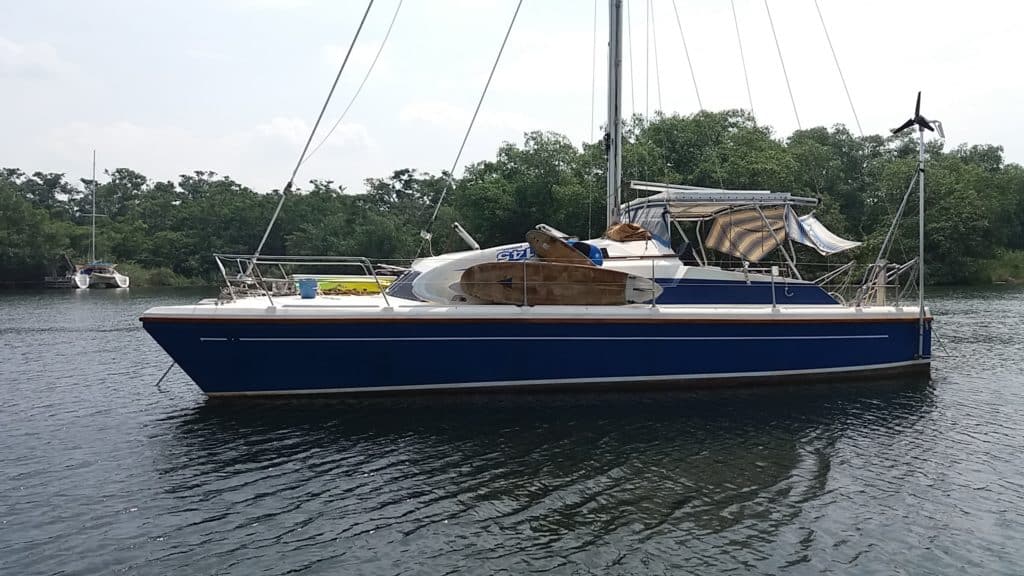
There’s no room for discussion: Catamarans are crossing oceans, and many sailors are choosing cats for world cruising. My last visits to the Azores and Canary Islands, the classic Atlantic waypoints, proved the point. I’m not much of a statistician, but by my count, at least a quarter and maybe a third of the boats I saw were catamarans. There would be more on this list, but they are just too expensive. Finding a quality catamaran for less than $100,000 is tough. One boat to consider is the classic workhorse multihull, the Prout Snowgoose 37.
When the Snowgoose 37 was launched in 1983, English builder Prout & Sons had already been in business for nearly 50 years. The 37 was an updated version of the Snowgoose 35, one of the most successful cruising cats ever. In 1986, the 37 was updated again; the Snowgoose Elite model included more beam and interior upgrades. These models are challenging to find for under $100,000, but it’s possible. A quick glance at yachtworld.com shows several of both models available for less than $100,000. Again, the strong dollar makes European boats an excellent value.
The Snowgoose 37 is not sexy like go-fast cats, and not roomy like modern cruising cats. It is, however, seaworthy. Of the 500 built, many have circumnavigated. Older boats have solid fiberglass hulls, and more recent models are solid glass from the waterline down and cored above. The cockpit is rather compact by catamaran standards, and the bridgedeck is solid (no tramp). Many 37s and all Elites were rigged with staysails, a big plus in heavy weather. The masthead-rigged Snowgoose 37 can be sailed like a monohull offshore, and it’s quite nice not having a huge, roachy mainsail to wrestle with in a storm. With a 15-foot-3-inch beam for the 37 and a 16-foot-3-inch beam for the Elite, it’s easy to find affordable dockage and yards for haulouts. Most boats have three double cabins, making the Snowgoose 37 an ideal family cruiser.
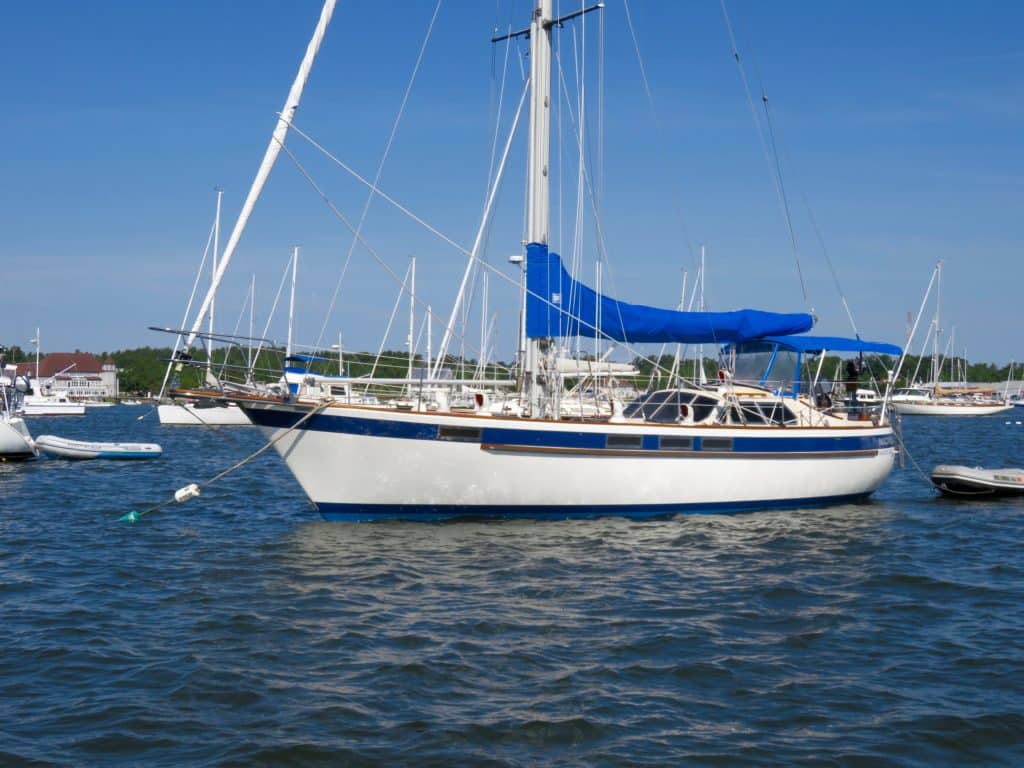
The Corbin 39 is not as well known as it should be. It’s a capable bluewater sailboat cruiser with many impressive voyages logged. My Quetzal spent several weeks moored alongside a handsome 39 in Corfu that had sailed around the world, and I also spent a winter in Malta in the same boatyard as another 39 that had recently crossed the Atlantic. A canoe-stern, flush-deck pilothouse cutter, the 39 was offered with either an aft or center cockpit. Designed by Michael Dufour and constructed by Corbin les Bateaux in Canada, hull number one was launched in 1977. Built in various locations in Quebec, 129 boats were launched before a fire destroyed the deck tooling in 1982. A new deck with a larger cockpit was designed, and 70 more boats were laid up before production ceased in 1990.
The rub on the Corbin 39 is that the majority of boats were sold as kits with owner-finished interiors. Kits varied from just hull-and-deck to “sailaway,” with everything fitted except the interior. Only 15 boats were finished at the factory. Not surprisingly, the interior quality is unpredictable, from rough-hewn lumberyard specials to beautifully handcrafted gems finished by marine professionals. The difference is reflected in the price. A nicely finished, well-equipped model from the mid-’80s typically sells for between $60,000 and $80,000.
The hull shape features a long fin keel and skeg-mounted rudder. The hulls are heavily laid up and include Airex coring. Early decks were plywood-cored, but most boats have Airex in the deck as well. Ballast is 9,000 pounds of internal lead, translating to a 40 percent ballast-to-displacement ratio. The wide flush deck is spacious, and the sleek pilothouse usually includes inside steering. Massive double anchor rollers are incorporated into the bowsprit in later models. Most boats include a double-spreader spar, and almost all were set up as cutters. There’s plenty of freeboard, which becomes obvious below. While interior arrangements vary considerably, there’s a lot of room to work with. I prefer the post-1982 aft-cockpit 39s; they’re generally of a higher quality than earlier boats.
Cabo Rico 38
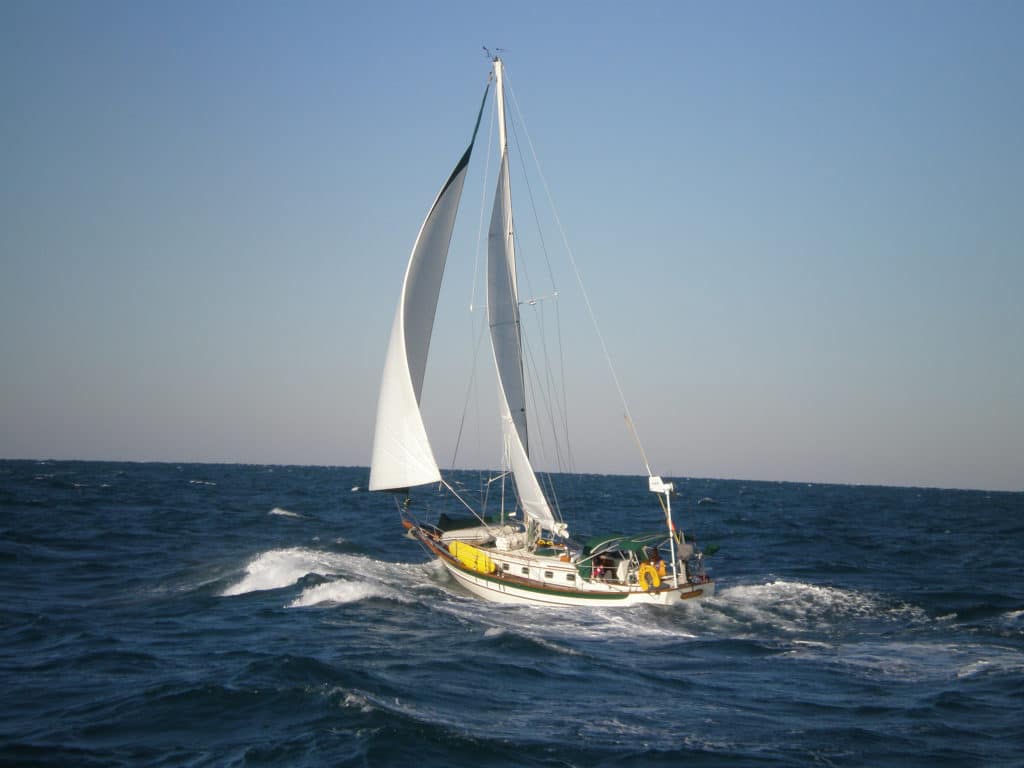
“The Cabo Rico 38 hull shape is the one in which everything came together best,” wrote Bill Crealock in his design notes. He might have changed his mind later in life, considering that the Cabo Rico was introduced in 1977 and he designed many boats after that, but few will dispute that this 38-foot cutter, built in Costa Rica, is flat-out beautiful. From the clipper bow to the sweet sheer to the abundance of honey-colored teak, the Cabo Rico 38 is a boat to inspire the most practical among us to quit their job, buy this vessel, and head for the South Pacific.
Not surprisingly, many people have done just that. Cabo Rico built 200 full-keeled 38s, with most of the production occurring in the 1980s. There’s always a selection of boats for sale for less than $100,000. Cabo Rico was an outlier among manufacturers of the time, building serious cruising boats in Central America instead of Taiwan, but quality control was always excellent. The full keel is slightly cutaway, and the rudder is attached to the trailing edge. The prop is in an aperture and totally protected, but not well suited to backing into a slip. Full-keel boats may make some younger sailors cringe, but the CR 38 has a very soft ride in rough seas and heaves to effectively. It also has a solid fiberglass hull with a layer of balsa for insulation. Sometimes it’s noted that the hull is balsa-cored, but it’s not. After about hull number 40, lead was used instead of iron for internal ballast. The deck is balsa-cored, however, and there’s a substantial bulwark. Items to be wary of are the teak decks (most 38s have them) and the fittings supporting the bobstay.
A true cutter rig, the 38 has just under 1,000 square feet of working sail area and performs better than most people suspect. The staysail was originally set on a boom that cluttered the foredeck and limited sail shape. Many boats have been converted with furling staysails sans the boom — a nice upgrade. When the wind pipes up, the 38 tracks nicely with a reefed main and staysail. I encounter 38s all over the Caribbean. They’re easy to spot; they’re the beautiful boats in the anchorage.
Tayana Vancouver 42
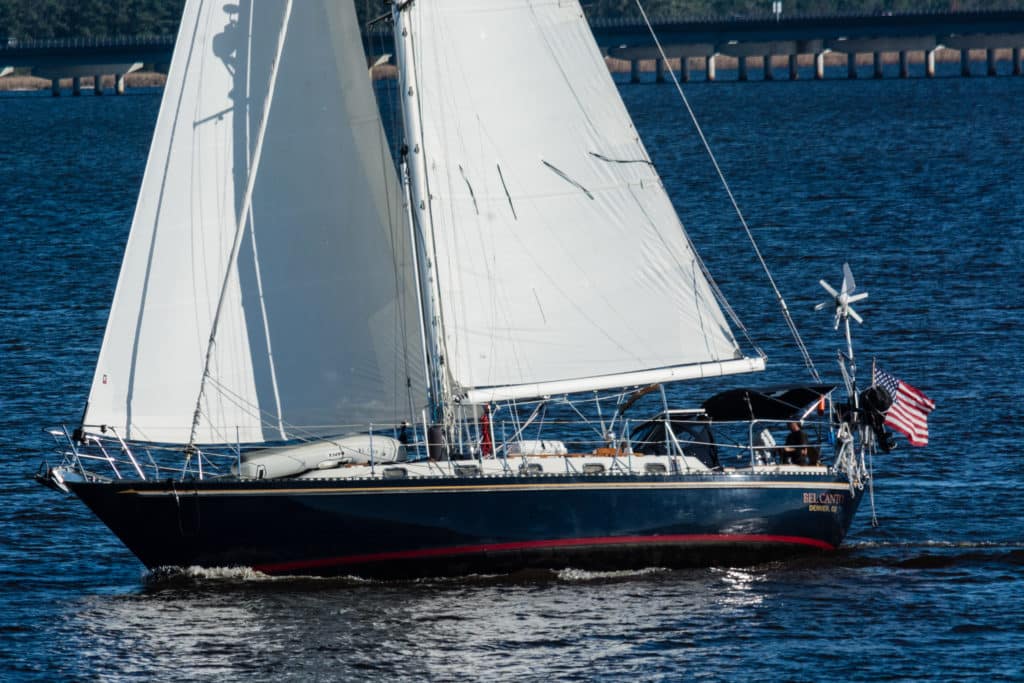
Ta Yang, builder of Tayana sailboats, has been building capable cruising boats forever, it seems. The Robert Harris-designed Tayana Vancouver 42 has been a mainstay of the serious cruising fleet since the day it was launched in 1979, and is still in demand today. The company built 200 boats, mostly in the ’80s and early ’90s, although a few V42s were built into the 2000s. With a bit of digging and some haggling, you can find boats for less than $100,000, but they’re likely to be older models. As of this writing, yachtworld.com has eight V42s listed, with three asking less than $100,000.
I’ve encountered the V42 all over the world, and in my yacht-delivery days, I had the pleasure of delivering a couple of 42s up the East Coast and down to the Caribbean. The double-ended hull shape with a fin-skeg underbody is stiff and seaworthy, if not wickedly fast. Considering the rugged construction, with a solid fiberglass hull and balsa-cored deck, nobody has ever accused Ta Yang of going light on its boats. Ballast is internal iron, a massive single casting that weighs in at 11,800 pounds. Ta Yang has evolved as a builder, and later models included upgrades like vinylester resin and larger Yanmar diesels.
A true cutter, the V42 has a double-spreader rig and is heavily stayed. The seagoing deck is cambered to shed water. Teak decks, with all their virtues and vices, were common; I’d look for a boat that’s been de-teaked. Like the Corbin 39, the V42 came with either a center or aft cockpit, although most boats were aft-cockpit models. The aft cockpit is deep and secure, if a bit tight due to volume sacrificed by the canoe stern. The center cockpit is cramped but offers excellent visibility. The interior is lovely, with exquisite Taiwanese joinery. Although interior arrangements vary because Ta Yang encouraged owner input, across the board, this is a friendly boat for living aboard. The aft-cockpit model includes one head and a traditional layout with excellent light and ventilation. The center-cockpit model features a large owner’s stateroom aft.
Wauquiez Pretorien 35
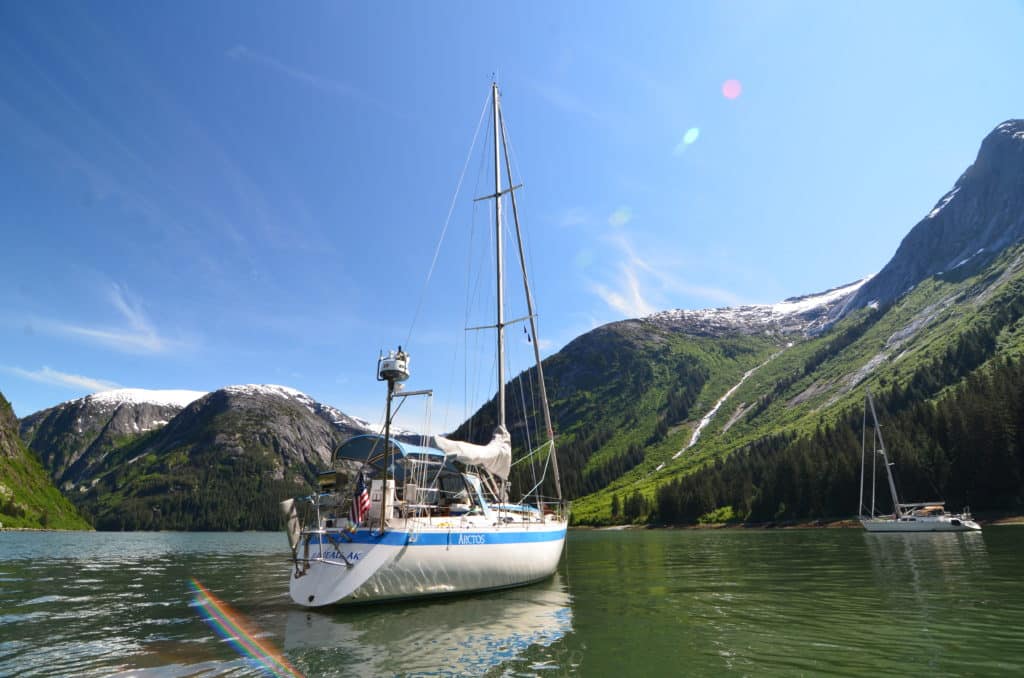
The Pretorien 35 does not pay homage to tradition. The Euro-style low-slung wedge deck and flattish lines were thoroughly modern when the Pretorien was launched in 1979. Sure, there are IOR influences in this well-proven Holman & Pye design, including a slightly pinched stern, cramped cockpit, and a high-aspect, short-boom mainsail that results in a large foretriangle. But a small main is easy to handle offshore, especially in squally conditions, and a large poled-out furling genoa provides a low-stress way to cross oceans. The test of a design is revealed long after the launch, and the Pretorien has aged brilliantly. It’s often mistaken for a Swan or Baltic. Famed voyager and author Hal Roth chose a Pretorien for his last boat.
Below the water, which is what really matters at sea, the Pretorien pushes the right buttons for serious sailing. A fine entry provides enough of a forefoot to prevent pounding in lumpy conditions, and as on the Valiant 40, the fin keel incorporates a stub to which the external ballast is fastened. The rudder is mounted well aft for excellent steering control, especially on a deep reach, and is tucked behind a narrow but full-length skeg. The Pretorien displaces 13,000 pounds, of which 6,000 pounds is ballast, translating to a stiff, seakindly boat.
The construction is superb. The solid fiberglass hull includes longitudinal stringers that stiffen the panels and encapsulate the bulkheads. Tabbing and fiberglass work is first-rate throughout. Wauquiez was one of the first builders to use solid laminate beneath high-load deck fittings. The side decks are wide and, with the chainplates well inboard, easy to navigate. The interior arrangement is conventional, but ample beam amidships helps create a surprisingly spacious feel below.
There were 212 Pretoriens built during a seven-year production run, so there’s usually a good selection of boats on the used market. Today’s strong dollar makes European Pretoriens an excellent value.
Gulfstar 44
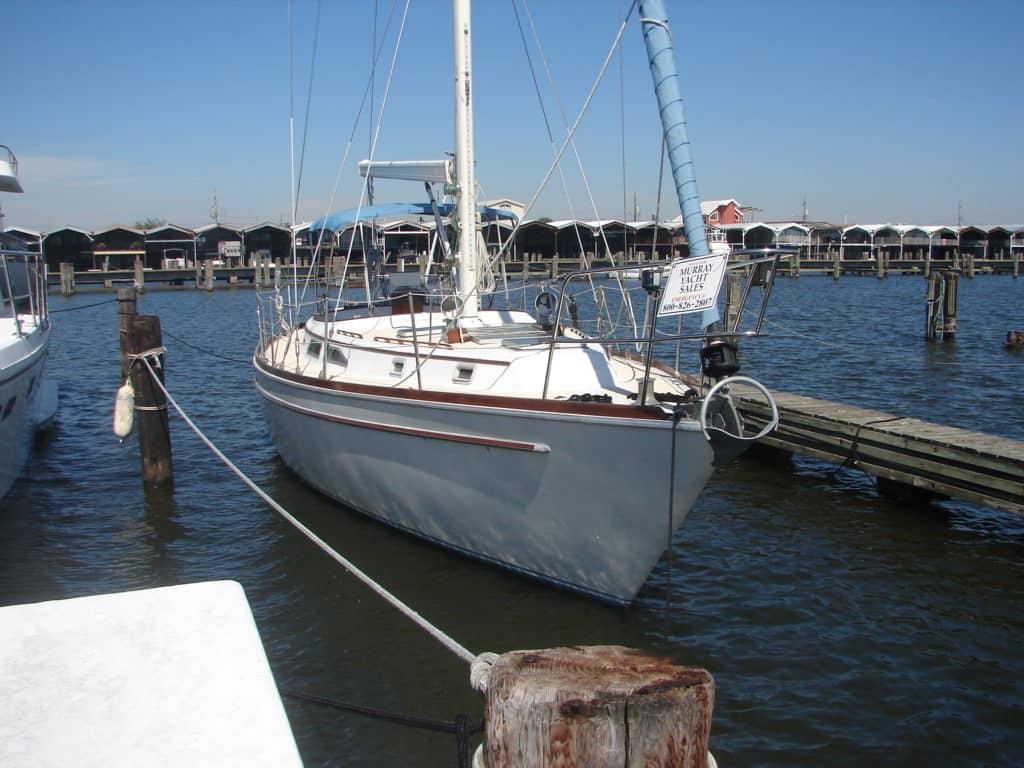
Gulfstar had a terrible reputation in the early ’70s: It was infamous for producing wide-body motorsailers with tiny rigs and chintzy Formica interiors. Company founder Vince Lazzara was adept at reading market trends and upped his game in the late ’70s and ’80s. Lazzara, who also founded Columbia Yachts, was a veteran of the production-sailboat wars and realized that buyers were demanding high-quality boats that sailed well. The Gulfstar 44 was launched in 1978, and 105 were sold before the company started producing the Hirsh 45 in 1985.
Some mistake the G44 for a Bristol, and it has a similar profile, right down to the teak toerail and raked cabin trunk. A sleek center-cockpit design, the hull shape features a 5-foot-6-inch fin keel, a skeg-hung rudder and moderate proportions. I know the boat well, having delivered one from Bermuda to Annapolis and another from Fort Lauderdale to Boston. It has a nice ride in lumpy seas and powers up when the big genoa is drawing on a reach. The construction is typical of the time, with solid fiberglass hulls and cored decks. Gulfstars were known to blister, and it’s likely that any 44 you find will have had an epoxy bottom job along the way — and if it hasn’t, it will need one. The keel-stepped spar has an air draft of 55 feet. Some owners have modified the sloop rig with a staysail. The cockpit is roomy, especially for a center-cockpit design, although there’s not much of a bridgedeck. All sail controls are led aft. Lazzara was an early proponent of this feature, and the boat is user-friendly overall.
The interior sells the boat. It’s nicely finished in teak, and the layout is made for living aboard. The aft cabin includes an enormous double berth with an en suite head and stall shower. The main saloon is spacious and well ventilated, although beware of the plastic opening portlights. If you are looking for a comfortable, well-built center-cockpit cruiser but can’t find one that you can afford, track down a Gulfstar 44; you’ll be pleasantly surprised.
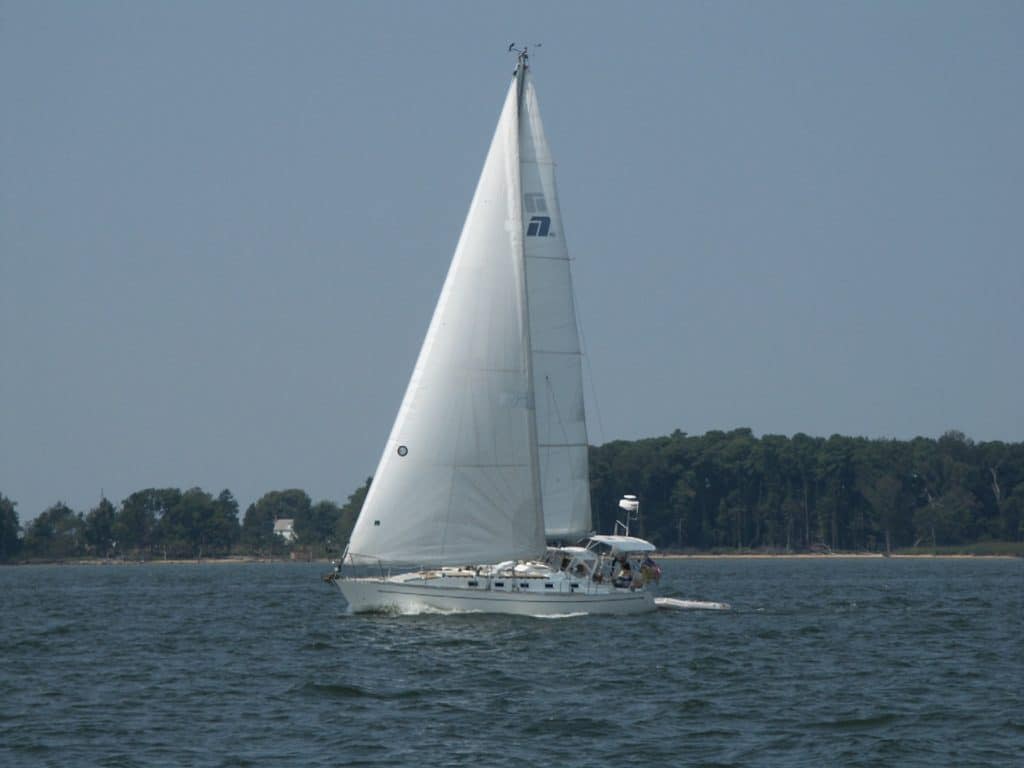
Any list of bluewater cruising sailboats must include a Robert Perry design. I could have easily put together nine Perry boats for this list. The Nordic 40 may surprise some, especially because 40 feet is an iconic length, bringing to mind such boats as the Valiant 40, Hinckley Bermuda 40, Bristol 40, Pacific Seacraft 40, Passport 40 and others. The trick is finding a 40-footer for less than $100,000. Nonetheless, the Nordic 40 and its larger sister ship, the 44, are among my favorite boats.
Based in Bellingham, Washington, Nordic produced world-class yachts during its brief production run in the 1980s. Only 40 Nordic 40s were launched between 1982 and 1987, but they’re worth seeking out on the used-boat market. The 40 features the classic double-ended Perry hull shape, with a fine entry, a deep and powerful fin keel, a skeg-mounted rudder positioned well aft, and a reverse transom. Freeboard is moderate and the sheer line is subtle, but to my eye, with its double-spreader rig and gently sloping deck line, the boat is poetry in the water.
The hull is solid fiberglass and the deck is balsa-cored, with solid laminates below loaded-up deck fittings. Original boats came with Navtec rod rigging and a hydraulic backstay, but many have been upgraded by now. Sail-control lines are led aft to the compact but functional T-shaped cockpit. The traveler is forward of the companionway, allowing for a cockpit dodger. The Nordic 40 is nimble in light to moderate breeze but can also stand up in a blow and heave to decently.
The interior is well suited to a cruising couple. It’s really a two-person boat, with a V-berth forward and large C-shaped galley aft, with plenty of counter space and a huge fridge. It includes the normal deft Perry touches — excellent sea berths, a separate stall shower and generous tankage. If you do find a Nordic 40 on the used market, be sure to take a hard look at the Westerbeke diesel and the V-drive transmission.
Pacific Seacraft 34
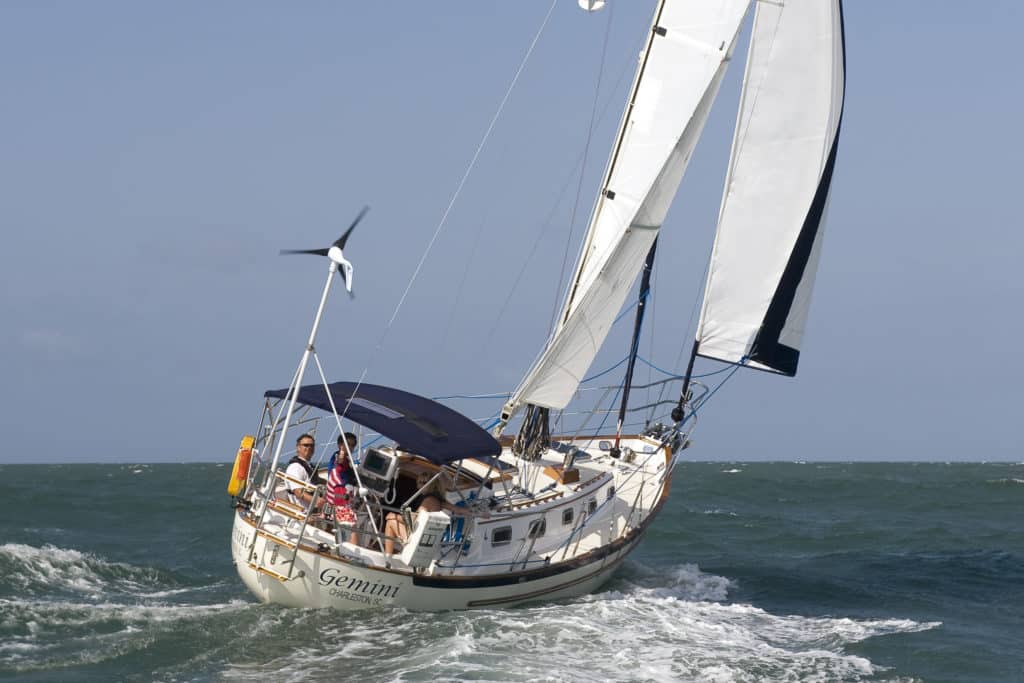
A handsome, nimble and capable double-ender by legendary designer Bill Crealock, the Pacific Seacraft 34 is well proven, with scores of ocean crossings in its wake.
After the boat was first launched as the Crealock 34 in 1979, Pacific Seacraft introduced a fifth model years later, a scaled-down version of the popular PS 37. Though expensive at the time, the 34 was another success story for one of America’s premier builders, and hundreds of boats were built in the company’s yard in Santa Ana, California. There is always a good selection of used boats available for less than $100,000. Another nice perk for used-boat buyers is that the 34 is back in production at the reincarnated Pacific Seacraft yard in Washington, North Carolina, providing an outlet for parts and advice. The company is now owned and operated by marine archaeologist Stephen Brodie and his father, Reid.
The 34 blends traditional values above the waterline with what was then a more modern underbody, with a long fin keel and skeg-hung rudder. A bit hefty at 13,500 pounds of displacement, the design otherwise is a study in moderation, and drawn with a keen eye toward providing a soft ride in a seaway and staying on good terms with Neptune in a blow.
The hull is solid fiberglass, and early decks were plywood-cored before Pacific switched to end-grain balsa. The hull-to-deck joint incorporates a molded bulwark that offers added security when you’re moving about on deck, and a vertical surface for mounting stanchions.
Most 34s are cutter-rigged for versatility but carry moderate-size genoas instead of high-cut yankees for more horsepower off the wind. Down below, the layout is traditional, but the 6-foot-4-inch headroom is a pleasant surprise. The Pacific Seacraft 34 is perfect for a cruising couple.
John Kretschmer is a delivery captain, adventurer and writer, whose own boat Quetzal , a 1987 Kaufman 47, has seen a refit or two over the years. His latest book is Sailing a Serious Ocean: Sailboats, Storms, Stories and Lessons Learned from 30 Years at Sea , also available on his website .
- More: classic plastic , DIY Sailboat Projects , Sailboat Reviews , Sailboats , used boat guide
- More Sailboats
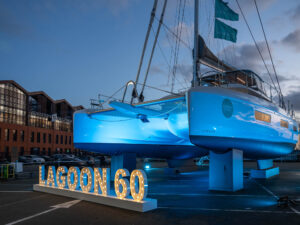
Lagoon 60 Prepares for World Premiere
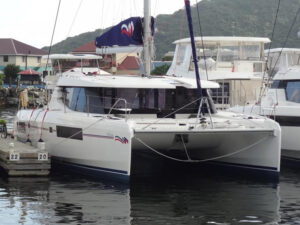
Now For Sale: Leopard 45
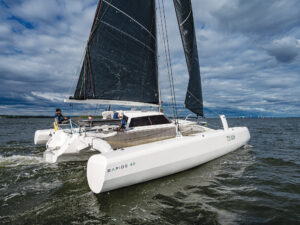
Sailboat Review: Rapido 40
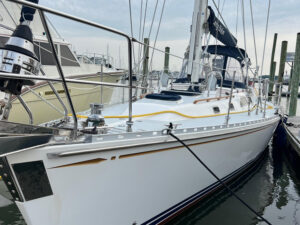
For Sale: 2002 Hylas 46
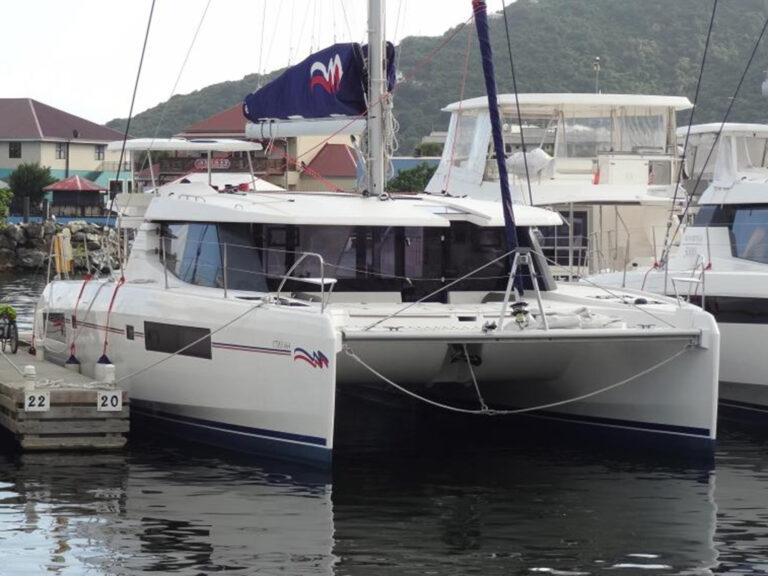
The Long Way Around

Sailing to the Land of Shrimp
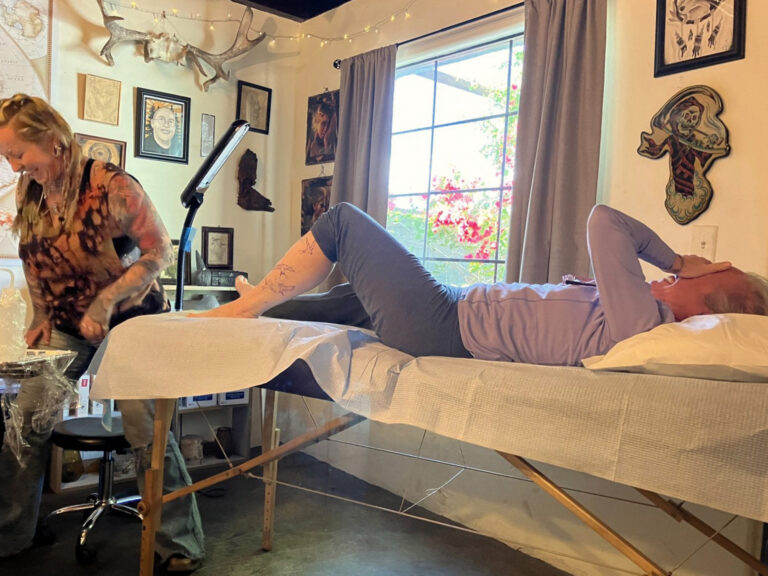
Swallow Tattoos and Sailors
- Digital Edition
- Customer Service
- Privacy Policy
- Email Newsletters
- Cruising World
- Sailing World
- Salt Water Sportsman
- Sport Fishing
- Wakeboarding
- Yachting World
- Digital Edition

The rise and rise of double-handed racing
- August 17, 2021
Double-handed racing has been the stand-out success story of recent years. James Boyd finds out why it’s so popular

If ever the stars aligned to see a sport’s popularity grow exponentially, they did so for the recent story of double-handed racing offshore.
Societal changes, a brief hint of a future Olympic Games role, and even social distancing all conspired to make double-handed racing a phenomenon. Add in a high level of competition, plus the increasing availability of purpose-designed yachts, and the growth in the double-handed scene has been explosive.
One of the most surprising developments of the last decade is just how competitive double-handed offshore racers have become against fully crewed boats.

Pascal and Alexis Loisin won the 2013 Rolex Fastnet overall in their JPK 10.10 Night and Day. Photo: Kurt Arrigo
Nowhere was this better demonstrated than in the 2013 Rolex Fastnet Race when Cherbourg surgeon Pascal Loison and his pro-sailor Figarist son Alexis, sailing their JPK 10.10 Night And Day , won not only the race’s Two-Handed class and the hotly contested IRC 3 class, but also the race outright on IRC against a giant field of 294 boats. Among their opponents were 249 fully crewed boats featuring several top international campaigns.
Double-handed competition in the Fastnet has now reached the stage where IRC 3 is entirely dominated by double-handers, with nine of the top 10 spots in 2019 occupied by two-man crews in the Royal Ocean Racing Club’s biennial offshore.
The class was again topped by Alexis Loison, then sailing with Jean Pierre Kelbert aboard the French boatbuilder’s own JPK 10.30 Léon .
But the most telling statistics from the Rolex Fastnet Race show how massively double-handed offshore racing has grown in popularity. An IRC Two-Handed class was first introduced to the Rolex Fastnet Race in 2005 when it had 20 entries. This grew to 36 in 2011, then to the last race when there were 64.
At the time of writing no fewer than 91 two-man crews were entered in IRC Two-Handed for the 2021 edition of the race, contributing to the event’s record-sized fleet of 450-plus boats.
From small beginnings
So, how has this come about? Double-handed offshore racing has a longer history than its recent boom might suggest. It was created in the UK during the 1960s and 1970s by visionaries such as Cockleshell Heroes leader Blondie Hasler, born out of a pioneering spirit and a demand for adventure following the end of World War II.

Cockleshell Heroes leader Blondie Hasler (left). Photo: Ajax News/Alamy
Hasler encouraged the Royal Western Yacht Club in Plymouth to run the first Observer Single-handed Transatlantic Race (OSTAR) in 1960, which by 1976 had become a monster event with 125 boats. But equally stirring the imagination were the RWYC’s double-handed events, and Hasler spurred the club to run the first double-handed Round Britain and Ireland in 1966 with four stops: Crosshaven, Ireland; Castle Bay, Barra in the Outer Hebrides; Lerwick, Shetland; and Harwich (subsequently replaced by Lowestoft).
The inaugural event was won by Derek Kelsall and Martin Minter-Kemp aboard the trimaran Toria, inadvertently also demonstrating the early potential of multihulls for offshore racing.
The TwoSTAR was later created as the double-handed version of the OSTAR, running from Plymouth to Newport, Rhode Island, and first held in 1981.
However, thanks largely to the notoriety of Eric Tabarly, the OSTAR winner in both 1964 and 1976, French race organisers spectacularly – and in the most magnificently successful way – hijacked both the sporting and business elements of short-handed offshore racing.
On the single-handed side this kicked off with the Route du Rhum in 1978 and the Vendée Globe in 1989, but there were also significant double-handed events such as the Transat en Double (first run in 1979) and the Transat Jacques Vabre , held biennially since 1993.

Apivia, IMOCA 60 sailing double-handed in the 2021 Rolex Fastnet Race
Nowadays, top level double-handed offshore racing takes place in France across all the pro fleets from the IMOCA s, to the Figaro class (notably with their Transat AG2R transatlantic race), to the Class 40 (Normandy Channel Race and Les Sables-Horta-Les Sables) and a multitude of events in the Classe Mini.
Today the Royal Western Yacht Club’s short-handed events still take place on the same great courses, but are purely Corinthian. Meanwhile, over the last 20 years in the UK the amateur side of double-handed offshore racing has been growing steadily and organically.
Whereas once it was broadly acceptable to leave work on a Friday lunchtime and not return until the following Monday afternoon, weather beaten and full of rum and tall tales, this is no longer the case.
Today’s ‘time poor’ society has resulted in owners of race boats finding it ever harder to muster committed, reliable crew. Racing double-handed provides a neat solution: fewer crew to organise and pay for and a smaller, cheaper boat to campaign.

Rob Craigie and Deb Fish race the Sun Fast 3600 Bellino. Photo: Paul Wyeth
Rob Craigie and Deb Fish, who race the Sun Fast 3600 Bellino , began racing two-up together in 2012 and are among the UK’s best Corinthian double-handers. Both previously raced fully crewed, and have even tried single-handed, but settled on racing as a team of two.
The main attraction, said Fish, is the challenge: “You run out of them fully crewed – I’d done the Fastnet, done transatlantics on the ARC a couple of times fully crewed, and the deliveries back. Double-handed is good, because you have to do everything and you are always busy.”
Craigie agreed: “You are very much more involved with the boat. Fully crewed, you are usually sitting on the rail, you aren’t involved, which is a bit dull.”
Over the last two decades, racing for the likes of the Bellino crew has been supported in the Solent by clubs like the RORC, the Royal Southampton and JOG, which have either laid on specific series for double-handers or allowed them to race alongside their fully crewed fleets.
The pattern is repeating worldwide – Rhode Island, San Francisco and the Great Lakes in the US have thriving double-handed communities, and the cancelled 2020 Rolex Sydney-Hobart Race was set to be the first to include a double-handed division.
The medal draw
More recent developments helped an already growing sector of the sport turn supernova. In 2019 mixed offshore double-handed racing was mooted for inclusion in the Paris 2024 Olympic Games , and proposed to the International Olympic Committee by World Sailing.

Kevin Rawlings and Stuart Childerley took 2nd place in the RORC Two-Handed Series with Aries. Photo: Rick Tomlinson
During the event selection process, which is notorious for its politics and power-mongering, it was rejected earlier this month by the IOC in favour of an additional formula kiteboarding medal. It is a huge shame that France, the world’s top nation for short-handed offshore racing won’t host an Olympic event that could engage a vast number of its sailing fans.
Nonetheless even the possibility of double-handed offshore racing becoming an Olympic sport enticed a whole crop of top flight international sailors to move into the fleet.
Titans of our sport such as Ken Read in the USA, Shirley Robertson and Dee Caffari in the UK, and Nick Moloney and Adrienne Cahalan in Australia have all got involved. It has also caused yacht clubs across the globe to start supporting double-handed racing with class events.
Many clubs were further encouraged to increase their support of short-handed racing due to the pandemic. For example, in the UK, due to social distancing restrictions, double-handed racing was the first non-elite aspect of competitive sailing to recover after last spring’s lock-down. Even without the Olympic factor, double-handed racing looks set to continue expanding.
Dee Caffari says she was initially encouraging members of her Turn the Tide on Plastic Volvo Ocean Race crew to consider the new Olympic discipline before deciding to give it a go herself.
The opportunity was spurred when she was contacted by a young sailor, James Harayda, who was taking delivery of a new Sun Fast 3300 Gentoo . During 2020 this led to the duo representing the UK at the EUROSAF Mixed Offshore European Championship, where they didn’t do well, but followed this up with a 2nd place in the Drheam Cup in France, and winning the RORC-organised IRC Two-Handed Nationals. This year they are entered in the Rolex Fastnet Race.
“The focus was generated by its Olympic potential, but actually I have found it is a really competitive class of racing that has been really good fun to sail, and I have just really enjoyed regular racing,” said Caffari, who raced double-handed in the IMOCA class in two Transat Jacques Vabres and a Barcelona World Race.

Dee Caffari is loving sailing double-handed with James Harayda in the Sun Fast 3300 Gentoo. Photo: Paul Wyeth
The principal differences between the double-handed racing she has done aboard her IMOCA and in Gentoo are scale-related.
Transatlantic on an IMOCA, racing is more about chasing weather systems, whereas on Gentoo the much shorter courses are more about boat-on-boat tactics and tidal decisions. A 32-footer is vastly more manageable than even a purpose-built IMOCA, but the racing in what is effectively a one design fleet, is far more intense, with much less use of the autopilot.
Caffari explained: “Everything is loaded really well, it is manageable and within reach and there’s nothing that’s too difficult to get out of. It’s all just about getting the procedures so that you know what is required – what wind strength you need to dial down in before you can drop the kite, or ‘in this wind strength I know I can gather it in myself’.”
New double-handed racing tools
Part of the beauty of double-handed racing is that many owners compete on the boat they already have. However, as double-handed racing under IRC has risen in popularity, manufacturers – particularly those in France – have responded with new designs specifically optimised for short-handed racing.
They notably include Jeanneau , with its Sun Fast range, and JPK . Both have created boats that IRC smiles upon; such as the Loison’s 2013 Rolex Fastnet Race winning JPK 10.10. In 2015 Géry Trentesaux’s won the Fastnet outright aboard a JPK 10.80, which can be configured for racing fully crewed or short-handed.
Nigel Colley heads the UK Jeanneau dealership Sea Ventures, and is a keen short-handed sailor himself. Few have observed the development of these boats as closely. “It started with the J/105, which is still an excellent short-handed boat, but then the JPK and Sun Fasts came along. They don’t race as one designs but they can race on a level-ish playing field under IRC.”
For Jeanneau the breakthrough boat was the Sun Fast 3200 launched in 2008. This was purpose-designed for the French Transquadra race, a transatlantic race for amateur over 40-year-olds. “They didn’t make it extreme – it could have been lighter with a taller mast but they ended up with a boat that was perfect for double-handed and short-handed racing, which was manageable with a competitive IRC rating,” says Colley.

The Dehler 30, one of the new generation of double-handed favourites.
The genre has evolved further with the more recent Sun Fast 3300 and JPK 1030, as well as the J/99 and Dehler 30 . A key factor in their being tailored to short-handing is their inherent stability, gained from hull form and water ballast, allowing them to carry sail without having to reef too often.
According to Colley they have high ballast ratios of 40%, while water ballast is modest, 200 litres on the Sun Fast 3300 for example, or “the same as having three people sitting on the side of the boat.”
That French IRC designs are leading the way in this offshore sector should come as no surprise given the huge amount of development that takes place in offshore classes across the Proto Minis and Class 40s up to the IMOCAs.
Over past decades this has prompted the development of everything from roller furling systems, self-tailing winches and autopilots to twin rudders, and even the evolution of cockpit layouts with all lines from the foredeck and mast led aft to the cockpit.

The slightly scow-bowed Jeanneau Sunfast 3300. Photo: Jean-Marie Liot
Another visible influence is the highly effective (but to some eyes rather ugly) scow bows we are more used to seeing on modern grand prix race boats are now adopted by IRC 30-footers.
Sails for short-handed racing have been refined so, instead of having a giant wardrobe spanning the entire range of wind speeds and points of sail, fewer sails can be carried to cover a wider range, including jibs and even spinnakers that can be reefed, to minimise time consuming and potentially risky sail changes.
As boats and their gear are getting lighter they are in turn less loaded. A Sun Fast 3300 weighs 3,500kg compared to the volumetrically smaller Sigma 33 at 4,100kg. The new designs are also much more inclined to plane, rather than ‘dig themselves a hole in the water’, helping to keep loads light.
Upping the level
While the hardware is improving so are the sailors. When it comes to training for offshore racing the Pôle Finistere Course au Large in Port la Forêt has been considered the best in the world for decades, initially for Figaro sailors but now across all the major offshore fleets. Similar centres have started up across France, with training now extending even into the IRC classes.
With the prospect of double-handing going Olympic training for the discipline greatly improved in the UK too, supported by both the RYA and the RORC. Tornado Olympic sailor turned coach Hugh Styles has been brought in to help. He provides weather information and analysis pre-race and post-race debriefs.
While in Port la Forêt this might take the form of classroom sessions, in the modern locked-down era Zoom debriefing and training sessions have proved just as effective, and in fact work especially well with the double-handed fleet spread across the Solent. It is not only the aspirant Olympians who’ve been keying into this, but all levels.
Double-handed offshore racing in the UK has also benefitted from getting ‘organised’. Leading this is former Artemis Offshore Academy star turned Volvo Ocean Race sailor Henry Bomby , who has been racing with double Olympic gold medallist Shirley Robertson.

Henry Bomby and Shirley Robertson double-handing on the Sun Fast 3300 Fastrak XII. Photo: Tim Butt/Vertigo Films
He has led the formation of the UK Double-handed Offshore Series, which comprises the leading RORC races and Round the Island Race in the build-up to this year’s Rolex Fastnet. The Series is for boats with an IRC TCC of between 0.990 and 1.055, which covers most of the double-handed fleet.
The group behind it includes Bomby; Stuart Childerley, a former Olympian, Etchells World Champion and world class race officer; plus 19-year-old Ellie Driver and Corinthian sailor Kate Cope; thus a broad range of double-handed offshore racers are represented. Expecting to get a handful of boats signing up to their Series, much to their surprise 29 boats pitched up to their first event in early May.
While the 2021 UK season is fully domestic due to the pandemic and Brexit, Bomby hopes to include French events in the future such as Spi Ouest-France or the Drheam Cup, thereby in turn encouraging more French boats to participate in the UK. Colley also believes that in future there will be more short-handed racing internationally under ORC.
Bomby is particularly keen to push the encouragement of youth sailing. Great existing initiatives include Gavin Howe, owner of the J/88 Tigris , lending his boat to an under-25 year old crew to use. “The best model is an owner who pays for the boat and a young guy or girl who puts the boat in the water, trains with them on Friday, races at the weekend and does it again the next week,” says Bomby.
The double-handed fleet now offers the closest offshore racing in the UK. Bomby points out: “This is not the Figaro, but it is close enough that when you’re sailing away from a boat which is the same as yours you know you are going pretty well.” Especially if it has the likes of Shirley Robertson or Stuart Childerley on the helm.
If you enjoyed this….
Yachting World is the world’s leading magazine for bluewater cruisers and offshore sailors. Every month we have inspirational adventures and practical features to help you realise your sailing dreams. Build your knowledge with a subscription delivered to your door. See our latest offers and save at least 30% off the cover price.
- Sign In or Register
- Boats for Sale
- Research Boats
- Sell a Boat
- Search Alerts
- My Listings
- Account Settings
- Dealer Advertising
- Double Ender Sailboat
Double Ender Sailboat Boats for sale
Sailboat Westsail 28' blue-water cruiser cutter double ender single hander.
Sneedville, Tennessee
Posted Over 1 Month
Cutter rigged full keel blue-water sailboat. This vessel has a 24hp Volvo MD-11c engine that is very dependable and great on fuel. Due to this engine it is registered as an antique for $6-8.00 a year registration fee.The boat is set up for single handed sailing with new standing/running rigging, 3-sails, roller furled, Nor Vane wind vane auto pilot (new), compass, 2-VHF Standard Horizon radios 1 with plotter and black box depth - temp - fish finder and an additional Standard Horizon chart plotter mounted on the hard top for quick reference. There is also a back up Nav. Comm. depth and speed mounted in the cockpit, 3-anchors, fiberglass cockpit hard top (new), 2-60w solar panels, 2-20lb propane tanks, practically new aluminum 50 - 55 gal fuel tank, 2 new wet cell batteries, 40 gal fresh water bladder tank (new), water pump (new), macerator pump (new), 20-gal holding tank (new), new toilet, 2 - burner propane stove with broiler, a microwave, AM/FM radio and CD player, 2-Off Shore inflatable and 2-Off Shore orange life preservers. I installed a new bowsprit about 2 months ago and have had the bright work varnished over the last couple of months. I also installed a new big screen TV and a new Blue Ray disc player and many more custom features such as a built in tool box with tools mounted in the engine room.
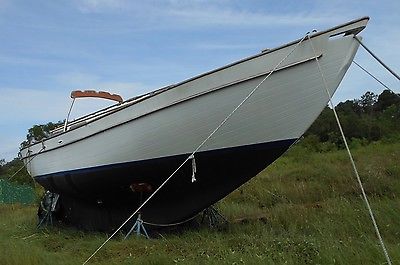
33' Rough Water Sailboat 1983
Slidell, Louisiana
Make Roughwater
33' Rough Water Sailboat 1983 OBO - $15500 condition: fair engine hours (total): 50 length overall (LOA): 33 make / manufacturer: 33' model name / number: Roughwater propulsion type: sail 33' Rough Water Sailboat 1983 is a Thomas Gillmer designed Roughwater 33 built in Taiwan in the Late 70's. She has a hand-laid fiberglass bulletproof hull. She's a strong sturdy double ender and was made to cross oceans. And so you shall. Hull Type: Long keel w/trans. hung rudder Rig Type: Masthead Sloop LOA: 33.08' / 10.08m LWL: 26.00' / 7.92m Beam: 9.75' / 2.97m Listed SA: 460 ft2 / 42.73 m2 Draft (max.) 4.75' / 1.45m Draft (min.) Disp. 15000 lbs./ 6804 kgs. Ballast: 5000 lbs. / 2268 kgs. SA/Disp.: 12.14 Bal./Disp.: 33.33% Disp./Len.: 381.00 Designer: Thomas Gilmer Builder: Tao-Yuan Boatyard (TAIWAN) Construct.: FG Bal. type: First Built: 1975 Last Built: 1985 # Built: AUXILIARY POWER (orig. equip.) Make: Yanmar Model: 2HM20 Type: Diesel HP: 20 Have Mast, Sails, Rigging, and Bow Sprit $15500 OBO

Very Rare 19 ft Southern-sail Skiffle sailboat motor and trailer turn key!
Miami, Florida
Make Southernsail Skiffie
FINAL REDUCTION BEFORE SHE'S OFF THE MARKET! FROM 7500 TO 6000!!Very Very Rare! only a hand full were made, Skiffie 1982 19 ft Southernsails Inc, (XUT) with a Johnson sailmaster 7.5 extra long shaft double- ender lapstrake heavy fiberglass sailboat in pristine conditions ( Faiths ) hull is shinny and smooth with great lines, main sail is great, working jib also, she was built by southernsails Inc in Clearwater Florida, has new varnished tiller handle with cover, Bimini top with boot cover, new Tung jack. tiller tamer new, wind indicator, lines, custom mast holder made out of aluminum, new chocks, anchor and rod new, cushions, recently rebuild entire tandem trailer with custom bunks ,new keel guides, supports, new axles, hubs, 4 new wheels and a new spare with carrier and cover, new Led trailer lights, safety chains, bow stopper, winch, strap, recently had bottom professionally painted, have Florida title and trailer registration on hand!, please serious inquiry's only. Many Thanks.LOA 19FIXED KEELBEAM 6"8DRAFT 2ftDISPLACEMENT 1900 lbs.SAIL AREA 143 sq.ftOUTBOARD MOTOR WELLSELF BAILING COCKPIT.
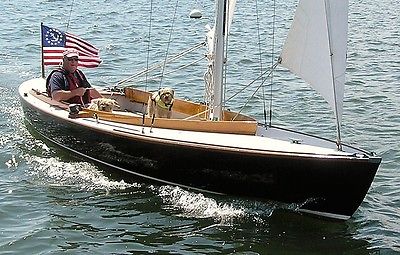
Sakonnet 23 Daysailer, Built by Edey & Duff, Designed by Joel White, Sailboat
Greenville, South Carolina
Make Sakonnet
Category Daysailer Sailboats
Length 23.2
15.00 Built by Edey & Duff, the Sakonnet 23 is one of the prettiest daysailers you will find. Refreshingly handsome from all angles and super-swift as well, this distinctive double-ender is ideal for the experienced sailor who wants a roomy, inshore daysailer for weekend and evening sailing with family and friends. What’s more, her true hull speed and modern high-aspect rig make the Sakonnet 23 a most competitive one-design class racer.We have owned this boat since 2007. She has been well-maintained and is in excellent condition. Please contact me for additional information and more photos. BUILDER/DESIGNER Builder: Edey & Duff (built in 2005) Designer: Joel White DIMENSIONS LOA 23’2” – LWL 18’8” Beam 6’1” – Displacement 2000 lbs Draft 1’10” – 5’2” – Ballast 920 lbs MOTOR & ELECTRICAL Factory Installed – Minn-Kota electrical motor 12 volt Interstate battery 24 MRO 500 amps Pro Sport 20 fully automatic/electronic multi-stage marine charger Electrical wiring, switch with meter Mast headlight AH 800 Tiller pilot Electrical and manual bilge pumps SAILS & RIGGING Mainsail by Harding Jib by Harding with UV protection Roller furling New boat and sail cover Sails cleaned and maintenance performed by Sail Care 6/15 Harken winches, whisker pole eye ADDITIONAL INVENTORY Triad galvanized trailer with extending tongue Lifting bridle Normal 0 false false false EN-US X-NONE X-NONE
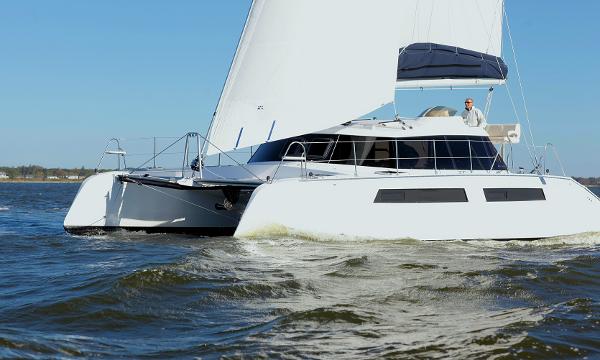
1980 Corbin 39 Aft Cockpit Cutter
Clearwater, Florida
Make Corbin
Model 39 Aft Cockpit Cutter
Category Cutter
1980 Corbin 39 Aft Cockpit Cutter 2018 SURVEY AVAILABLE! CALL OR EMAIL ME! FULL DETAILS ON BOAT IN SURVEY! This is a rare example of an incredibly well-maintained Corbin 39, one of the most rugged and popular ocean-going cruising boats around. Canadian built and owned (import duty paid) and available at a very reasonable price. Please view the photos for details! Great sail inventory: GenoaYankeeStay sailDrifterMain (2008)Spare main Minimal thruhulls -- sea chest for engine New prop shaft 2015 Refrigeration condenser 2014 Solar Engine has had top end rebuilt twice Diesel heater Raymarine autopilot Raymarine tri-data Garmin GPS Map 76Cx Epirb Ground tackle: 53 LB CQR, 45 LB CQR, 45 LB Danforth From a review in Bluewater Boats: In 1977 Marius Corbin commissioned Robert Dufour of Montreal, Quebec to design him a sailboat based on a one-off 39-foot Dufour design named Harmonie. Mr. Corbin asked Mr. Dufour to increase the freeboard and flush the deck. In 1979, the first Corbin 39 came out of the resulting mold, and the Canadian manufacturer produced 129 Corbins until 1982. Most were sold as kits in varying degrees of completion. In 1982, a fire destroyed the deck molds, but because of continued strong demand, they decided to update the molds and continue production. The last Corbin 39 produced, hull number 199, was launched in 1990. The Corbin 39 is a double ender in the classic Scandinavian lineage of serious offshore cruisers like the Westsail 32. She features a long fin keel of 6 draft, high freeboard, and a blunt bow. Corbin produced various deck molds including flush, pilot, center cockpit, and aft cockpit variations. Corbin
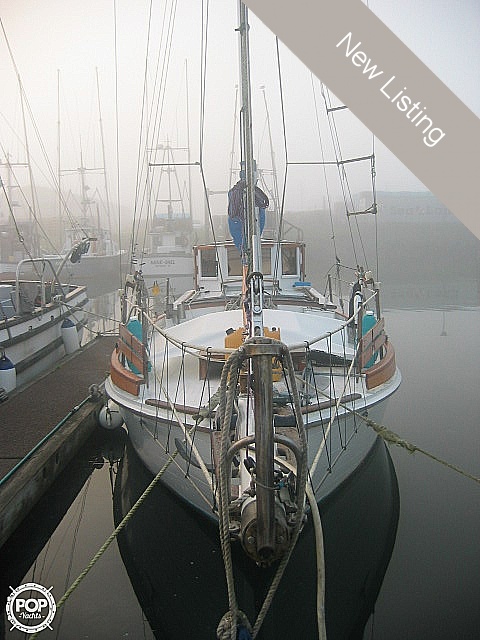
1988 Homemade 38
Coos Bay, Oregon
Make Homemade
For you traditionalist's out there, Read on This Sailboat was built by a man with passion and a vision to create a classic, traditional sailboat from the George Buehler stable( Great bear).Elmer worked for the forestry and put 10 years of labor and love into her before passing. Tom Tallman purchased and re-powered and fitted taller aluminium mast and rigging and was 'gutted' selling her. Current owner purchased in 2005 and loves her strong construction, sea kindle-ness, taller mast in light airs and young boat with traditional style. Hard Chine construction. Topsides have conventional carvel plank on frame construction, w/ a large fir chine timber, below chine there is a diagonal stave planking running between chine + keel. Staves are well bedded in 3M 5200 rubber sealant. Double ender wood hull. The Hull took 10 years to build. Port Oxford cedar; Cap-rail, bulwarks siding. Stanchions + Samson post are Pacific yew. Douglas Fir; covering boards, chine timber 2" thick, 2-3/4" thick fir floor timbers, sawn fir knees under ends of deck beams. Backbone structure is steel bolt fastened. Decking material: Laid planked Douglas Fir VG old growth w/galvanized steel wood screw fastenings. Ceiling 1/2" thick yellow cedar fastened down w/steel nails. Long cast cement keel. (cement keel has encased in case hardened steel tractor tread steel pins to have more weight for volume.) Internal pig iron added to extended seats + lead ingots under bunk, approx
Narrow Results
Current search reset all.
- Keyword: double ender sailboat
- Homemade (1)
- Roughwater (1)
- Sakonnet (1)
- Southernsail Skiffie (1)
- Daysailer Sailboats (1)
- Florida (2)
- Louisiana (1)
- South Carolina (1)
- Tennessee (1)
- Search Title Only
- Has Picture
- Include Sold Listings
Showcase Ads

1986 Mako 254
East Yaphank, NY

2015 NauticStar 2200 Coastal
Houston, TX

2013 Four Winns H233
Augusta, GA

2005 Crownline 316 LS
2015 Sea Hunt Ultra 235 SE
Chicago Heights, IL

2003 Grady-White Marlin 300
Harrison Twp, MI

2011 Yamaha SX 210
Mesquite, TX
Create Alert
Please, name this search
Select Interval
Alert Successfully Created
Better Sailing

Best Sailboats With 2 Cabins
The passion of living and voyaging overseas is difficult to explain to people that can’t live without their basic needs and additional comforts. But if you choose the right sailboat tailored to your needs and preferences you might be able to live on a sailboat and have more comforts than expected. Choosing a well-designed, robust, spacious, and seaworthy sailboat is the key to successful passagemaking. So, are you looking to accomplish your dream and sail overseas with a 2-cabin sailboat? Then, continue reading this article. I’m going to list the best 2-cabin sailboats to live on and travel overseas as well as their characteristics. Follow me!
Island Packet 35
The full-keel IP 35 with a high-freeboard hull design still proves her value and is one of the best choices amongst sailors. The beamy IP 35 has a robust construction, spacious interiors and great amenities that make her a great cruising sailboat. The IP 35 was firstly introduced in 1988 and has a comfy and roomy interior as well as a large cockpit, and an easy-to-handle cutter rig with a jib boom. Even though she’s not the fastest boat upwind, she can perform well in trade winds. All these features make the IP 35 a good option for family cruising. Lastly, she can cruise on long-passages and as for her price, you can find a well-maintained used model with approximately $75,000.

>>Also Read: Best Sailboats Under 100k
Catalina 30
The Catalina 30 deck forms a very functional boarding space. Even though they first appeared on the market in 1972 they still continue to sail in the seas. Furthermore, these reliable fiberglass models are the most common ones in terms of production. The galley of Catalina 30 has large counter space and two private double cabins, one forward (V-berth) and one aft. The forward cabin is a V-berth formation. Also, the sofa converts and forms two more berths on the starboard side. It is possible to find a good and properly maintained Catalina 30 with the price of $15,000.

>>Also Read: Best Sailboats Under 30 Feet
The old-time classic Pearson 34 will give you the appropriate space you need in order to sail for a long time offshore. She has spacious accommodations and is easy to handle making her ideal for enjoying the joys of cruising. Her aft sections are full which increases sail carrying power and her forward sections are moderately full so as to provide buoyancy. A classic arrangement plan is used for the below decks resulting in the best use of space.
Oceanis 311
The Oceanis 311 is a practical and roomy high-performance cruiser and racer. She can accommodate 6 persons and has 2 cabins placed below her deck. The accommodation layouts have a double-berth cabin on the port side aft and a double V-berth in the forepeak. The galley and WC are situated on the port side, the small navigation area is situated on the starboard, and the table on the centreline. As for the headroom, it’s around 6 ft. The boat doesn’t have a convertible saloon but has a convertible settee which forms two single berths. Lastly, the 311 combines appropriate internal volume and a fast hull, making it ideal for long offshore passages.
Beneteau First 31.7
This sailboat has achieved the right balance between sailing performance and accommodation. This family of Beneteau’s First sailboats designed by the Finot Group is highly appreciated among sailors for their resistance and high-performance. The First 31.7 features a high freeboard, a self-bailing cockpit, and a wide transom. Her design is simple and efficient, provides enough room for provisions which makes it great for long passages. Moreover, the 31.7 model is the more compact design of the Beneteau First 40.7 model. Its large beam provides plenty of interior volume with a simple layout of 2 cabins and one head. The main cabin is in the V-berth forward and has approximately 6ft of standing headroom. The galley is situated to the port side and includes a sink, a stove, and a refrigerator. Aft of the boat is the second private cabin with standing headroom and a double berth.
Hallberg-Rassy 310
The Hallberg-Rassy 310 is a fast and easy-going boat with her simple design and her robust GRP construction which makes her great for ocean cruising. She is a 30ft monohull sloop and features a deck steeped mast configuration. Furthermore, it has a spacious and comfy interior including 2 cabins, enough space for storage, and an L sofa with a straight settee. You can find a properly maintained used Hallberg-Rassy 310 with approximately $160,000. She’s definitely included on our top list of 2-cabin cruisers/racers!

>>Also Read: Best Sailboats to Live On
Moorings Beneteau 38.2
This exceptionally designed monohull is proven to be seaworthy, stable, and reliable for overseas sailing. Her hull design ensures excellent performance even under strong winds due to her wide beam towards the stern construction. Furthermore, she has a large cockpit area that facilitates walking, relaxing, and dining on the deck. Her interior is equipped with two cabins and two bathrooms and has space to accommodate from 6 to 8 persons. The galley has all basic amenities such as a refrigerator, an oven as well as extra seating and countertop space. She is one of the sailboats that provide more than enough amenities for a long offshore sailing and she definitely worths the investment!
Peterson 44
The Peterson 44 is one of the best center-cockpit cruisers that can sail well in any wind, and she’s ideal for overnight cruising or day sailing. The sailboat has a split-cabin both fore and aft and a generally roomy and comfy interior without putting aside its excellent sailing capabilities. Through the passageway, to starboard and back, is the aft cabin, with a double berth and separate head with shower. The traditional main cabin is situated forward and includes a dinette to port and settee to starboard. Moreover, there’s a second head with a shower and a large V-berth. All these amenities and space combined with this seaworthy and easy-to-handle sailboat can’t let me without putting her on our list. On today’s market, you can find her from $100,00 to $125,000.
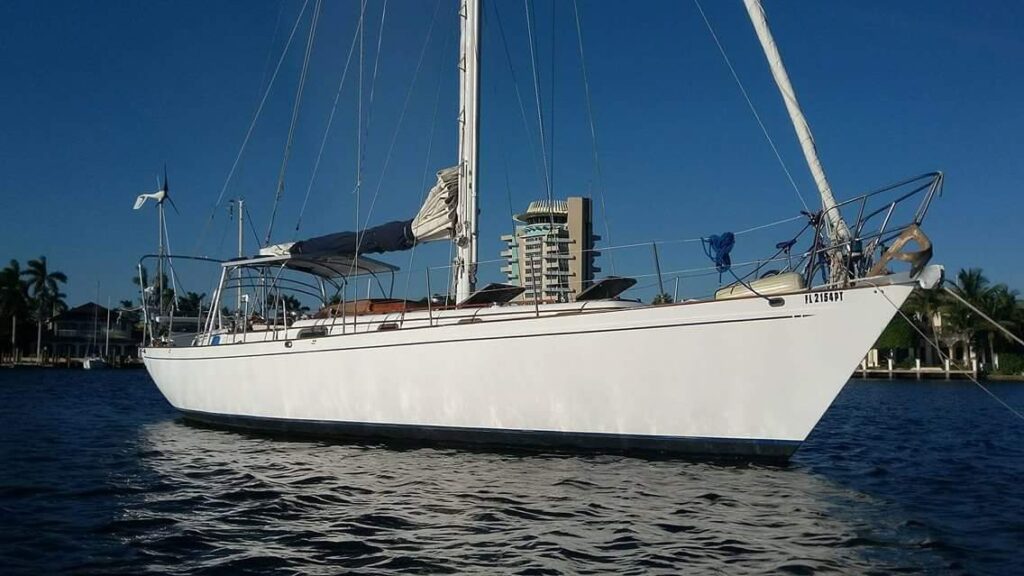
The ideal high-sided family cruiser that ensures easy handling, speed, and comfort. With a large cockpit area, a practical walk-through transom, and with spacious interior/outdoor areas, you can enjoy your days sailing overseas. Moreover, she has dual-ended mainsail sheeting and the headsail sheet winches are adequately placed to the helm. The sheets are well built into the companionway bulkheads so as to facilitate the control of halyards and furling lines led aft to the cabin top. The galley and saloon areas are large enough to cook and relax and both cabins are bright and spacious. Lastly, she’s quick and quite responsive while sailing and adequate for coastal cruising with your whole family!
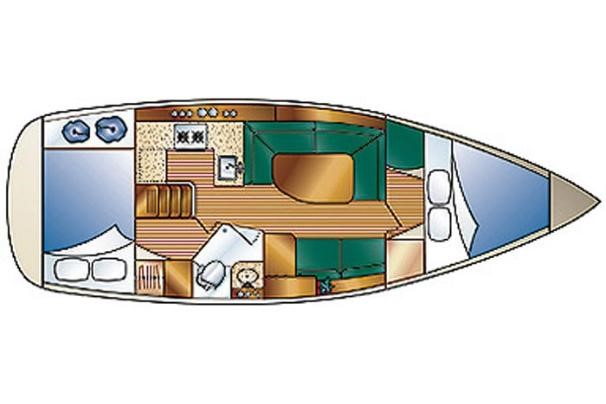
>>Also Read: Best Small Sailboats To Sail Around The World
Bavaria C42
This modern and innovative Bavaria C42 won’t let you down in terms of sailing performance and offshore sailing. Her V-shaped bow hull shape with chines, the large amount of space, and robust construction are the characteristics that make this model one of the best 2-cabin boats on our list. Better performance is achieved due to the chines that ensure stability and direct feeling while steering. Also, the foredeck and side decks have enough space for a sailboat of this size and the hull design creates extra space below the deck. So, there’s everything in the Bavaria C42; 2 luxurious cabins with a bathroom, a roomy saloon with a lounge bench, extra headroom in the bow cabin, and generous storage capacity. You’ll definitely appreciate her design and sailing performance and she’ll certainly prove her worth!
These are some great 2-cabin sailboats adequate for either offshore sailing or just for coastal cruises with your friends and family. Again, everything depends on your needs, preferences, and budget when you’re planning to buy a new or used yacht. So, you need to consider everything before buying a 2-cabin sailboat. Your crew members, your routes, your budget, comfort needs, amenities and sailing performance. There’s a wide variety of different options out there to choose from and you’ll definitely find what you’re looking for. Bon voyage!
Peter is the editor of Better Sailing. He has sailed for countless hours and has maintained his own boats and sailboats for years. After years of trial and error, he decided to start this website to share the knowledge.
Related Posts

The Ultimate Guide to Choosing the Best Fishing Line for Trolling

Lagoon Catamaran Review: Are Lagoon Catamarans Good?

Best Inboard Boat Engine Brands

Are O’Day Sailboats Good? A Closer Look at a Classic Brand
- Buyer's Guide
- Destinations
- Maintenance
- Sailing Info
Hit enter to search or ESC to close.
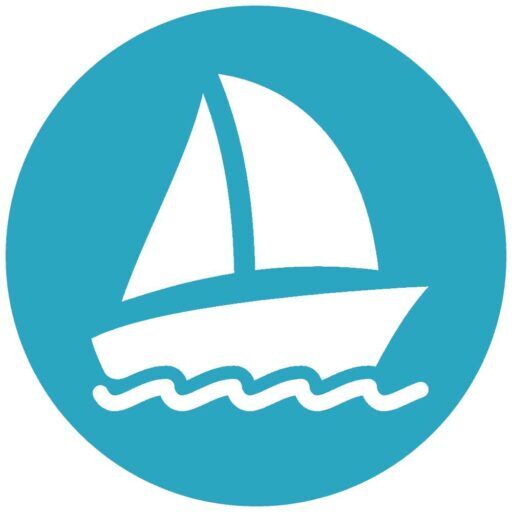
WaterCraft 101
Your guide to fun on the water!
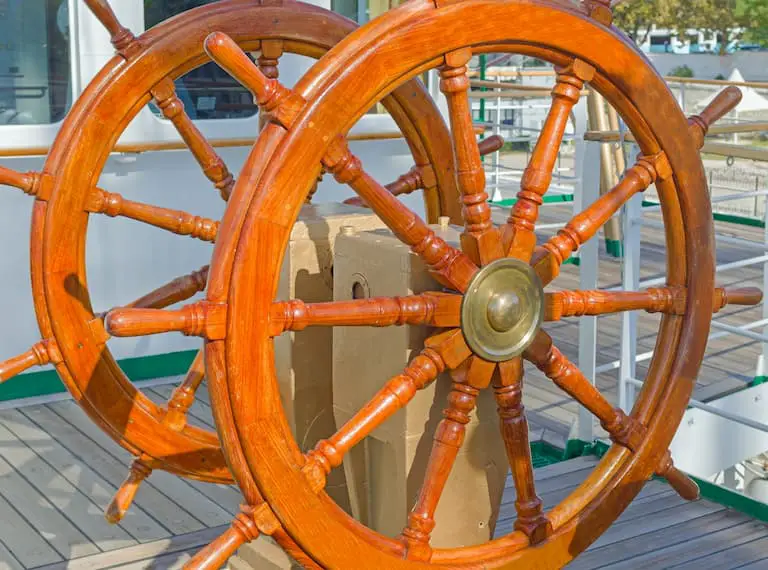
Why Some Sailboats Have Two Helms (Dual Helms Explained)
While most sailboats have a single helm with a steering wheel in the center, some larger sailboats or racing boats may have two helms. So, why do these sailboats have double helms? Are there any practical benefits of two helms on sailboats?
Some larger sailboats have two helms as it helps with steering from different angles and can make handling a larger sailboat much easier. Racing sailboats have two helms to execute tight turns at faster speeds. However, some sailboats have two helms for aesthetic purposes.
This article will explore the practicality of a sailboat having dual helms, whether it’s necessary and whether a sailboat or yacht with two steering wheels has better handling. It will also look at why some smaller sailboats have twin helms.

Table of Contents
Why Do Large Sailboats Have Two Helms?
While smaller sailboats will often have a single large steering wheel in the boat’s center, larger boats often have two smaller helms. Usually, one helm is located on the starboard side and the other on the port side.
Large sailboats have two helms because it helps give more control over the boat. A double helm also allows sailors to see both sides of the jib, giving them more visibility when controlling sailboats with bigger hulls.
Sometimes a large hull or other objects can block your vision on one side when sailing. This is much more of a problem on larger sailboats since they have a larger hull. Having a separate steering wheel on either side of the jib can give you more vision and may help you steer the boat in poor visibility.
Some large sailboats may have two rudders controlled by separate helms. Depending on the wind speed and other weather conditions, you may prefer to use a certain wheel. This helps steer larger boats in areas where you have to make tighter turns.
So, while smaller sailboats typically have one centered helm, larger ones will often have two for better steering options.
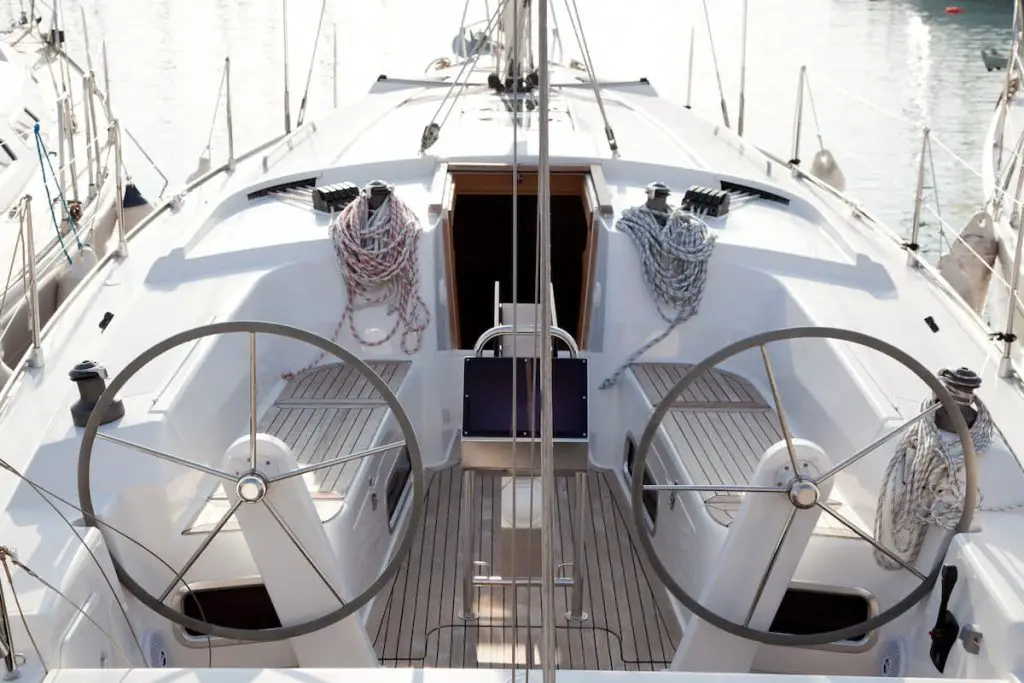
Why Do Racing Sailboats Have Two Helms?
Racing sailboats have two helms because it helps them navigate tight turns at higher speeds. Having two helms is advantageous in shifting weight in competitions where the margin for error is low.
Despite being lighter and smaller than some cruise sailboats, racing sailboats will have two helms. In a typical sailboat race, the crew will constantly shift sides to navigate obstacles and turns without compromising on speed. A double helm is beneficial in such cases as it allows for weight shifting and tighter steering control.
The double helm design became popular in sailboats, and many smaller cruise boats copied the design, even though it may not be practical when cruising.
Do Two Helms Help With Steering on a Sailboat?
It’s not only large sailboats and racing boats that have twin helms. Many smaller sailboats also feature a double helm design, even though both wheels control a single rudder. So, does having two helms always improve the steering?
Two helms may help steer large sailboats, but they are used more for aesthetic appeal on regular cruising sailboats. A double helm makes the boat look more like a racing sailboat, even though they provide no practical use in smaller cruising boats.
So, if your cruise boat has two steering wheels that control a single rudder, the only advantage is increased visibility. However, some boat experts recommend having a single wheel on cruising boats as it is much easier for beginner sailors to control.
Which Is Better: A Single or Double Wheel Sailboat?
Single and double helm sailboats both have their benefits and drawbacks. Single wheel boats are easier to handle and more beginner-friendly, while bigger sailboats with two steering wheels can make tighter turns at high speed.
However, quite a few factors will determine whether a sailboat needs a single or double wheel. These factors include control, maneuvering, and safety.
Dual Helm Control
A single-wheel boat is generally better in normal circumstances when it comes to having greater control. It helps you position the boat relatively straighter, allowing you better management of the boat with minimal effort.
However, a double-wheel sailboat is much more effective in controlling the boat in rough weather. The wheels are usually placed high up on the boat, and you can use wheels on different sides of the centerline for better steering control.
Double Helm Maneuvering
A double helm boat is much easier to maneuver and can cut sharp turns at higher speeds than a single helm boat. This is more effective in racing sailboats, but many cruise sailboats have this feature for better speed control. If you’re going at a faster speed, you’ll likely feel much more secure with two helms on the boat.
Twin Helm Safety
Some experts claim that a double wheel sailboat is safer since it gives you better control in rough weather. However, this would only be beneficial for bigger sailboats since an additional wheel won’t significantly impact the control in a smaller boat.
So, if you are looking for a bigger sailboat, try to get one with twin helms. Otherwise, single helm boats are just as effective.
Why Do Some Sailboats Have Two Sails?
In addition to having two helms, some sailboats have twin mainsails as well.
Some sailboats have two sails as it helps them go faster by increasing the sail area exposed to wind. A double sail also helps with maneuverability and can help the boat navigate right turns. Two sails are also ideal for cruising with the wind currents.
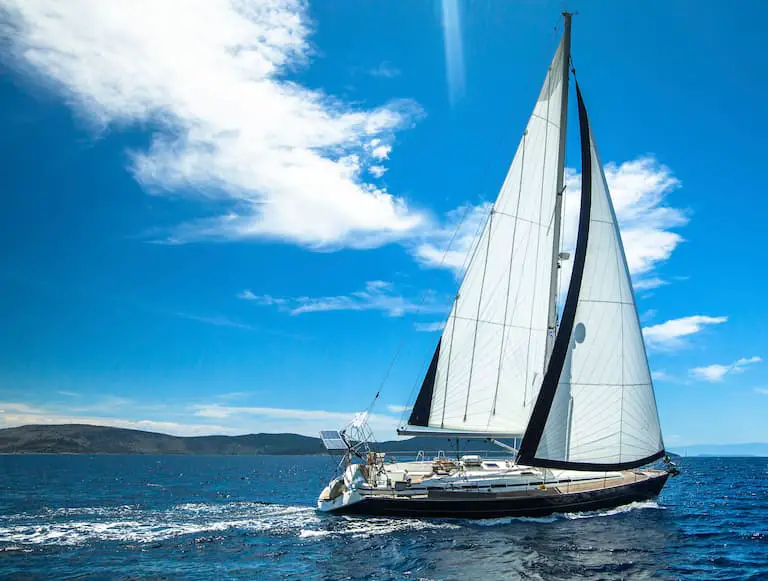
In most double mainsail boats, the two sails will be used to cruise in good weather conditions and can increase the overall speed and maneuverability of the vessel. However, handling two or more sails requires experience and skill.
Why Do Some Sailboats Have Two Helms – Conclusion
Most racing sailboats and some regular sailboats will have two helms for better speed control and maneuverability. Larger sailboats usually have two wheels for better visibility and safety. Double helms are more beneficial when navigating rough weather conditions or sailing at high speeds.
However, not all boats that have twin helms need them. Some have them to enhance the design and the second wheel has no practical purpose. If you are looking for a large sailboat or one for racing competitions, choose one with two wheels. Otherwise, a single helm boat will work just fine.
Bryan is a Las Vegas resident who loves spending his free time out on the water. Boating on Lake Mohave or Lake Havasu is his favorite way to unwind and escape the hustle and bustle of the city. More about Bryan.
Similar Posts
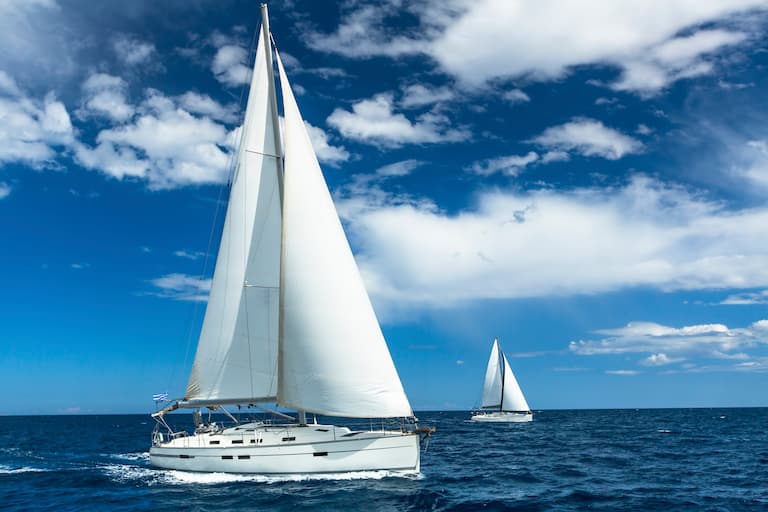
How Tight Should Sailboat Lifelines Be? (Need to Know!)
A lifeline is a safety device frequently found on sailboats and on construction sites. It’s composed of wire and stanchions, which are secured around the ship’s perimeter to prevent passengers from being thrown overboard or accidentally falling. But how tight should they be? Sailboat lifelines should be tight enough so they only stretch about two…
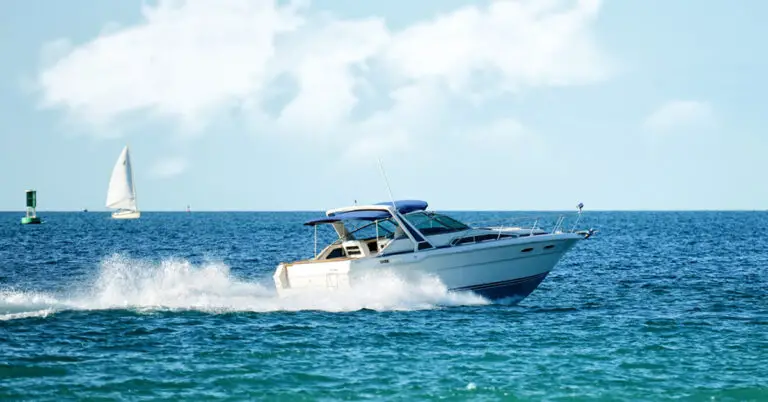
Sailboat vs. Powerboat: Which Is the Give-Way Vessel? Understanding Navigation Rules on the Water
Navigating the waters is an exciting adventure, whether you’re at the helm of a sleek sailboat or commanding a powerful motorboat. However, along with this thrilling journey comes the responsibility of understanding and adhering to the marine navigation rules, specifically those concerning the right of way or the “give-way” vessel. This aspect is vital to…
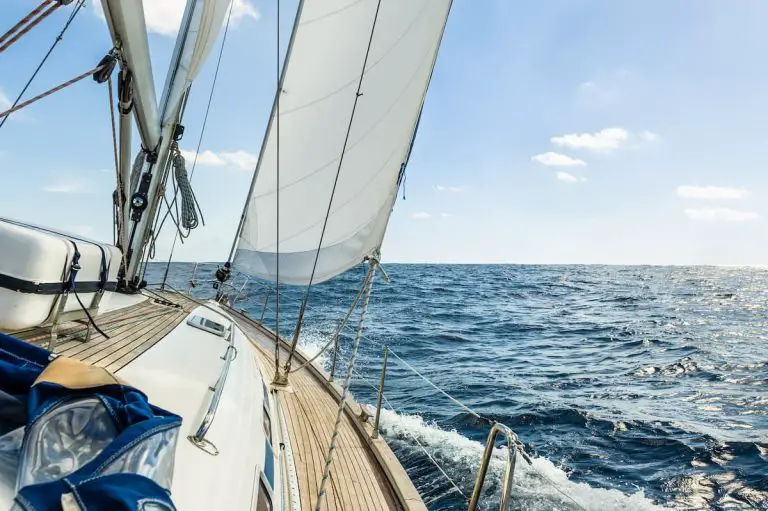
How Far Can a Sailboat Heel? (The Simple Answer)
Heeling is when a sailboat leans to one side, which can occur naturally or deliberately. When done deliberately, proper heeling enables a sailboat to travel faster. This, in turn, begs the question of how far a sailboat can heel? The optimal heeling range for sailboats varies by model and preference but usually sits between 10…
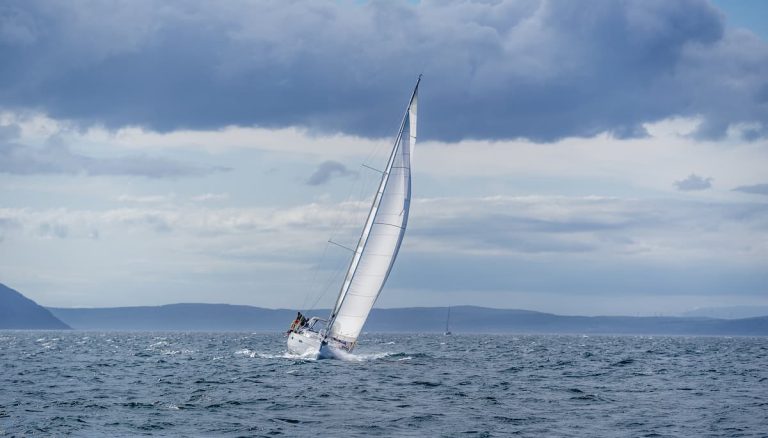
What To Do When a Sailboat Is Heeling Too Much (Explained)
Sailing is a fun activity for many people, but it comes with the innate prerequisite of being on the water rather than on stable ground. Aspiring captains must learn how to navigate and operate a boat while it rocks around in the water, which means dealing with things like heeling (i.e., leaning too far to…
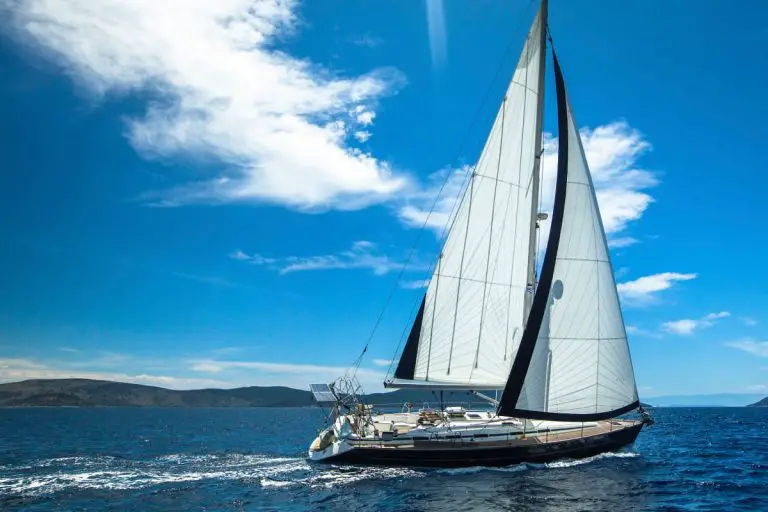
Why Do Sailboats Have Two Sails? (Explained)
If you’ve ever been sailing or watched a regatta, you’ll know that boats typically have two or more sails. It’s uncommon to see them with less than that. But what’s the reason behind this? Sailboats have two sails to improve the boat’s maneuverability, balance, speed, and ease of handling. The front sail is called the…

This page uses frames, but your browser doesn't support them.

Ordered to put his boat behind a fence, he added a mural that'll make you do a double take
O rdered to put his boat out of sight behind a 6-foot-tall fence, a Seaside resident and his artistic neighbor decided to paint a photorealistic mural of the vessel on the fence.
The idea for the little jab at City Hall was sparked a year ago when Etienne Constable received a notice from the city of Seaside requesting that he comply with a municipal code regarding parking restrictions for non-passenger vehicles, such as boats.
According to the municipal code , the boat needed to be behind a 6-foot-high fence, so it wouldn't be visible from the street.
Constable has been a resident of Seaside for 29 years and previously parked a sailboat on his property long before he put this vessel in the driveway. The 19-foot-long Arima 19 Sea Ranger, named Might as Well, has been on his property now for the last four years.
He said he was surprised and unaware of the city code about non-passenger vehicles.
"We've been here for a long time," Constable said, "and nobody had ever said anything before."
Last year, the city hired a community enhancement staffer to identify code enforcement violations throughout the city that needed to be remedied, said Nick Borges, acting city manager and Seaside police chief.
If the boat wasn't concealed, the notice stated noncompliance was punishable by a first offense of a $100 fee, according to Constable.
He started to look around his neighborhood and noticed that homes with fenced-in boats "didn't necessarily look good in my estimation," Constable said. But he didn't want to disregard the notice, either.
With a little brainstorming on how to put a creative spin on the situation, Constable reached out to his next-door neighbor, Hanif Panni, an artist who works with different mediums including murals.
Panni said he saw how upset his neighbor was by the situation, especially because Constable had to pave his driveway to install the fence.
"He kept asking for my input on the design of the mural and what it could possibly look like," Panni said.
At first they joked about having him paint a boat on the fence, a funny way to make the "eyesore" visible. Then they decided to do just that.
The feedback was almost immediate from neighbors and social media users who applauded the pair for their creativity and humor. Other neighbors have already asked Panni if he would paint their boats on their fences.
"Creativity is always a good tool to use against bureaucracy," Panni said, "if it's done thoughtfully and with the rules in mind."
Borges isn't offended by the mural, saying the creative response to the city's municipal code helped create a better relationship among neighbors.
"It does help cities like us get better" and identify whether some city codes should be enforced a certain way, he said.
Constable said he's tickled by all the positive attention the mural has gotten. He's seen drivers slow down to get a better look at it, and friends have called saying they've seen pictures of the mural online and recognize his boat.
"I've been laughing continuously for the last few days," he said. "It's just hilarious to me that so many people appreciate my sense of humor and way of looking at the work."
This story originally appeared in Los Angeles Times .

UK Edition Change
- UK Politics
- News Videos
- Paris 2024 Olympics
- Rugby Union
- Sport Videos
- John Rentoul
- Mary Dejevsky
- Andrew Grice
- Sean O’Grady
- Photography
- Theatre & Dance
- Culture Videos
- Fitness & Wellbeing
- Food & Drink
- Health & Families
- Royal Family
- Electric Vehicles
- Car Insurance Deals
- Lifestyle Videos
- UK Hotel Reviews
- News & Advice
- Simon Calder
- Australia & New Zealand
- South America
- C. America & Caribbean
- Middle East
- Politics Explained
- News Analysis
- Today’s Edition
- Home & Garden
- Broadband deals
- Fashion & Beauty
- Travel & Outdoors
- Sports & Fitness
- Sustainable Living
- Climate Videos
- Solar Panels
- Behind The Headlines
- On The Ground
- Decomplicated
- You Ask The Questions
- Binge Watch
- Travel Smart
- Watch on your TV
- Crosswords & Puzzles
- Most Commented
- Newsletters
- Ask Me Anything
- Virtual Events
- Betting Sites
- Online Casinos
- Wine Offers
Thank you for registering
Please refresh the page or navigate to another page on the site to be automatically logged in Please refresh your browser to be logged in
Orcas sink yacht in Strait of Gibraltar in latest incident of killer whales attacking boats
Two sailors on board promptly rescued by oil tanker, article bookmarked.
Find your bookmarks in your Independent Premium section, under my profile

For free real time breaking news alerts sent straight to your inbox sign up to our breaking news emails
Sign up to our free breaking news emails, thanks for signing up to the breaking news email.
A pod of orcas has sunk a sailing yacht near the Strait of Gibraltar in the latest incident of killer whales attacking boats in these waters.
The orcas reportedly started attacking the yacht , Alboran Cognac, at around 9am local time on Sunday and sank it soon after.
Spain ’s maritime rescue service said on Monday that the yacht measured about 15m in length and had two passengers onboard.
The passengers felt sudden blows to the hull and rudder before water started seeping into the vessel. They made a call to the rescue service but were quickly found by an oil tanker and transported to safety.
This was the latest in a series of attacks by orcas in the Strait of Gibraltar .
Marine experts believe it is a subpopulation of about 15 orcas known as "Gladis” that is carrying out these attacks.
They are uncertain about the motive behind the attacks, however, with theories ranging from playful curiosity to competition for prey, particularly bluefin tuna.
Despite being referred to as killer whales, orcas belong to the dolphin family. They can grow up to eight metres long and weigh up to six tonnes.
Since May 2020, when attacks by orcas on ships in the region were first reported, research group GT Atlantic Orca, which monitors populations of the Iberian orcas, has documented nearly 700 such incidents.
In November last year, the crew of a yacht called Grazie Mamma faced a 45-minute ordeal when a pod of orcas targeted the boat’s rudder, causing it to sink in the Strait of Gibraltar. The crew members were rescued safely.
At the time experts wondered whether there was a more complex reason like trauma or revenge behind the attacks.
Some researchers said it may be that the orcas like the feel of the rudder. “What we think is that they’re asking to have the propeller in the face,” Renaud de Stephanis, president at the CIRCE Conservation Information and Research in Spain, said in an interview with NPR last year.
He added that when they encounter a sailboat without its engine on, “they get kind of frustrated and that’s why they break the rudder”.
Another hypothesis suggests that the behaviour might stem from a form of revenge possibly triggered by past traumatic encounters with fishing boats.
“I definitely think orcas are capable of complex emotions like revenge,” Monika Wieland Shields, director of the Orca Behavior Institute previously told NPR.
She said she doesn’t think “we can completely rule it out”.
Additional reporting with agencies
Join our commenting forum
Join thought-provoking conversations, follow other Independent readers and see their replies
Subscribe to Independent Premium to bookmark this article
Want to bookmark your favourite articles and stories to read or reference later? Start your Independent Premium subscription today.
New to The Independent?
Or if you would prefer:
Want an ad-free experience?
Hi {{indy.fullName}}
- My Independent Premium
- Account details
- Help centre
Boat fitting description of 15-year-old girl killed in Florida hit-and-run located, victim identified

Authorities on Tuesday continued to search for the person who fatally struck a girl with a boat as she waterskied in South Florida over the weekend and identified the victim as 15-year-old Ella Adler from Miami Beach.
The Florida Fish and Wildlife Commission officials also announced officers had found a vessel that matches the boat witnesses said struck the girl Saturday.
"FWC officers have identified a vessel that fits the description and it is in their custody," a statement released by the agency reads. "The owner of the vessel is cooperating with the investigation."
The fatal crash took place in waters off Key Biscayne.
School administrator killed: Beloved Pennsylvania school director, coach killed after being struck by tractor trailer
Ella Adler was skiing when she fell in water
According to a preliminary investigation by the FWC, Ella fell in the ocean near Nixon Beach while being towed about a mile from shore and was struck by another vessel at 4:30 p.m.
"Our thoughts are with the family and friends of Ella Adler during this incredibly difficult time," Arielle Callender, a FWC spokesperson, told USA TODAY Tuesday.
The beach is in Miami-Dade County about 7 miles south of downtown Miami.
While waiting to be recovered by her boat, another vessel struck her and fled the scene, officials said. Ella, who wore a life jacket, died from her injuries.
Officials with FWC described the vessel that struck as a center console boat with a light blue hull with multiple white outboard engines and may have blue or dark blue bottom paint.
That boat did not stop and was last seen heading west from Nixon Beach, the FWC reported early Tuesday.
"The FWC and its officers have called in additional resources from other parts of the state and have worked around the clock to find the vessel involved in the accident," FWC Chairman Rodney Barreto released in a statement Tuesday after the suspect vessel was located.
Officials did not say whether anyone had been arrested or charged in connection to the fatal hit-and-run as of Tuesday.
They also did not say where or when they located the suspect vessel.
"While significant progress has been made, this investigation remains open," the statement reads.
Barreto said the agency continues to ask the public for help in the investigation.
'A star ... a force of nature'
Ella's obituary described the girl as a star.
"She was a force of nature, and when she was near, everyone felt a gravitational pull toward her," it reads.
"We are heartbroken as we say goodbye to our beautiful niece, Ella," the girl's aunt, Cristina Mas Adler, of Coral Gables, posted in a tribute Monday on Facebook. "She brought so much joy, laughter, and love into our lives. I love you Ella Bella."
"She loved to dance, she loved her friends, and most of all she loved her family," her obituary reads. "Ella was proud to be Jewish and was a member of the Ransom Everglades Jewish Students Association. She was the great-granddaughter of Holocaust survivors. She loved Israel and came from a long line of Jewish leaders with a strong commitment to faith and tikkun olam. She wore her identity proudly and loudly, just like her parents."
Ella is survived by her parents, Amanda and Matthew Adler, and her younger siblings Jaden and Adalynn, and many other relatives.
Ballerina Ella Adler 'shined in our classrooms and on our stages'
Ella, a ballerina, attended Ransom Everglades School in Miami.
"We are heartbroken," the school, where Adler studied, posted on Facebook. "Ella Adler '27 shined in our classrooms and on our stages, and she embodied the mission of Ransom Everglades School. We wish peace and comfort to her family."
$20,000 reward being offered for info leading to suspect's arrest
A $20,000 reward − $10,000 from Ella's family and a combined $10,000 from FWC and Miami-Dade Crime Stoppers − is being offered for information leading to the arrest and successful prosecution of the hit-and-run suspect.
Anyone with information about the case is asked to contact those agencies.
Natalie Neysa Alund is a senior reporter for USA TODAY. Reach her at [email protected] and follow her on X @nataliealund.
Orcas have sunk another vessel off the European coast. Why won't they stop ramming boats?
The orcas are at it again: for the seventh time in four years, a pod of whales has sunk a boat after ramming it in Moroccan waters off the Strait of Gibraltar.
The 15 metre-long yacht Alborán Cognac, which carried two people, encountered the highly social apex predators at 9am local time on Sunday, Spain's maritime rescue service said.
The passengers reported feeling sudden blows to the hull and rudder before water started to seep into the sailboat. It is not known how many orcas were involved.
After alerting rescue services, a nearby oil tanker took them onboard and carried them to Gibraltar on Spain's southern coast.
Nothing could be done to save the sailboat, which drifted and eventually sank.
It's the latest incident in what has become a trend of hundreds of interactions between orcas and boats since the "disruptive behaviour" was first reported in the region in May 2020.
The origin of this new behaviour has baffled scientists, though the leading theory suggests this "social fad" began as a playful manifestation of the whales' curiosity.
Where have orcas interacted with boats?
The latest data from the Atlantic Orca Working Group (GTOA), an organisation that contributes to the animals' conservation and management, shows that there have been at least 673 interactions since 2020.
GTOA defines interactions as instances when orcas react to the presence of approaching boats with or without physical contact.
The map below shows the highest numbers of encounters from April to May 2024 took place off Spain's southern coast in the Strait of Gibraltar (red zones), with some lesser activity in surrounding areas (yellow zones).
A 2022 peer-reviewed study published in the Marine Mammal Science journal found the orcas in these areas preferred interacting with sailboats — both monohulls (72 per cent) and catamarans (14 per cent) — with an average length of 12 metres.
A clear pattern emerged of orcas striking their rudders, while sometimes also scraping the hulls with their teeth. Such attacks often snapped the rudder, leaving the boat unable to navigate.
"The animals bumped, pushed and turned the boats," the authors of the report said.
Adding this week's encounter, there have been seven reported cases of orcas damaging a boat so badly that it has sunk, though the people onboard were rescued safely each time.
In June 2023, a run-in with the giant mammals in the Strait of Gibraltar forced the crew competing in The Ocean Race to drop its sails and raise a clatter in an attempt to scare the approaching orcas off.
No-one was injured, but Team JAJO skipper Jelmer van Beek said that it had been a "scary moment".
"Three orcas came straight at us and started hitting the rudders," he said.
"Impressive to see the orcas, beautiful animals, but also a dangerous moment for us as a team ... Luckily, after a few attacks, they went away."
After analysing 179 videos and photos of these types of interactions, which lasted on average 40 minutes, researchers concluded there was no reason to classify the events as intentionally hostile behaviour.
"The behaviour of orcas when interacting with boats is not identified as aggressive," they said.
"One of their main motivations has been identified as competition with boats for speed."
Still, the researchers of the study admitted they were not sure what triggered the novel behaviour in 2020.
"We are not yet certain what the origin of these interactions is, but it is still suspected that it could be a curious and playful behaviour," they wrote.
"[The behaviour] could be self-induced, or on the other hand it could be a behaviour induced by an aversive incident and therefore a precautionary behaviour."
Are the same orcas responsible for these incidents?
Out of around 49 orcas living in the Strait of Gibraltar, GTOA researchers found a total of 15 whales from at least three different communities participated in the unusual interactions with boats between 2020 and 2022.
Most of those that engaged with greater intensity were juveniles, though it's unclear if others have since joined the group.
These giant mammals, which belong to the dolphin family, can measure up to eight metres and weigh up to six tonnes as adults.
The director of the Orca Behaviour Institute, Monika Wieland Shields, has said there is no evidence to prove the theory these whales were seeking vengeance against humans for a past trauma.
"While I'm sure it feels like an attack for the people on board, for the whales themselves, it really looks more like play behaviour," she said.
"There's something intriguing or entertaining to them about this [boat rudder] mechanism and they're just showing a lot of curiosity about it."
Ms Wieland said it's likely this new behaviour spread through the population as a kind of "social fad".
"Orcas are highly intelligent, very social animals, and with that comes a tendency to be curious about and explore your environment," she said.
"One thing that we see are these kind of fad behaviours that will appear in a certain population.
"One whale discovers something, they find it entertaining or interesting, or fun — it's some type of game. And then they will teach that to other members of their family group."
Are orcas dangerous to humans?
While orcas have earned their fearsome reputation for preying on other marine animals, there is no record of them killing humans in the wild.
In captivity, orcas have killed four people since the 1990s, though it's unclear whether the deaths were accidental or deliberate attempts to cause harm.
Ms Shields said she was worried the recent interactions between orcas and boats would skew people's perceptions of these mammals.
"I am concerned that people are going to react with fear, potentially injure or shoot at some of these whales," Ms Shields said.
"We really need to educate boaters about the best things that they can do to make themselves less attractive to the whales and the best case scenario would be the whales lose interest in this and move onto something less destructive."
Spain's Transport Ministry advises that whenever boats observe any changes in the behaviour of orcas — such as in their direction or speed — they should leave the area as soon as possible and avoid further disturbance to the animals.
The ministry also states every interaction between a ship and an orca must be reported to authorities.
- X (formerly Twitter)
Related Stories
Orcas surround and nudge racing yacht off spanish coast.
Pod of orcas rams sail boat off the Spanish coast, the latest in dozens of attacks on vessels recorded this year
- Human Interest
- Mammals - Whales
- Maritime Accidents and Incidents

- Weather
Search location by ZIP code
Set sail on a tiki-themed party boat this summer in cincinnati.
- Copy Link Copy {copyShortcut} to copy Link copied!

GET LOCAL BREAKING NEWS ALERTS
The latest breaking updates, delivered straight to your email inbox.
Looking for fun summer plans?
You can set sail on a tiki-themed party boat with friends and family this summer along the Ohio River.
Cincinnati Tiki Boat is setting sail along the Ohio River starting Memorial Day weekend.
The two-hour boat tour sails along the Ohio River and can fit up to 16 people.
Riders can bring their own food and drinks. Music is provided through a Bluetooth speaker aboard the boat.
The bar features a wraparound bar counter with spaces to put drinks and snacks.
The tour starts and ends at Rivertowne Marina and stops halfway for bathroom breaks.
The tours run seven days a week, starting Memorial Day weekend through mid-October, pending weather.
The company also has a Cycleboat, a pedal wagon that floats along the Ohio River. The boat has a motor, so riders won't have to do much of the work. The boat also sets sail on two-hour tours starting Memorial Day weekend.
Riders can book a tour cincinnatitikiboat.com

IMAGES
VIDEO
COMMENTS
Multi-Hull sailing vessels pricing. Multi-Hull sailing vessels for sale on YachtWorld are listed for an assortment of prices from $41,586 on the lower-cost segment of yachts all the way up to $3,861,170 for the rare custom yachts. Find Multi-hull boats for sale in your area & across the world on YachtWorld. Offering the best selection of boats ...
1. 1976 Westerly Center Cockpit Ketch. This 1976 Westerly Center Cockpit Ketch is a small 36-foot long sailboat with two masts. This is a solidly built cruising vessel that features a center cockpit ketch layout. This boat has a small 38 horsepower engine perfectly fit to navigate its smaller size.
Sensibly no attempt has been made to create peninsula beds in the aft cabins, so despite the boat's relatively modest size both double beds measure a massive 2m by 2m. The huge stowage volumes under the bunks are easily accessed thanks to hinged top panels supported by gas struts, which enables far more of this space to be reached easily than ...
324 sq ft. D/L RATIO. 319. SA/DISP RATIO. 18.0. CAROL is in many ways my favorite pocket cruiser— a scaled-down and flatter-deadrise version of my popular FRANCES. She evokes an adventurous spirit that prevailed in the happy times of the late '70s when I designed her. At 24 feet she's as small as a prudent sailor would ever think of ...
Ideal for these Multi-Hull boats vary in length from 24ft to 76ft and can carry 4 to 64 passengers. There are a wide range of Multi-Hull boats for sale from popular brands like Lagoon, Fountaine Pajot and Leopard with 267 new and 998 used and an average price of $537,066 with boats ranging from as little as $34,604 and $3,857,722. View a wide ...
Ketch is a type of sailboat that features two masts and two sails, commonly used as a racing and cruising boat. The mainmast of this two-masted sailboat is typically taller than the mizzen mast (aft-mast). Its name derives from catch. Taller masts allow you to use larger sails, so ketch boats are able to achieve better speeds than similar boats ...
Yawl. A yawl is one of the most common types of two-mast sailboats. It has two masts: a mizzenmast and the mainmast. The mizzenmast is usually much shorter than the mainmast. This makes it an oblique type of a sailboat in the sense that the mainmast is located in the front of the boat while the mizzenmast is located in the rear past or the boat.
WITH THE SHORT, almost 6-foot headroom house, the interior of a Frances could feel much larger than you'd expect on a 26-foot boat. This is a custom WEST-system boat built in New Zealand. The Aft Head arrangement for the Frances with one seaberth and a permanent double.
Five Ocean-Going Sailboats With Two Masts. Some of the most reputable boat builders in the world favor ketch and yawl rigs. Some popular sailboats with two masts used nowadays include the Nicholson 38, the Bayfield 40, the Amel Super Maramu, the Hinckley Bermuda 40, and the Bowman 46. Let's look at each model.
The J/111 is a sleek, speedy, one-design 36 footer that is the ultimate day sailor, racer and weekender. J/111 is an easy-to-handle, comfortable sailboat that accelerates quickly, slices to windward at 7+ knots and hits double-digit speeds downwind. Performance to date in a wide variety of sailing conditions has been nothing short of remarkable.
The RS200, Hunter 15, and Hobie 16 are a few of the best 2-person sailboats. Other sailboats meant for two people include the Norseboat 17.5, Sunfish, and even a Laser SB3. These small sailboats are best geared as a beginner sailboat that compliments having two people on board. In my experience, there are plenty of small sailboat brands that ...
These sailboats have a minimum total sail area of 490 square feet, a maximum total sail area of 3,630 square feet and an average of 968 square feet. Boat Trader currently has 88 multi-hull sailboats for sale, including 27 new vessels and 61 used and custom yachts listed by both individual owners and professional boat dealerships mainly in ...
Catalina 315. nwyachting. This is a nifty pocket cruiser that raises the quality bar for solo sailors with extreme comfort and performance. With just a 9.45 meter hull, the Catalina 315 has more internal room than most classics and remains superb for solo sailing.
30. Swan 44. A strong, robust cruising boat built for high-seas, blue water adventures, the Swan 44 was designed by Sparkman & Stephens, and the yacht's well-known Finnish manufacturers, Nautor Swan, produced 76 boats in a production run that lasted from 1972-1975.
Sakonnet 23 - 23' Double Ended Sailboat (LaLa) Thi sis LaLa - the original Sakonnet 23. Designed by Joel White and built by Joe Norton III. We built the original boat that became the mold for the fiberglass Sakonnet 23 now manufactured by Edey and Duff. This is a time-proven design that we love dearly.
The site for fans of double-enders and canoe stern sailboats. Search by design, designer, and individual vessel. And add your yacht today! Skip to main content. Menu. Quizzes ... Colin Archer Finnish Pilot Boat. Corbin 35. Corbin 39. Corbin 39 CC. Crealock 34. Crealock 37. Crealock 44. CT-34. CT-37. CT-38. CT-44. CT-44 Pilothouse. Dartsailor 27 ...
one mast. triangular mainsail (called a Bermuda sail) a foresail (also called the jib) fore-and-aft rigged. medium-sized (12 - 50 ft) Fore-and-aft rigged just means "from front to back". This type of rigging helps to sail upwind. Any sailboat with one mast and two sails could still be a sloop.
A handsome, nimble and capable double-ender by legendary designer Bill Crealock, the Pacific Seacraft 34 is well proven, with scores of ocean crossings in its wake. After the boat was first launched as the Crealock 34 in 1979, Pacific Seacraft introduced a fifth model years later, a scaled-down version of the popular PS 37.
Racing double-handed provides a neat solution: fewer crew to organise and pay for and a smaller, cheaper boat to campaign. Rob Craigie and Deb Fish race the Sun Fast 3600 Bellino. Photo: Paul Wyeth
Sailboat Westsail 28' blue-water cruiser cutter double ender single hander. Cutter rigged full keel blue-water sailboat. This vessel has a 24hp Volvo MD-11c engine that is very dependable and great on fuel. Due to this engine it is registered as an antique for $6-8.00 a year registration fee.The boat is set up for single handed sailing with new ...
The galley of Catalina 30 has large counter space and two private double cabins, one forward (V-berth) and one aft. The forward cabin is a V-berth formation. Also, the sofa converts and forms two more berths on the starboard side. It is possible to find a good and properly maintained Catalina 30 with the price of $15,000.
A double sail also helps with maneuverability and can help the boat navigate right turns. Two sails are also ideal for cruising with the wind currents. In most double mainsail boats, the two sails will be used to cruise in good weather conditions and can increase the overall speed and maneuverability of the vessel.
DoubleWave is a specialty marine business focusing on the needs of Lido 14 sailboat owners. The Lido 14 is THE quintessential trailerable day sailor. Designed right here in Newport Beach in 1957, no other boat fills the needs of the casual sailor and the racing sailor as well. DoubleWave is THE leading resource for virtually all matters ...
Pontoon Boats. Whether you're sailing on an Arizona lake or an Atlantic seaboard bay, pontoon boats are a common sight. These boats don't rely on a fiberglass hull but instead float on two or ...
Ordered to put his boat out of sight behind a 6-foot-tall fence, a Seaside resident and his artistic neighbor decided to paint a photorealistic mural of the vessel on the fence. The idea for the ...
Description. On AUGUST 19, 1961 Mr. Alden Sypher of Washinton DC was signing a contract for a wonderful new MATTHEWS 42' DOUBLE CABIN MOTORYACHT. His new custom built yacht (24033) was ordered with the largerest engines possible at the time, the GM 6V53 engines that were pushing 185 hp. Planning, designing, customizing and updating over the ...
In November last year, the crew of a yacht called Grazie Mamma faced a 45-minute ordeal when a pod of orcas targeted the boat's rudder, causing it to sink in the Strait of Gibraltar. The crew ...
Boat fitting description of 15-year-old girl killed in Florida hit-and-run located, victim identified. Authorities on Tuesday continued to search for the person who fatally struck a girl with a ...
A 2022 peer-reviewed study published in the Marine Mammal Science journal found the orcas in these areas preferred interacting with sailboats — both monohulls (72 per cent) and catamarans (14 ...
Cincinnati Tiki Boat is setting sail along the Ohio River starting Memorial Day weekend. The two-hour boat tour sails along the Ohio River and can fit up to 16 people.